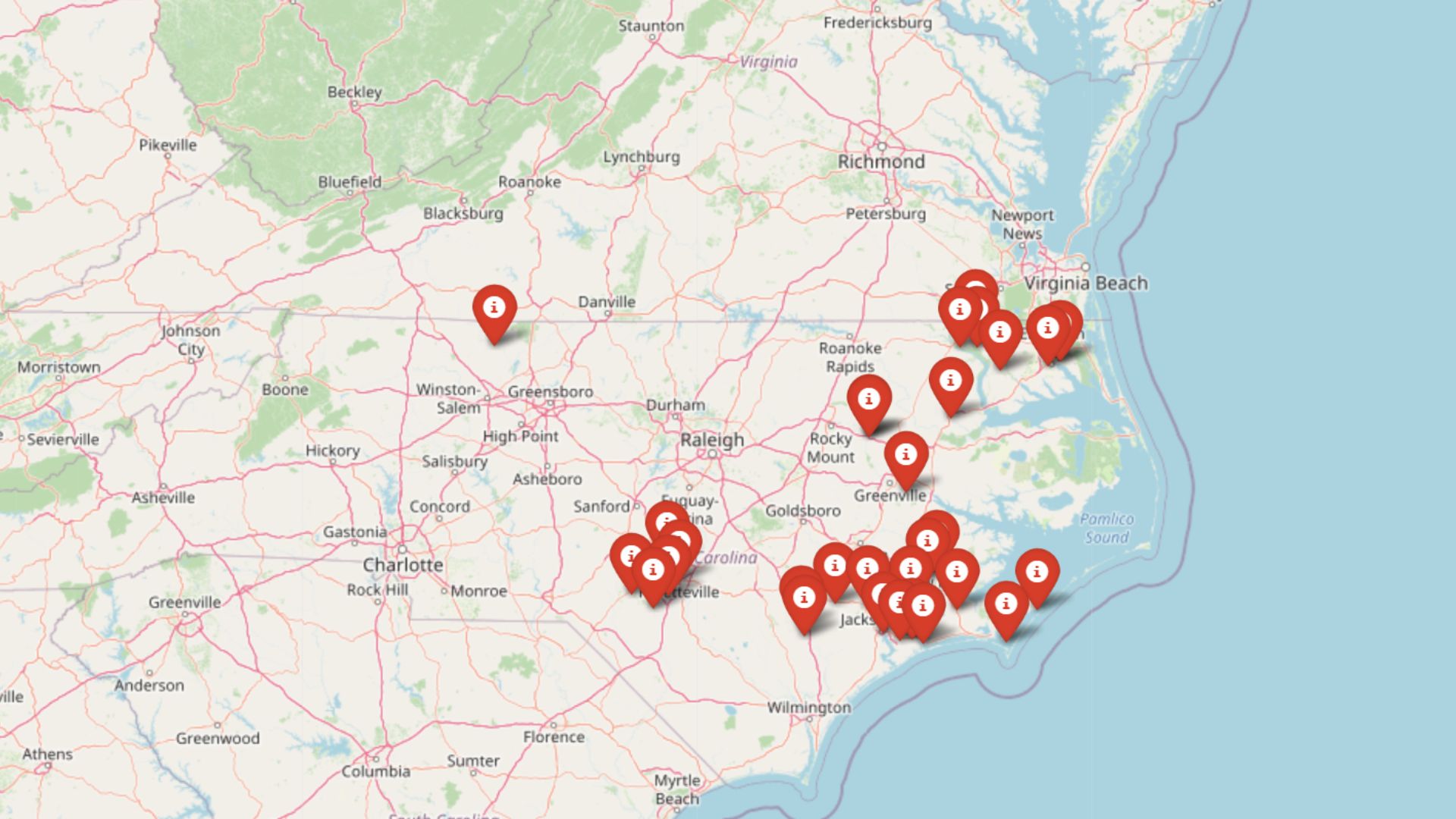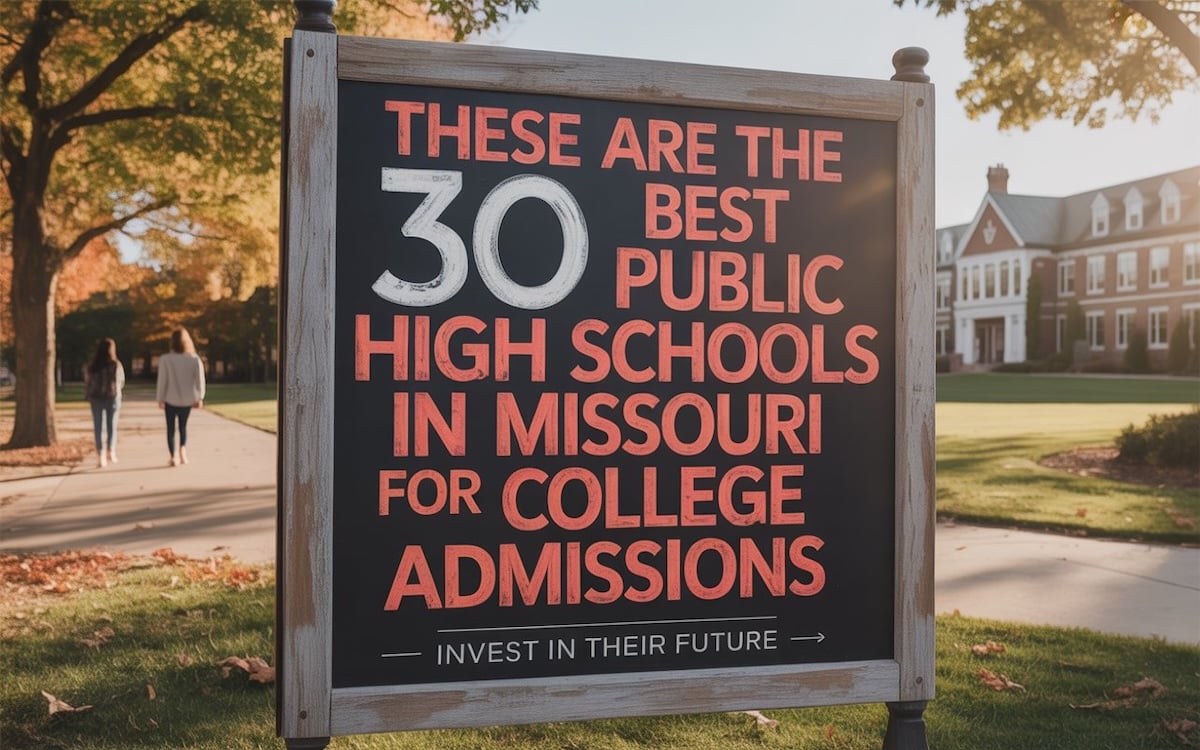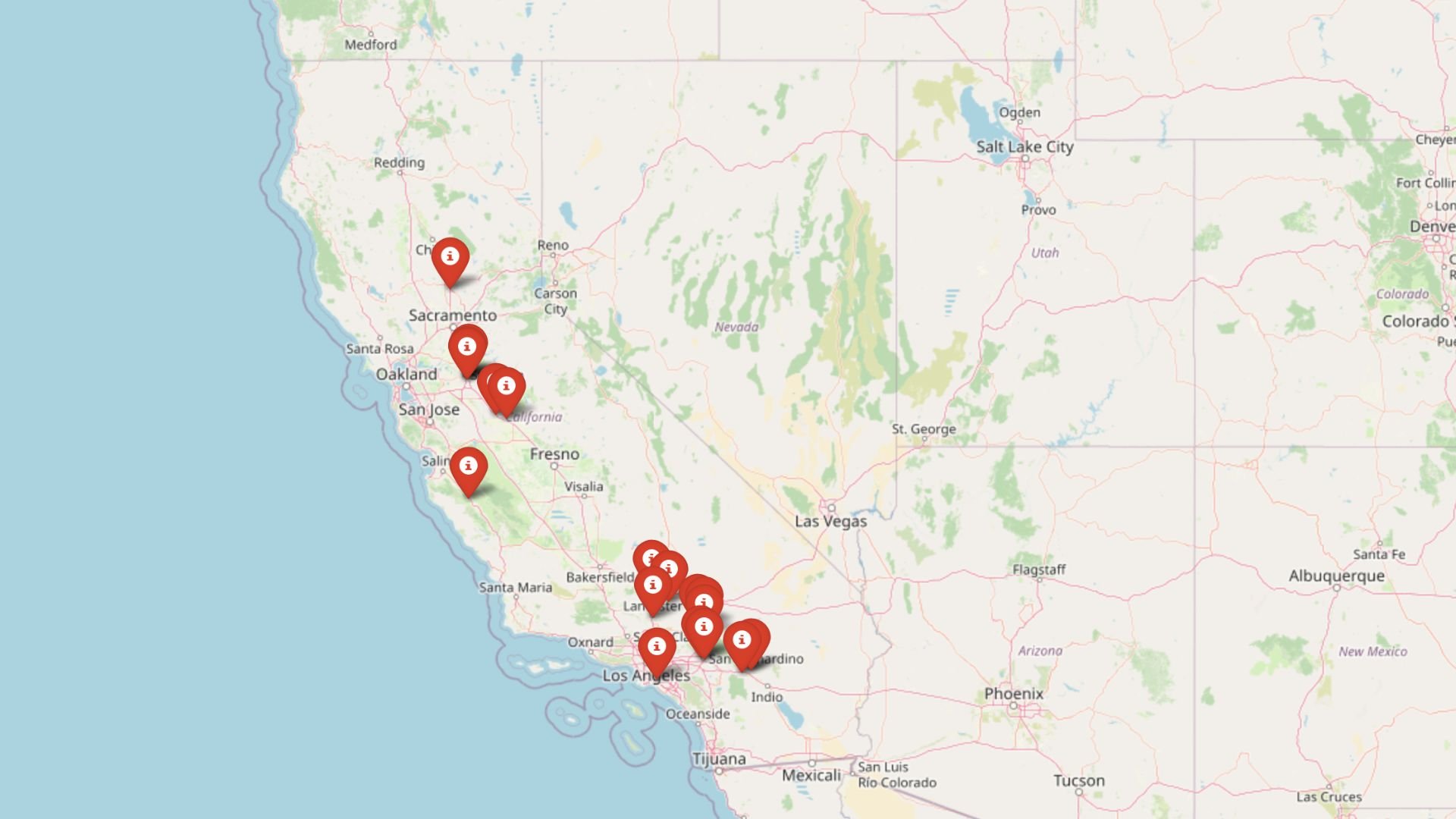
Using the latest Zillow Home Value Index data from July 2025, we’ve ranked the 30 most expensive towns in Arkansas based on current home prices. These communities represent far more than high price tags—they showcase areas of exceptional growth, desirability, and long-term investment appeal.
From affluent Northwest Arkansas suburbs powered by corporate headquarters to historic resort communities, each town tells a unique story of value creation. Whether you’re house hunting, considering investment opportunities, or simply curious about Arkansas’s premium real estate markets, this ranking reveals where home prices have reached their highest peaks and why.
30. Royal – 160% Home Price Increase Since 2010
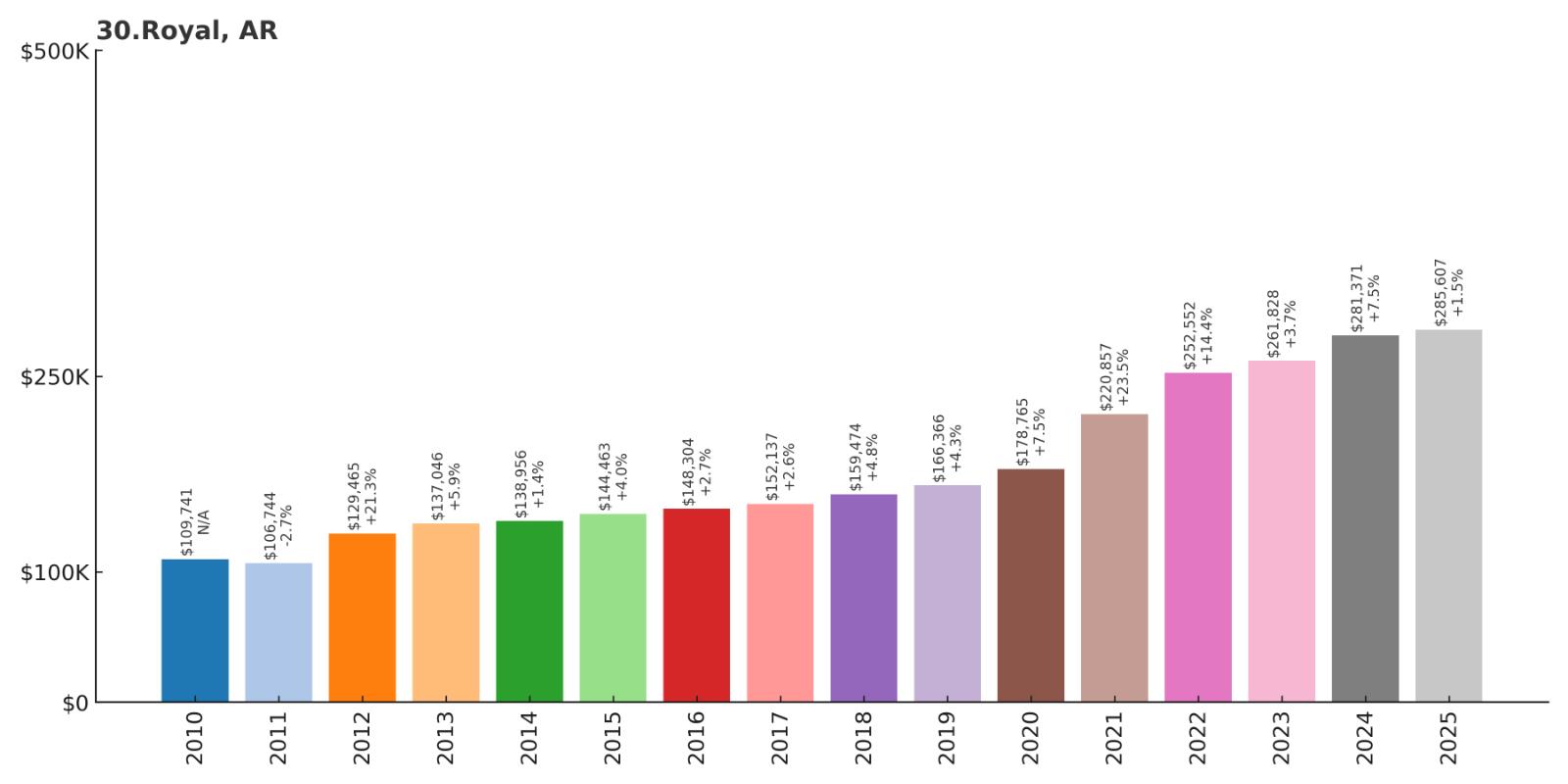
- 2010: $109,741
- 2011: $106,744
- 2012: $129,465
- 2013: $137,046
- 2014: $138,956
- 2015: $144,463
- 2016: $148,304
- 2017: $152,137
- 2018: $159,474
- 2019: $166,366
- 2020: $178,765
- 2021: $220,857
- 2022: $252,552
- 2023: $261,828
- 2024: $281,371
- 2025: $285,607
Royal achieved impressive growth with values increasing 160% since 2010, reaching $285,607 by July 2025. Starting from around $110,000, the community demonstrated steady appreciation through 2020, then accelerated during the pandemic years, reflecting its transformation from an affordable rural community into a sought-after residential destination.
Why Royal?
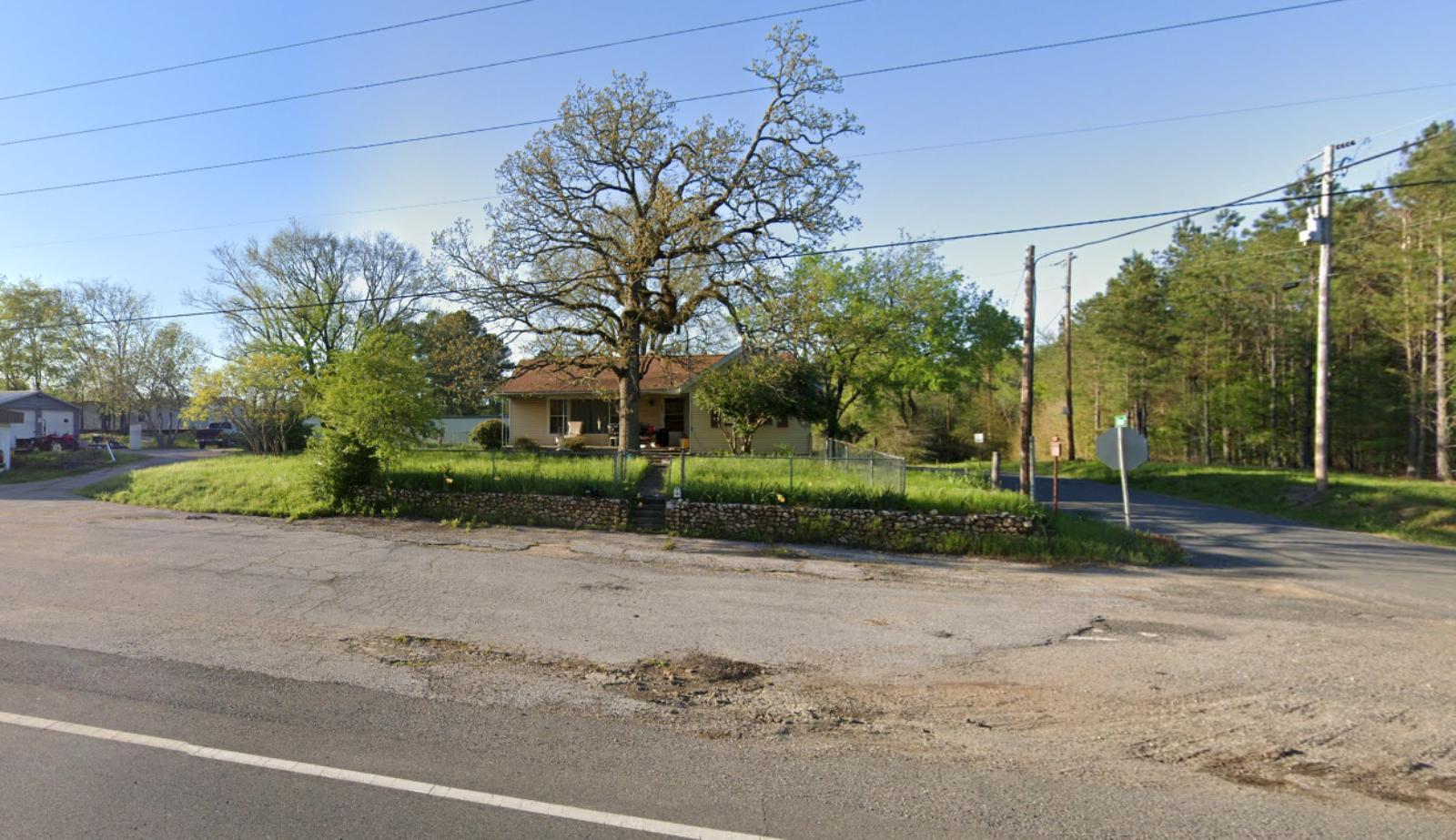
Why are people willing to pay so much to live here? What’s special about it?
Royal attracts residents seeking rural tranquility with reasonable access to Arkansas employment opportunities. The community offers small-town character, affordable housing relative to urban areas, and peaceful surroundings while maintaining convenient highway access. Families value the slower pace of life and strong community bonds.
The area’s location provides an ideal balance between rural living and urban accessibility, appealing to professionals who want affordability and space without completely sacrificing career opportunities. Royal’s development patterns emphasize preserving agricultural character while accommodating residential growth.
How Royal Rose to Prominence
Royal evolved from a small agricultural community into a desirable residential area as Arkansas’s economy expanded and lifestyle preferences shifted toward rural living. The town’s affordable housing and rural character attracted families seeking alternatives to suburban development while maintaining access to employment opportunities.
The community’s appeal grew as residents discovered its combination of affordability, rural character, and accessibility to regional opportunities. Royal’s success in maintaining its agricultural heritage while accommodating growth has established it as an attractive option for families seeking rural living with modern conveniences.
3 Interesting Tidbits
1. Rural Transformation – Achieved remarkable 160% appreciation while maintaining agricultural character and rural charm.
2. Value Discovery – Transformed from one of Arkansas’s most affordable communities into a sought-after residential destination.
3. Agricultural Heritage – Preserves connections to farming and rural traditions while accommodating modern residential development.
29. Cammack Village – 63% Home Price Increase Since 2010
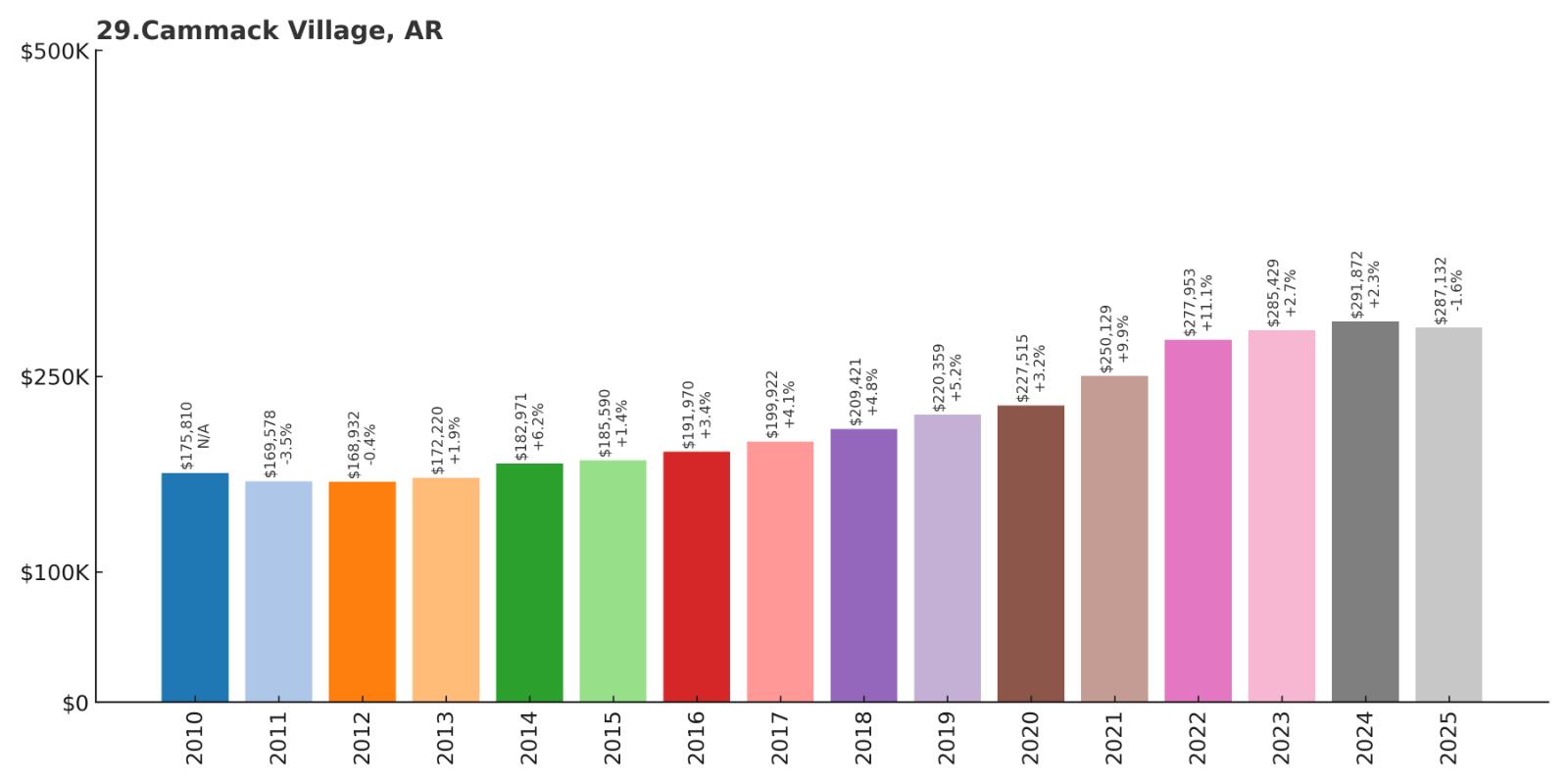
- 2010: $175,810
- 2011: $169,578
- 2012: $168,932
- 2013: $172,220
- 2014: $182,971
- 2015: $185,590
- 2016: $191,970
- 2017: $199,922
- 2018: $209,421
- 2019: $220,359
- 2020: $227,515
- 2021: $250,129
- 2022: $277,953
- 2023: $285,429
- 2024: $291,872
- 2025: $287,132
Cammack Village demonstrated steady appreciation through most of the period, with values increasing 63% since 2010 to reach $287,132 by July 2025. Starting from a higher base, the community showed consistent growth with acceleration after 2020, reflecting its established appeal as a prestigious enclave in the Little Rock area.
Why Cammack Village?
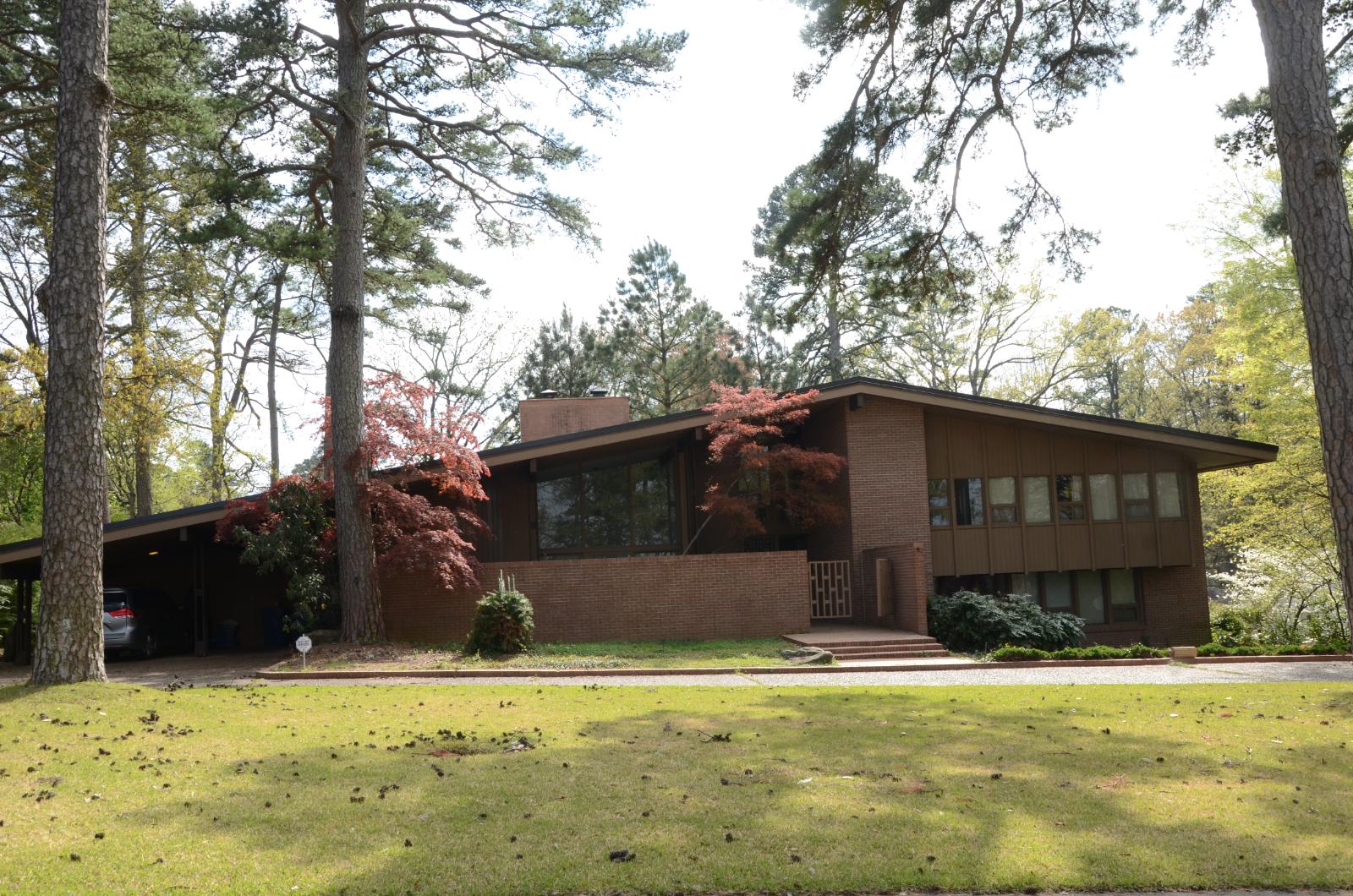
Why are people willing to pay so much to live here? What’s special about it?
Cammack Village attracts residents with its prestigious reputation and convenient location within the Little Rock metropolitan area. The small city offers upscale neighborhoods, excellent schools, and easy access to downtown Little Rock employment and amenities. Families value the exclusive atmosphere and established community character.
The community’s size and location provide urban convenience while maintaining residential character and property values. Cammack Village’s established reputation and central location make it particularly appealing to professionals seeking prestige and convenience in central Arkansas.
How Cammack Village Rose to Prominence
Cammack Village developed as an exclusive residential enclave within the Little Rock metropolitan area, attracting affluent families seeking prestigious neighborhoods with convenient urban access. The community’s small size and strategic location helped establish its reputation as a desirable address in central Arkansas.
The city’s evolution reflects successful suburban development that emphasized exclusivity, convenience, and property value preservation. Cammack Village’s reputation as a prestigious community has maintained its appeal through various market cycles and demographic changes in the Little Rock area.
3 Interesting Tidbits
1. Prestigious Enclave – Known as one of central Arkansas’s most exclusive residential communities with upscale neighborhoods.
2. Strategic Location – Positioned within Little Rock metropolitan area for maximum convenience and accessibility.
3. Established Reputation – Maintains long-standing reputation as a desirable address that attracts affluent professionals and families.
28. Gentry – 172% Home Price Increase Since 2010
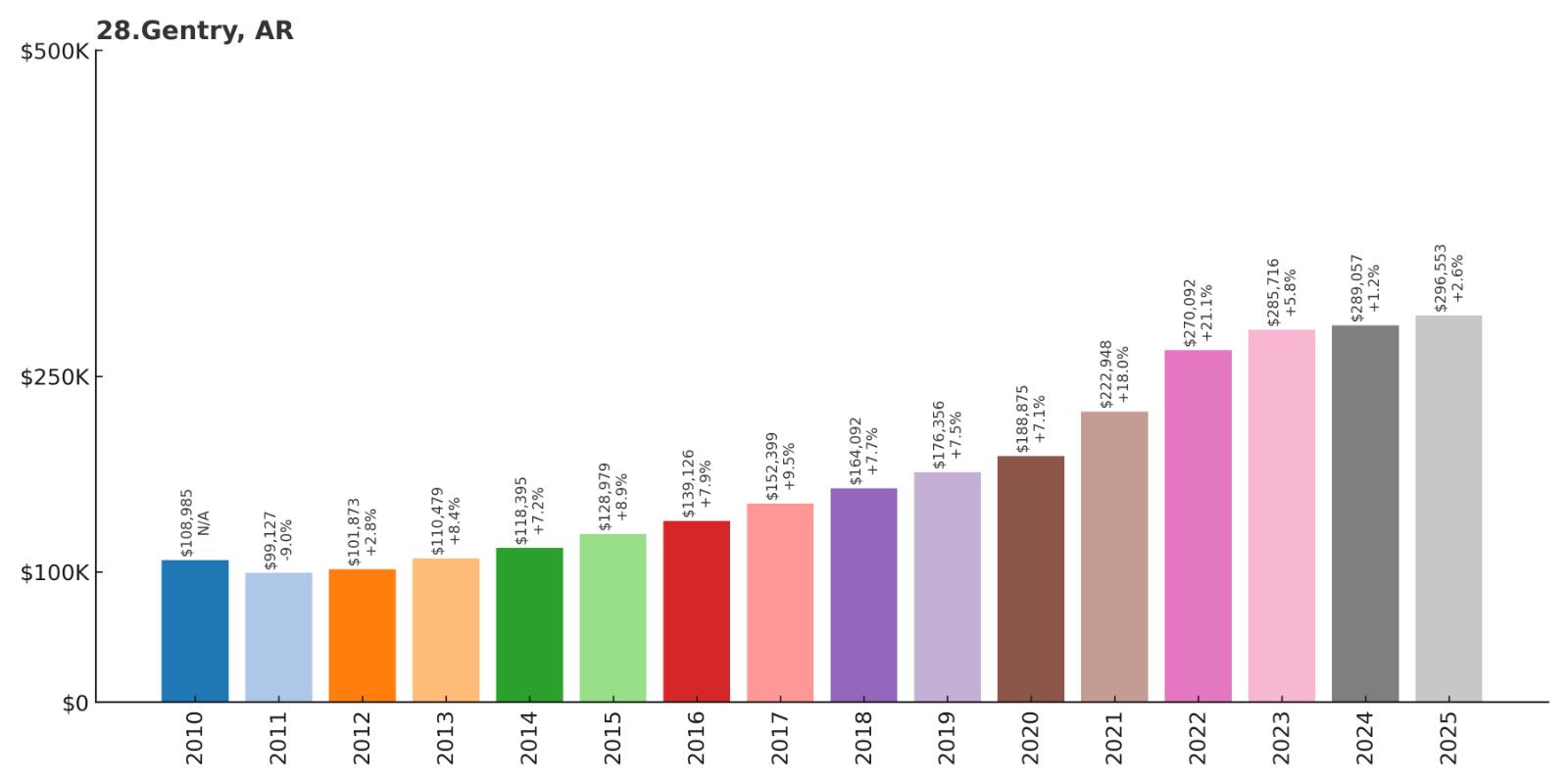
- 2010: $108,985
- 2011: $99,127
- 2012: $101,873
- 2013: $110,479
- 2014: $118,395
- 2015: $128,979
- 2016: $139,126
- 2017: $152,399
- 2018: $164,092
- 2019: $176,356
- 2020: $188,875
- 2021: $222,948
- 2022: $270,092
- 2023: $285,716
- 2024: $289,057
- 2025: $296,553
Gentry achieved remarkable appreciation with values increasing 172% since 2010, reaching $296,553 by July 2025. Starting from under $110,000, the community demonstrated consistent growth through 2020, then accelerated significantly, reflecting its transformation from an affordable rural town into a sought-after residential destination.
Why Gentry?

Why are people willing to pay so much to live here? What’s special about it?
Gentry attracts residents seeking small-town charm with growing opportunities in the expanding Northwest Arkansas region. The community offers affordable housing, friendly atmosphere, and access to regional employment while maintaining rural character. Families value the peaceful environment and strong community connections.
The town’s location provides reasonable access to Northwest Arkansas opportunities while maintaining affordability and small-town character. Gentry’s development patterns emphasize preserving community identity while accommodating growth and new opportunities.
How Gentry Rose to Prominence
Gentry transformed from a small agricultural community into a growing residential destination as Northwest Arkansas’s economic influence expanded beyond traditional boundaries. The town’s affordable housing and rural character attracted families seeking alternatives to higher-priced areas while maintaining access to regional opportunities.
The community’s strategic location and commitment to preserving small-town character while accommodating growth helped it capitalize on spillover demand from the broader Northwest Arkansas market. Gentry’s success in maintaining affordability while participating in regional prosperity has made it increasingly attractive to diverse residents.
3 Interesting Tidbits
1. Remarkable Growth – Achieved extraordinary 172% home price appreciation, demonstrating the reach of Northwest Arkansas’s economic influence.
2. Affordability Focus – Maintains relative affordability while participating in regional economic growth and development.
3. Border Community – Located near Arkansas-Missouri border, providing residents with additional opportunities and amenities.
27. Lonsdale – 92% Home Price Increase Since 2010
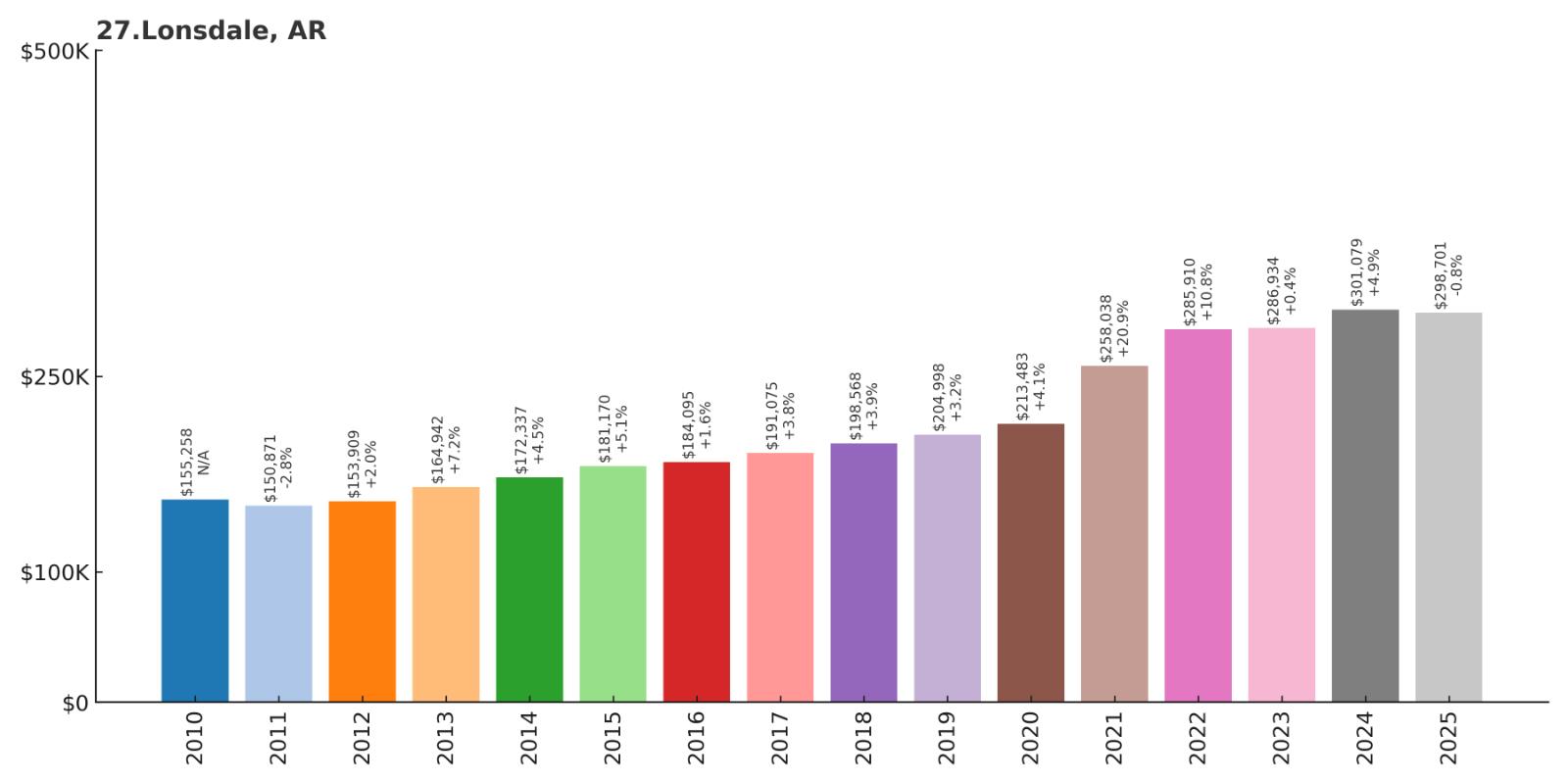
- 2010: $155,258
- 2011: $150,871
- 2012: $153,909
- 2013: $164,942
- 2014: $172,337
- 2015: $181,170
- 2016: $184,095
- 2017: $191,075
- 2018: $198,568
- 2019: $204,998
- 2020: $213,483
- 2021: $258,038
- 2022: $285,910
- 2023: $286,934
- 2024: $301,079
- 2025: $298,701
Lonsdale showed consistent appreciation throughout the period, with values increasing 92% since 2010 to reach $298,701 by July 2025. The community demonstrated steady growth through 2020, followed by acceleration that reflects its appeal as a small community in central Arkansas with access to Little Rock area employment.
Why Lonsdale?
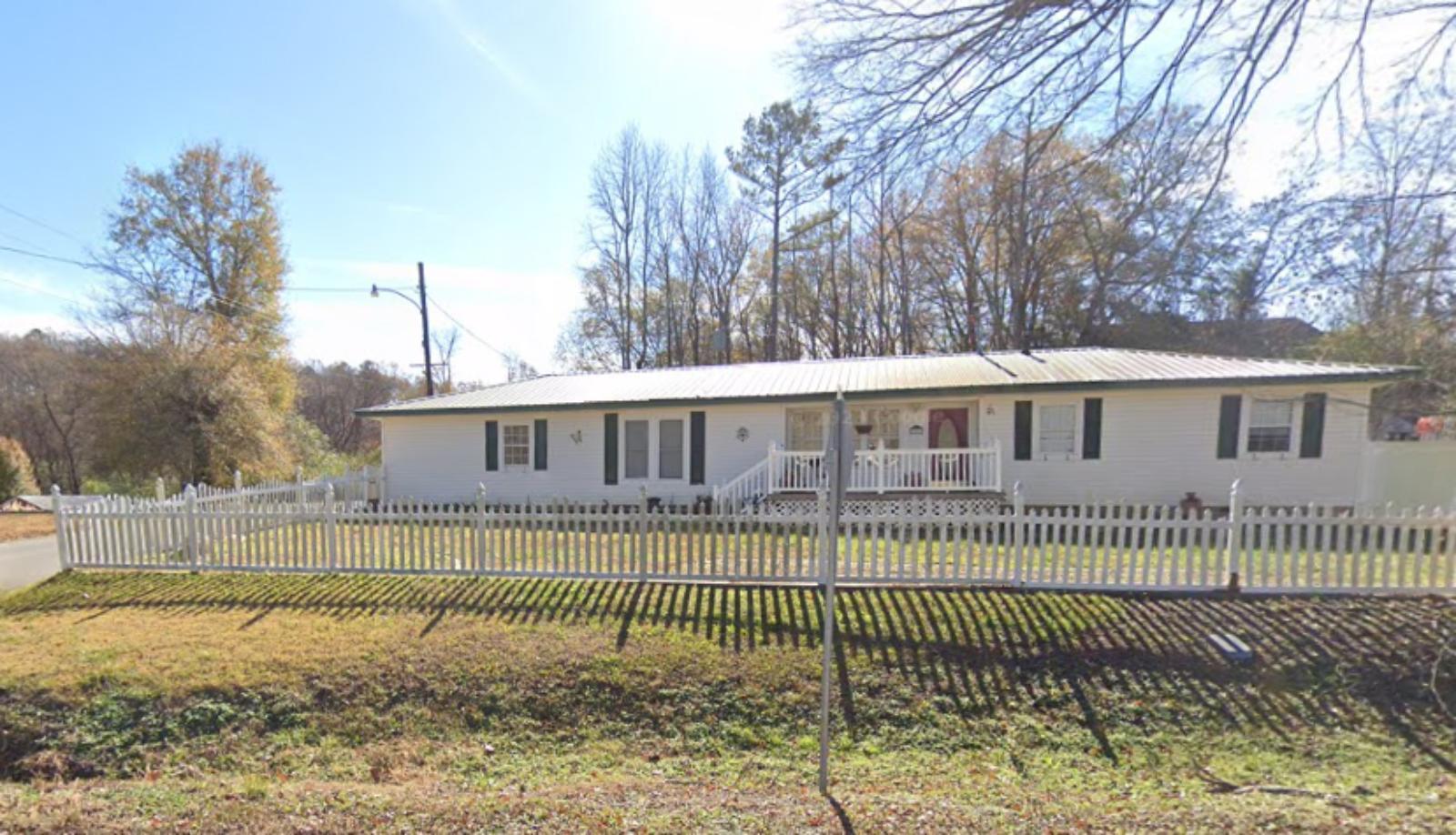
Why are people willing to pay so much to live here? What’s special about it?
Lonsdale attracts residents seeking rural tranquility with reasonable access to central Arkansas employment and amenities. The community offers small-town character, affordable housing, and peaceful surroundings while maintaining convenient highway access. Families value the slower pace of life and community connections.
The area’s location provides an ideal balance between rural living and urban accessibility, appealing to professionals who want affordability and space without completely sacrificing career opportunities. Lonsdale’s development patterns emphasize preserving rural character while accommodating residential growth.
How Lonsdale Rose to Prominence
Lonsdale evolved from a small agricultural community into a desirable residential area as central Arkansas’s economy expanded. The town’s location and affordable housing attracted families seeking alternatives to suburban development while maintaining access to employment and services.
The community’s appeal grew as residents discovered its combination of affordability, rural character, and accessibility to Little Rock area opportunities. Lonsdale’s success in maintaining its small-town identity while accommodating growth has established it as an attractive option for families seeking rural living within a metropolitan area.
3 Interesting Tidbits
1. Rural Character – Maintains small-town atmosphere and agricultural heritage while accommodating modern residential development.
2. Central Location – Provides convenient access to central Arkansas employment while preserving rural living environment.
3. Community Values – Emphasizes traditional community values and neighborly connections in a rural setting.
26. West Fork – 134% Home Price Increase Since 2010

- 2010: $128,728
- 2011: $116,662
- 2012: $118,155
- 2013: $122,216
- 2014: $127,981
- 2015: $135,226
- 2016: $149,470
- 2017: $160,060
- 2018: $172,626
- 2019: $179,849
- 2020: $188,839
- 2021: $231,306
- 2022: $276,414
- 2023: $282,460
- 2024: $300,982
- 2025: $301,753
West Fork achieved impressive growth with values increasing 134% since 2010, reaching $301,753 by July 2025. The community demonstrated steady appreciation through 2020, then accelerated during the pandemic years, reflecting its appeal as an affordable option within the greater Northwest Arkansas market.
Why West Fork?
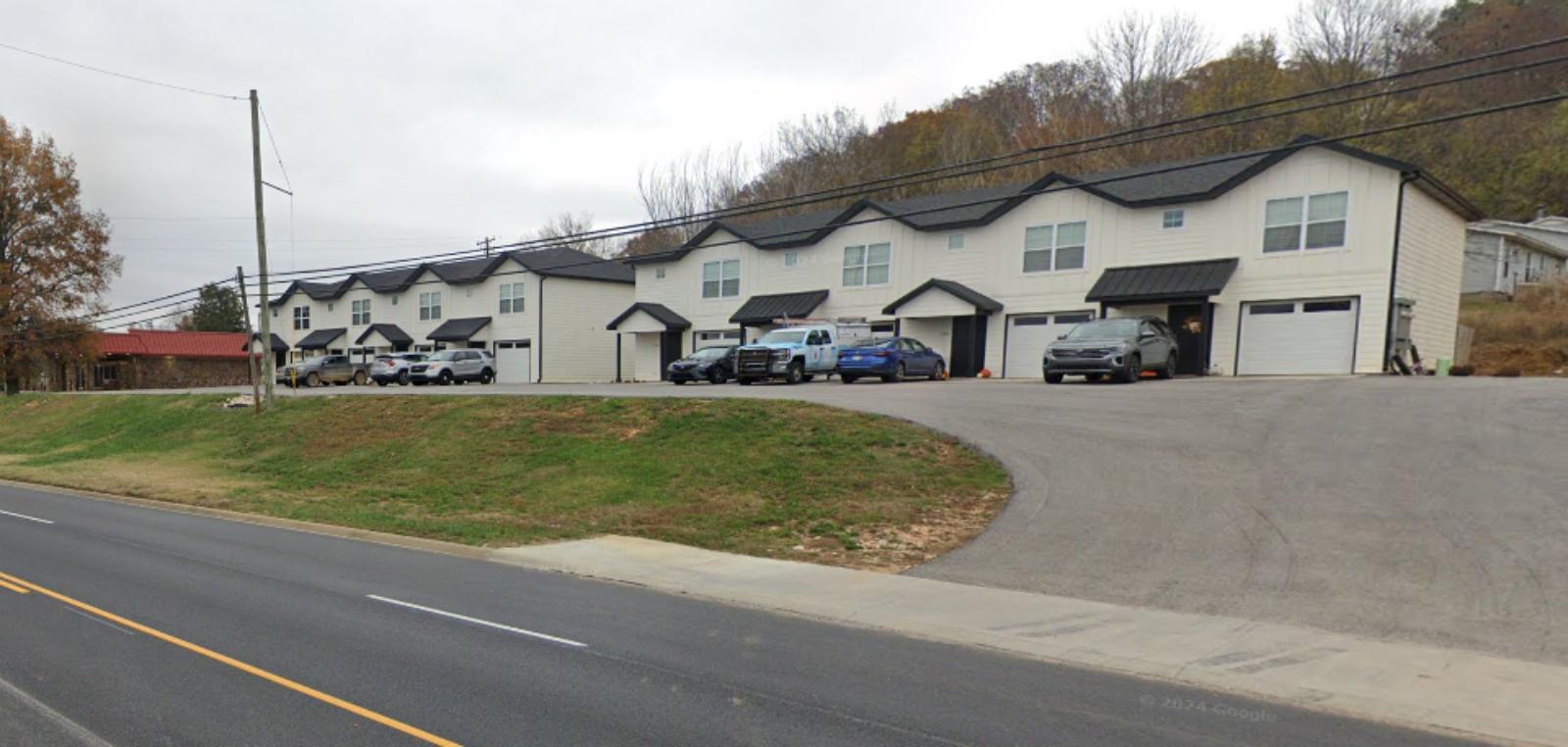
Why are people willing to pay so much to live here? What’s special about it?
West Fork attracts residents seeking small-town charm with reasonable access to Northwest Arkansas employment opportunities. The community offers rural character, affordable housing, and a strong sense of community while maintaining convenient highway access. Families value the peaceful environment and friendly atmosphere.
The area’s location provides an ideal balance between rural living and urban accessibility, appealing to professionals who want affordability and community character without completely sacrificing career opportunities. West Fork’s development patterns emphasize preserving small-town identity while accommodating growth.
How West Fork Rose to Prominence
West Fork evolved from a small agricultural and timber community into a desirable residential area as Northwest Arkansas’s economic influence expanded. The town’s location and affordable housing attracted families seeking alternatives to higher-priced areas closer to major employment centers.
The community’s appeal grew as residents discovered its combination of affordability, rural character, and accessibility to Northwest Arkansas opportunities. West Fork’s success in maintaining its small-town identity while participating in regional growth has established it as an attractive option for families seeking value and community.
3 Interesting Tidbits
1. Timber Heritage – Historically connected to Arkansas’s timber industry, maintaining connections to forestry and outdoor traditions.
2. Value Alternative – Offers affordable housing options while maintaining access to Northwest Arkansas employment and opportunities.
3. Community Spirit – Maintains strong small-town character and community connections despite proximity to major metropolitan areas.
25. Hot Springs Village – 62% Home Price Increase Since 2010
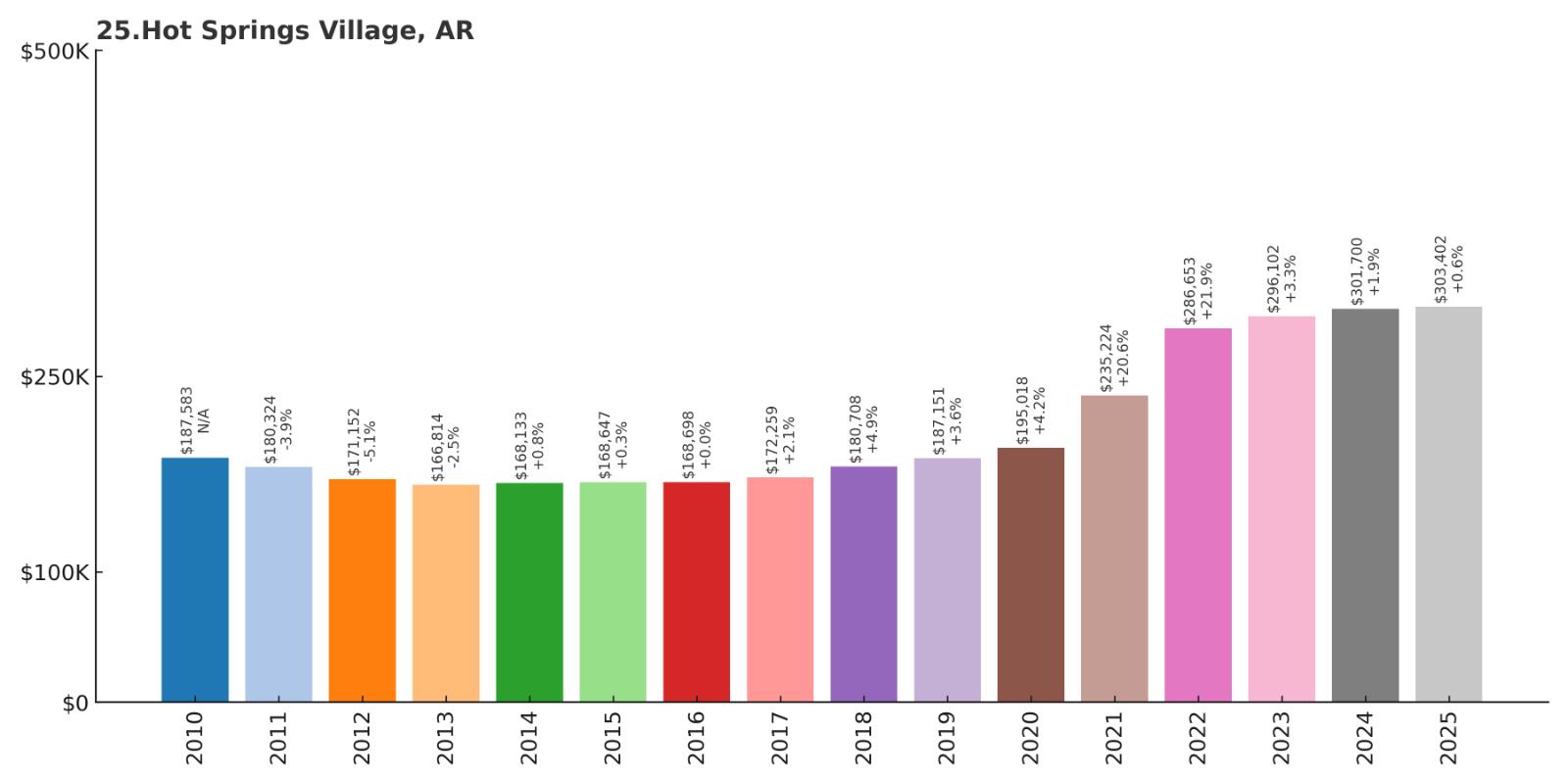
- 2010: $187,583
- 2011: $180,324
- 2012: $171,152
- 2013: $166,814
- 2014: $168,133
- 2015: $168,647
- 2016: $168,698
- 2017: $172,259
- 2018: $180,708
- 2019: $187,151
- 2020: $195,018
- 2021: $235,224
- 2022: $286,653
- 2023: $296,102
- 2024: $301,700
- 2025: $303,402
Hot Springs Village showed remarkable resilience through mid-decade challenges, then accelerated significantly after 2020 to reach $303,402 by July 2025. This 62% growth since 2010 reflects the community’s appeal as Arkansas’s premier retirement and resort destination with extensive amenities and recreational opportunities.
Why Hot Springs Village?
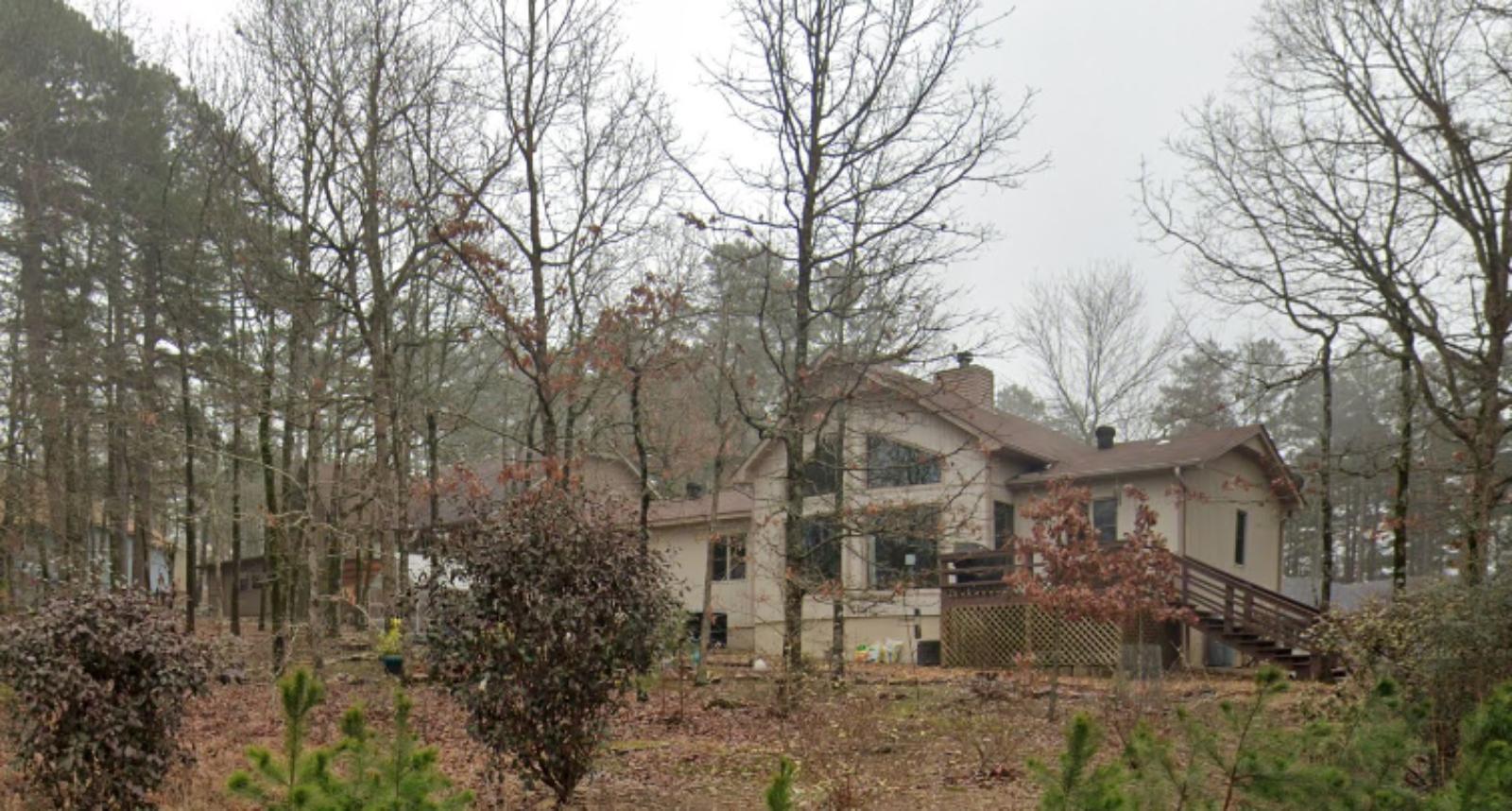
Why are people willing to pay so much to live here? What’s special about it?
Hot Springs Village attracts residents with its extensive recreational amenities, including 12 golf courses, 11 lakes, and numerous recreational facilities. The gated community offers resort-style living with year-round activities, social opportunities, and natural beauty. Retirees particularly value the community’s comprehensive amenities and active lifestyle options.
The village’s location in the Ouachita Mountains provides scenic beauty and outdoor recreation while its planned amenities ensure consistent quality of life. Hot Springs Village’s reputation as a premier retirement destination attracts residents from throughout the United States seeking active adult living.
How Hot Springs Village Rose to Prominence
Hot Springs Village was developed in the 1970s as a master-planned resort and retirement community in the Ouachita Mountains. The development emphasized recreational amenities, natural beauty, and comprehensive services designed to attract retirees and vacation home buyers from throughout the United States.
The community’s success stems from its comprehensive approach to resort living, which includes extensive golf facilities, water recreation, and social amenities. Hot Springs Village’s reputation as Arkansas’s premier retirement destination has attracted residents seeking active adult living in a scenic mountain setting.
3 Interesting Tidbits
1. Golf Paradise – Features 12 championship golf courses designed by renowned architects, making it one of America’s premier golf destinations.
2. Lake Living – Offers access to 11 lakes with various water recreation opportunities, from fishing to boating and swimming.
3. Gated Community – Operates as Arkansas’s largest gated community with comprehensive amenities and services for active adult living.
24. Scott – 58% Home Price Increase Since 2010
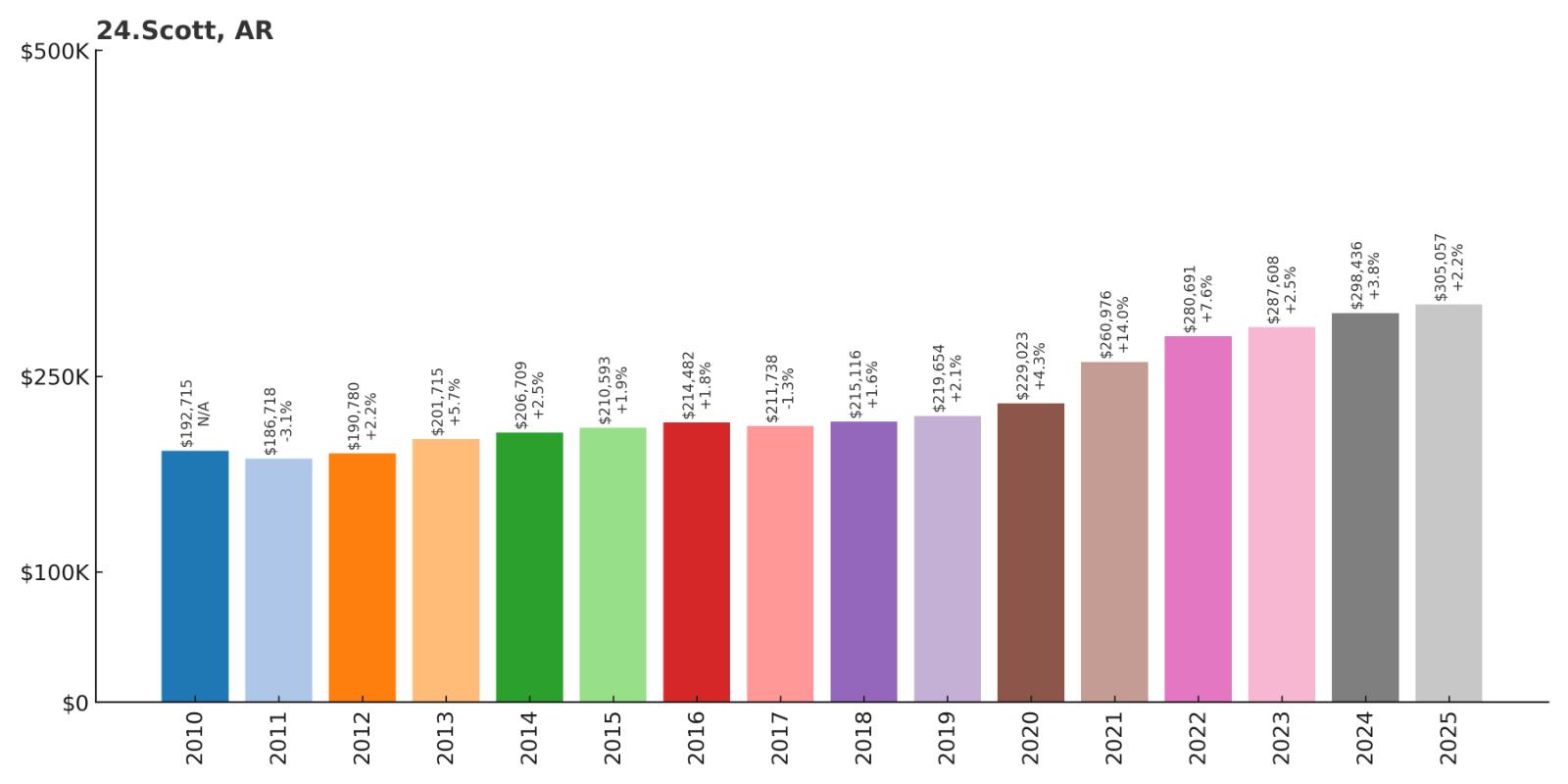
- 2010: $192,715
- 2011: $186,718
- 2012: $190,780
- 2013: $201,715
- 2014: $206,709
- 2015: $210,593
- 2016: $214,482
- 2017: $211,738
- 2018: $215,116
- 2019: $219,654
- 2020: $229,023
- 2021: $260,976
- 2022: $280,691
- 2023: $287,608
- 2024: $298,436
- 2025: $305,057
Scott showed steady progression throughout the period, with values increasing 58% since 2010 to reach $305,057 by July 2025. The community demonstrated consistent appreciation with acceleration after 2020, reflecting its established appeal as a suburban community in the Little Rock area with stable residential demand.
Why Scott?
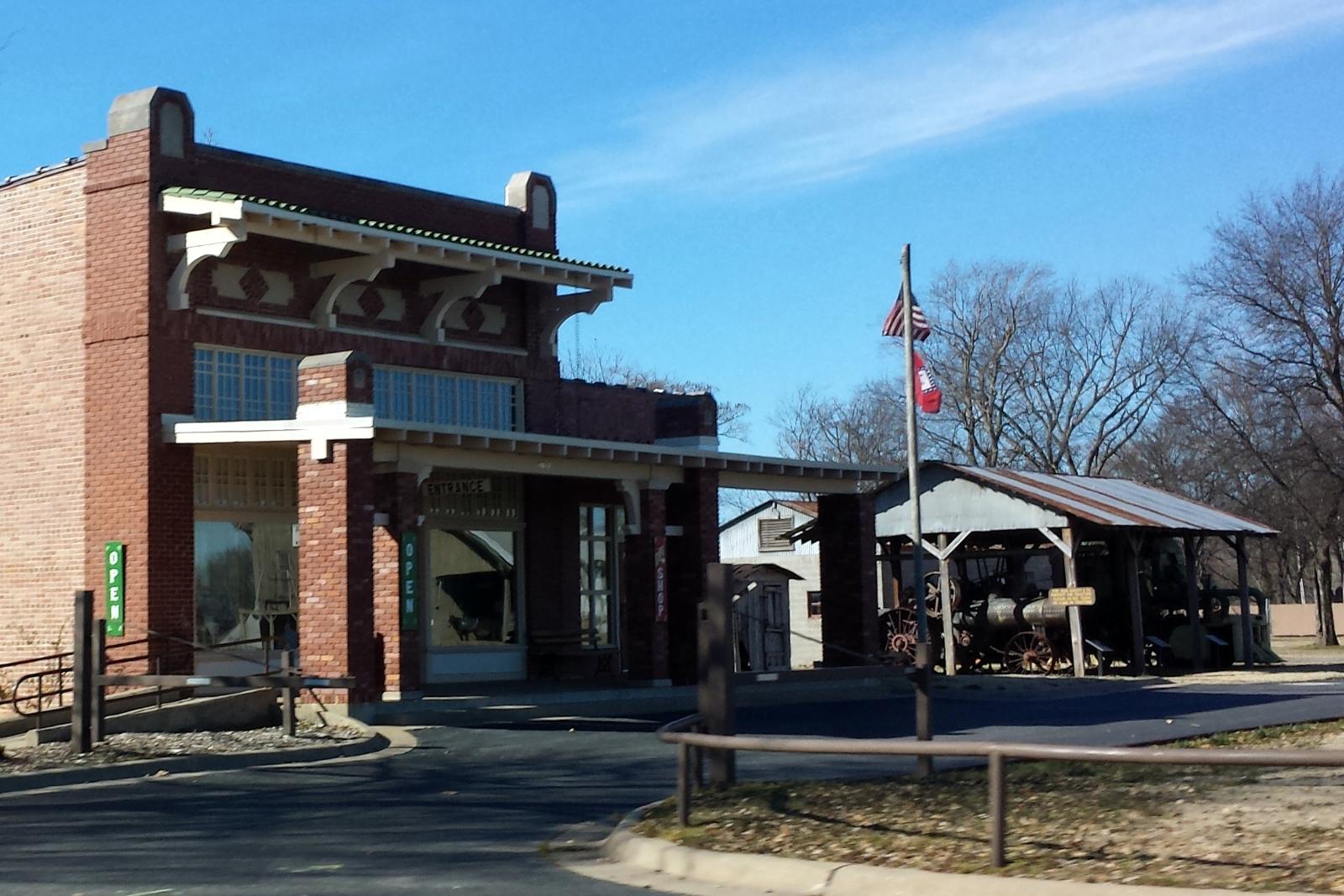
Why are people willing to pay so much to live here? What’s special about it?
Scott attracts families seeking suburban convenience with community character in the Little Rock metropolitan area. The city offers good schools, established neighborhoods, and convenient access to employment and amenities throughout central Arkansas. Residents value the stable environment and family-friendly atmosphere.
The community’s size provides suburban amenities while maintaining manageable growth and community cohesion. Scott’s location and development patterns create a balance between convenience and character that appeals to families throughout the Little Rock region.
How Scott Rose to Prominence
Scott developed as a suburban community serving the expanding Little Rock metropolitan area, attracting families seeking residential alternatives to urban living. The city’s growth was supported by its convenient location and development of family-oriented amenities and infrastructure.
The community’s evolution reflects successful suburban development that emphasizes family amenities, school quality, and convenient access to metropolitan employment. Scott’s stability and community character have maintained its appeal through various market cycles and demographic changes.
3 Interesting Tidbits
1. Suburban Stability – Provides consistent suburban amenities and family-friendly environment within the Little Rock metropolitan area.
2. Educational Focus – Known for quality schools and family-oriented development that attracts residents throughout central Arkansas.
3. Community Balance – Successfully balances suburban convenience with community character and manageable growth patterns.
23. Paron – 60% Home Price Increase Since 2010
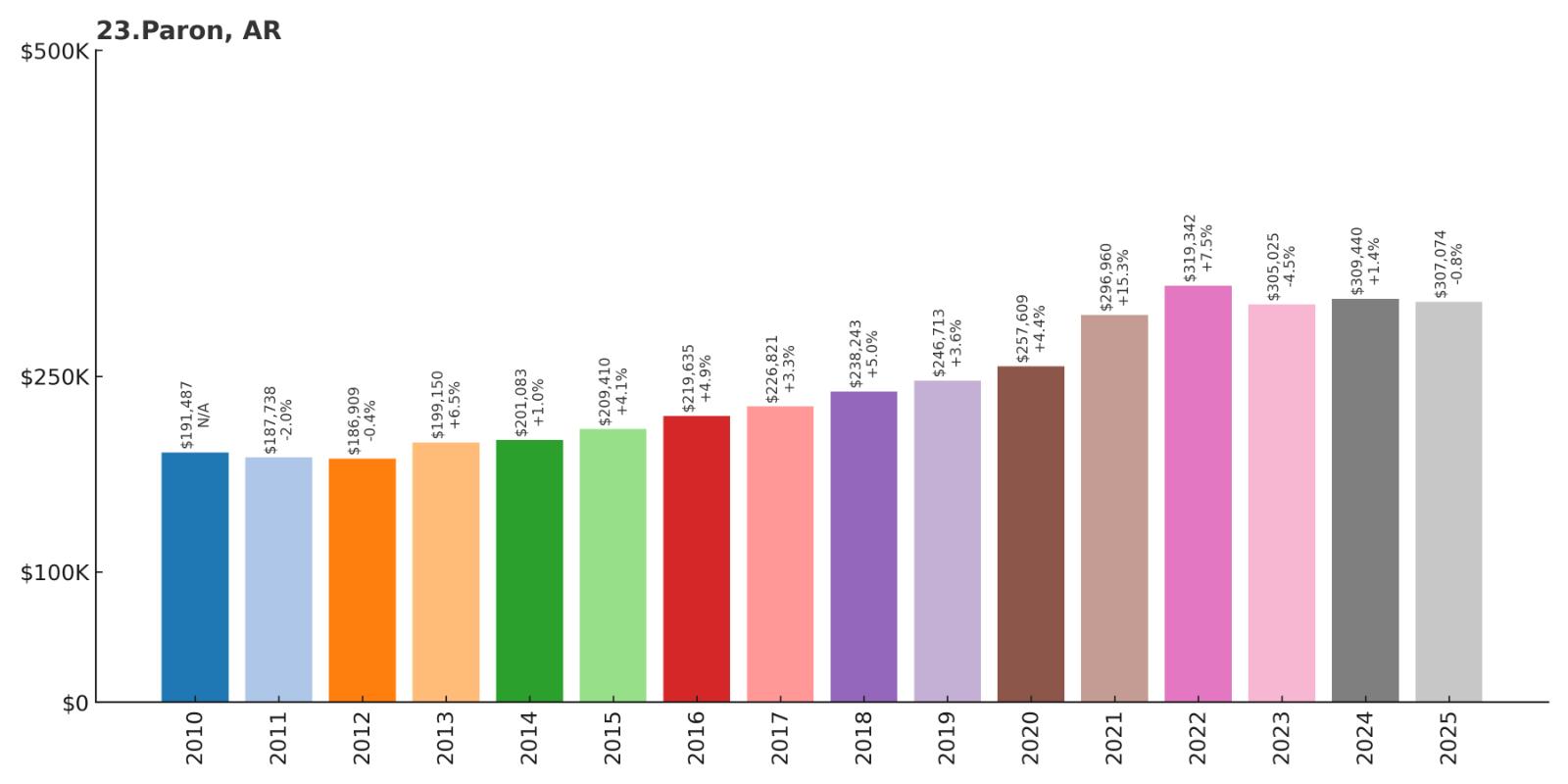
- 2010: $191,487
- 2011: $187,738
- 2012: $186,909
- 2013: $199,150
- 2014: $201,083
- 2015: $209,410
- 2016: $219,635
- 2017: $226,821
- 2018: $238,243
- 2019: $246,713
- 2020: $257,609
- 2021: $296,960
- 2022: $319,342
- 2023: $305,025
- 2024: $309,440
- 2025: $307,074
Paron demonstrated steady appreciation through 2020, followed by acceleration that brought values to $307,074 by July 2025. Starting from a higher base, the community achieved 60% growth since 2010, reflecting its appeal as a small community in the greater Little Rock area with rural character and accessibility.
Why Paron?
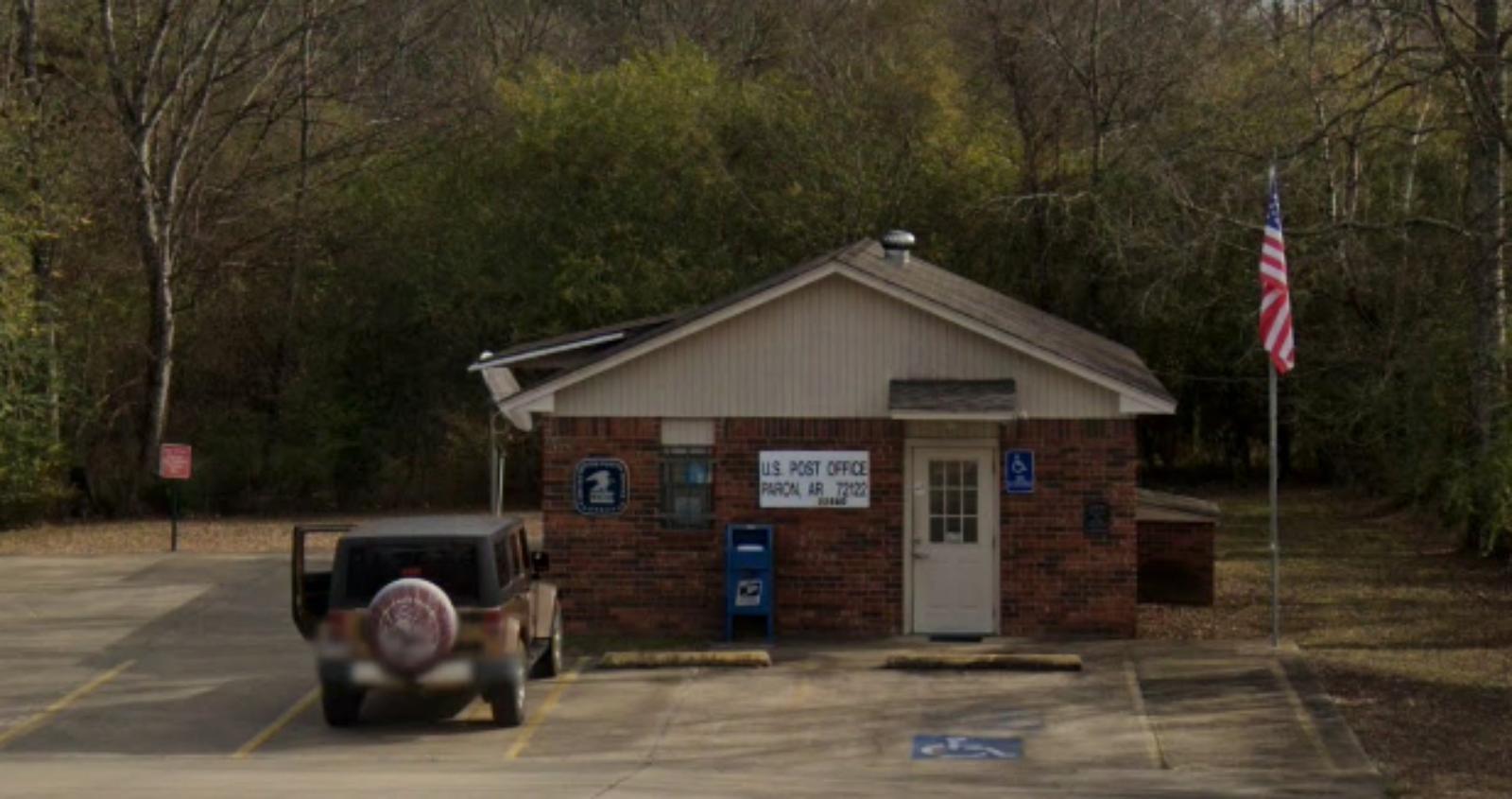
Why are people willing to pay so much to live here? What’s special about it?
Paron attracts residents seeking rural tranquility with reasonable access to Little Rock metropolitan employment and amenities. The community offers larger lots, peaceful surroundings, and small-town character while maintaining convenient highway access. Families value the slower pace of life and community connections.
The area’s location provides an ideal balance between rural living and urban accessibility, appealing to professionals who want space and privacy without completely sacrificing career opportunities. Paron’s development patterns emphasize preserving rural character while accommodating residential growth.
How Paron Rose to Prominence
Paron evolved from a small agricultural community into a desirable residential area as the Little Rock metropolitan area expanded. The town’s location and rural character attracted families seeking alternatives to suburban development while maintaining access to employment and services.
The community’s appeal grew as residents discovered its combination of affordability, rural character, and accessibility to Little Rock employment centers. Paron’s success in maintaining its small-town identity while accommodating growth has established it as an attractive option for families seeking rural living within a metropolitan area.
3 Interesting Tidbits
1. Rural Refuge – Provides small-town character and rural living while maintaining reasonable access to Little Rock metropolitan amenities.
2. Community Character – Maintains strong sense of community and neighborly connections despite proximity to metropolitan areas.
3. Strategic Location – Benefits from highway access that provides convenient commuting while preserving rural residential environment.
22. Maumelle – 45% Home Price Increase Since 2010
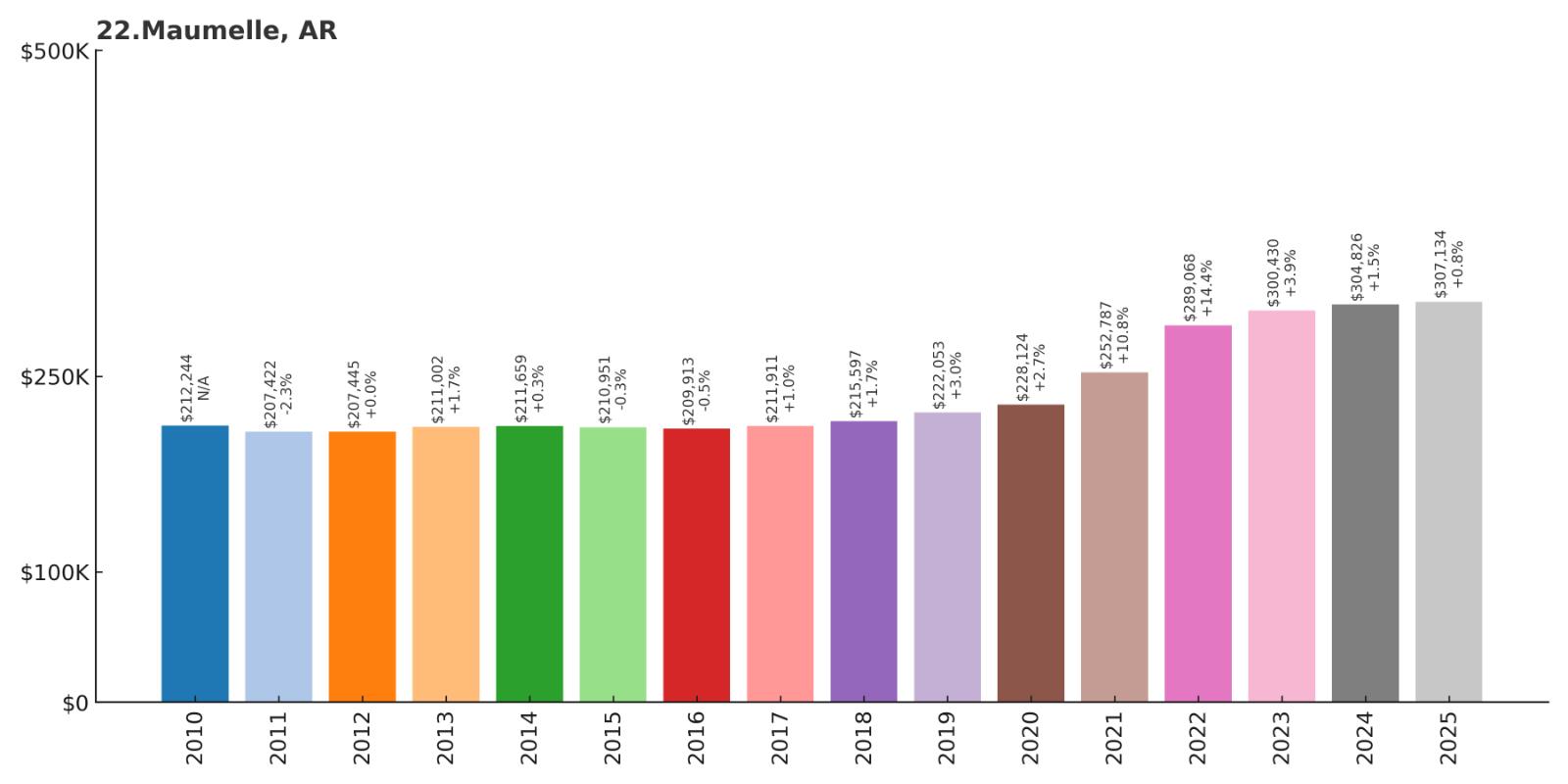
- 2010: $212,244
- 2011: $207,422
- 2012: $207,445
- 2013: $211,002
- 2014: $211,659
- 2015: $210,951
- 2016: $209,913
- 2017: $211,911
- 2018: $215,597
- 2019: $222,053
- 2020: $228,124
- 2021: $252,787
- 2022: $289,068
- 2023: $300,430
- 2024: $304,826
- 2025: $307,134
Maumelle showed remarkable stability through 2020, then experienced acceleration that brought values to $307,134 by July 2025. Despite starting from a higher base, the community achieved 45% growth since 2010, reflecting its established appeal as a planned community in the Little Rock metropolitan area with consistent demand.
Why Maumelle?
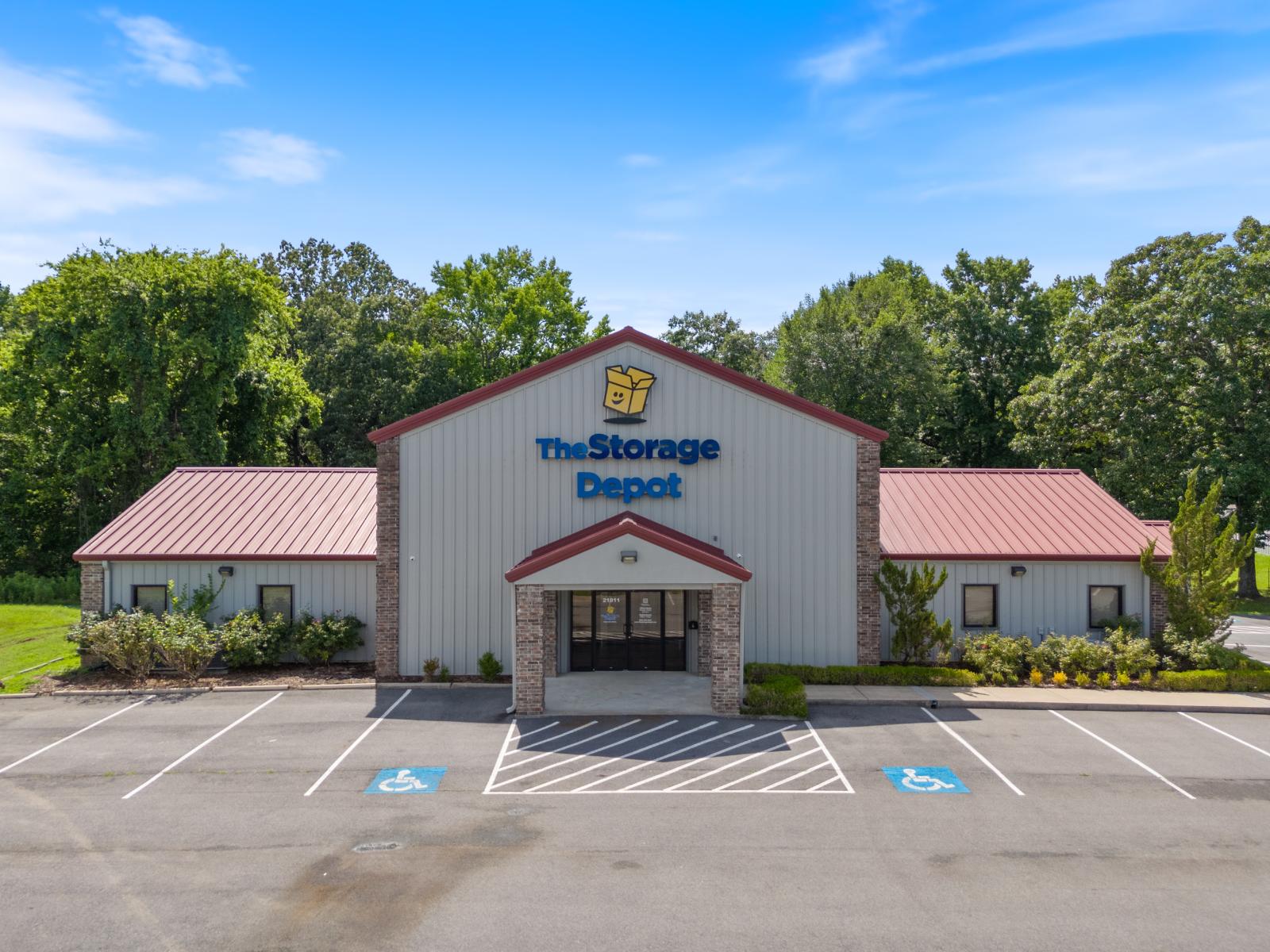
Why are people willing to pay so much to live here? What’s special about it?
Maumelle appeals to families seeking master-planned community amenities with convenient access to Little Rock employment. The city offers excellent schools, recreational facilities, and well-designed neighborhoods that emphasize quality of life. Residents value the community’s planning, safety, and family-friendly environment.
The community’s location on the Arkansas River provides recreational opportunities while its planned development ensures consistent infrastructure and amenities. Maumelle’s success as a master-planned community has created a stable residential environment that maintains property values and community character.
How Maumelle Rose to Prominence
Maumelle was developed as one of Arkansas’s first master-planned communities in the 1970s, designed to provide suburban living with enhanced amenities and careful planning. The community’s development emphasized quality infrastructure, recreational facilities, and environmental preservation along the Arkansas River.
The city’s planned approach to development attracted families seeking modern suburban amenities with community cohesion. Maumelle’s success as a planned community model influenced subsequent development throughout central Arkansas and established it as a desirable residential destination in the Little Rock metropolitan area.
3 Interesting Tidbits
1. Master Planning – Developed as one of Arkansas’s first master-planned communities, emphasizing quality infrastructure and community amenities.
2. River Location – Situated along the Arkansas River, providing residents with water recreation opportunities and scenic natural settings.
3. Community Model – Served as a model for planned community development throughout Arkansas, influencing subsequent suburban planning approaches.
21. Eureka Springs – 95% Home Price Increase Since 2010
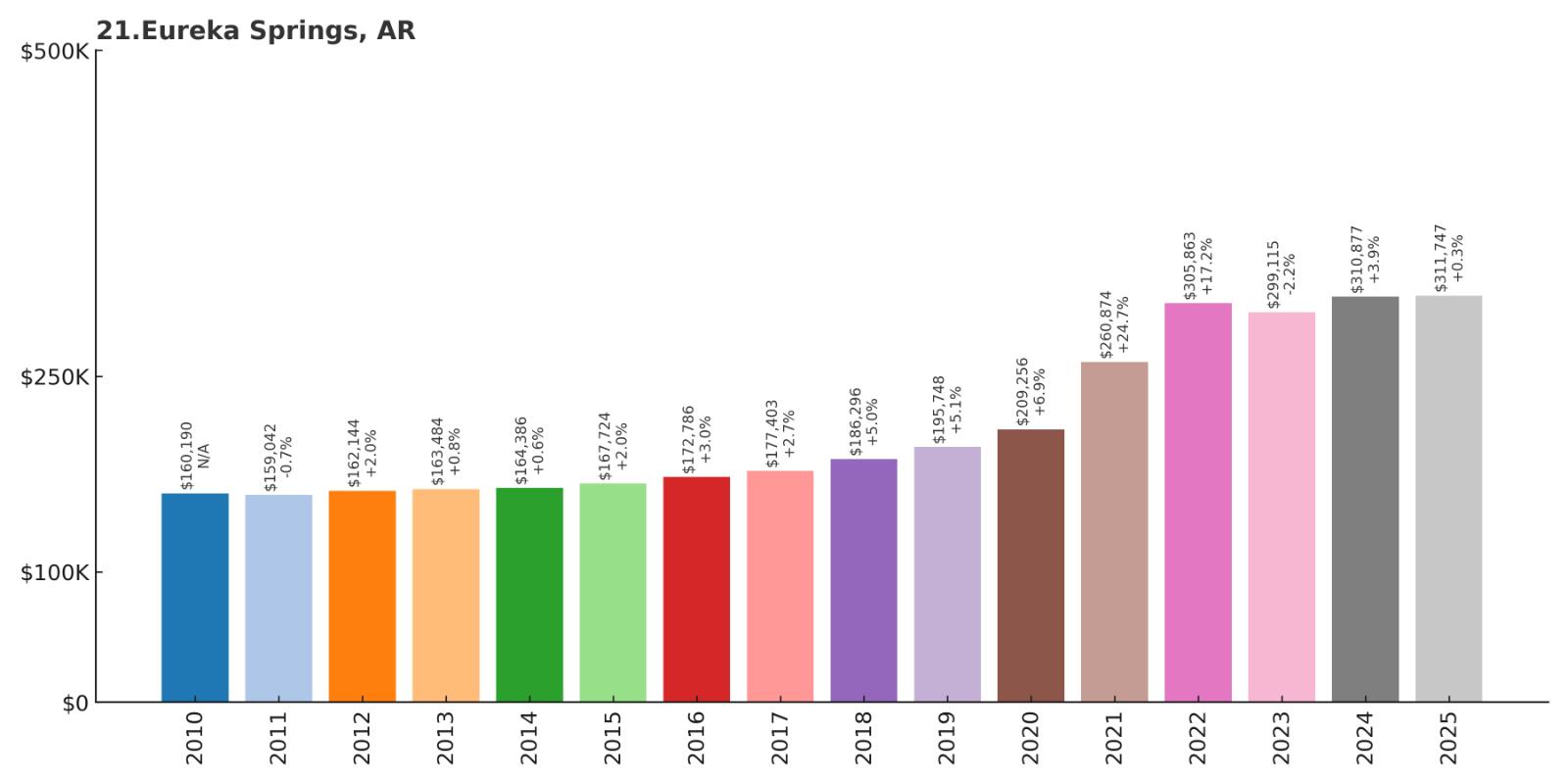
- 2010: $160,190
- 2011: $159,042
- 2012: $162,144
- 2013: $163,484
- 2014: $164,386
- 2015: $167,724
- 2016: $172,786
- 2017: $177,403
- 2018: $186,296
- 2019: $195,748
- 2020: $209,256
- 2021: $260,874
- 2022: $305,863
- 2023: $299,115
- 2024: $310,877
- 2025: $311,747
Eureka Springs demonstrated steady appreciation through 2020, followed by significant acceleration that brought values to $311,747 by July 2025. This 95% increase since 2010 reflects the community’s growing appeal as a unique tourist destination and residential community with distinctive Victorian architecture and natural springs.
Why Eureka Springs?
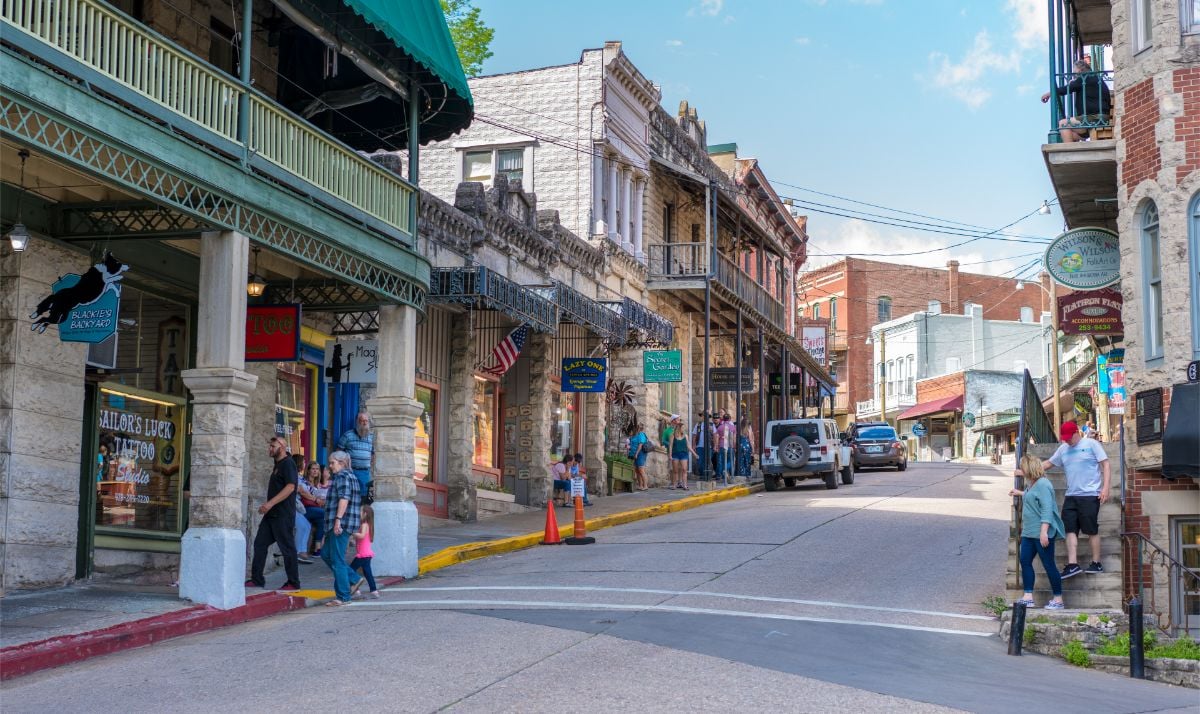
Why are people willing to pay so much to live here? What’s special about it?
Eureka Springs attracts residents with its unique character as a Victorian-era resort town nestled in the Ozark Mountains. The community offers distinctive architecture, natural springs, arts and crafts culture, and tourism amenities that create a one-of-a-kind living environment. Residents value the historic charm, artistic community, and natural beauty.
How Eureka Springs Rose to Prominence
Eureka Springs emerged as a resort destination in the 1880s, built around natural springs believed to have healing properties. The town’s Victorian architecture and mountain setting attracted visitors throughout the late 19th and early 20th centuries. After declining mid-century, Eureka Springs experienced revival as an arts community and tourist destination.
The community’s renaissance began in the 1960s and accelerated through preservation efforts and tourism development. Eureka Springs’ success in maintaining its historic character while developing modern tourism amenities has created a unique residential and economic environment that attracts diverse residents and visitors.
3 Interesting Tidbits
1. Natural Springs – Built around numerous natural springs that attracted visitors seeking healing waters, giving the town its distinctive identity and name.
2. Victorian Architecture – Features one of Arkansas’s largest collections of Victorian-era buildings, creating a unique historic atmosphere.
3. Arts Community – Home to a thriving arts and crafts community that contributes to the town’s cultural vibrancy and economic diversity.
20. Prairie Grove – 144% Home Price Increase Since 2010
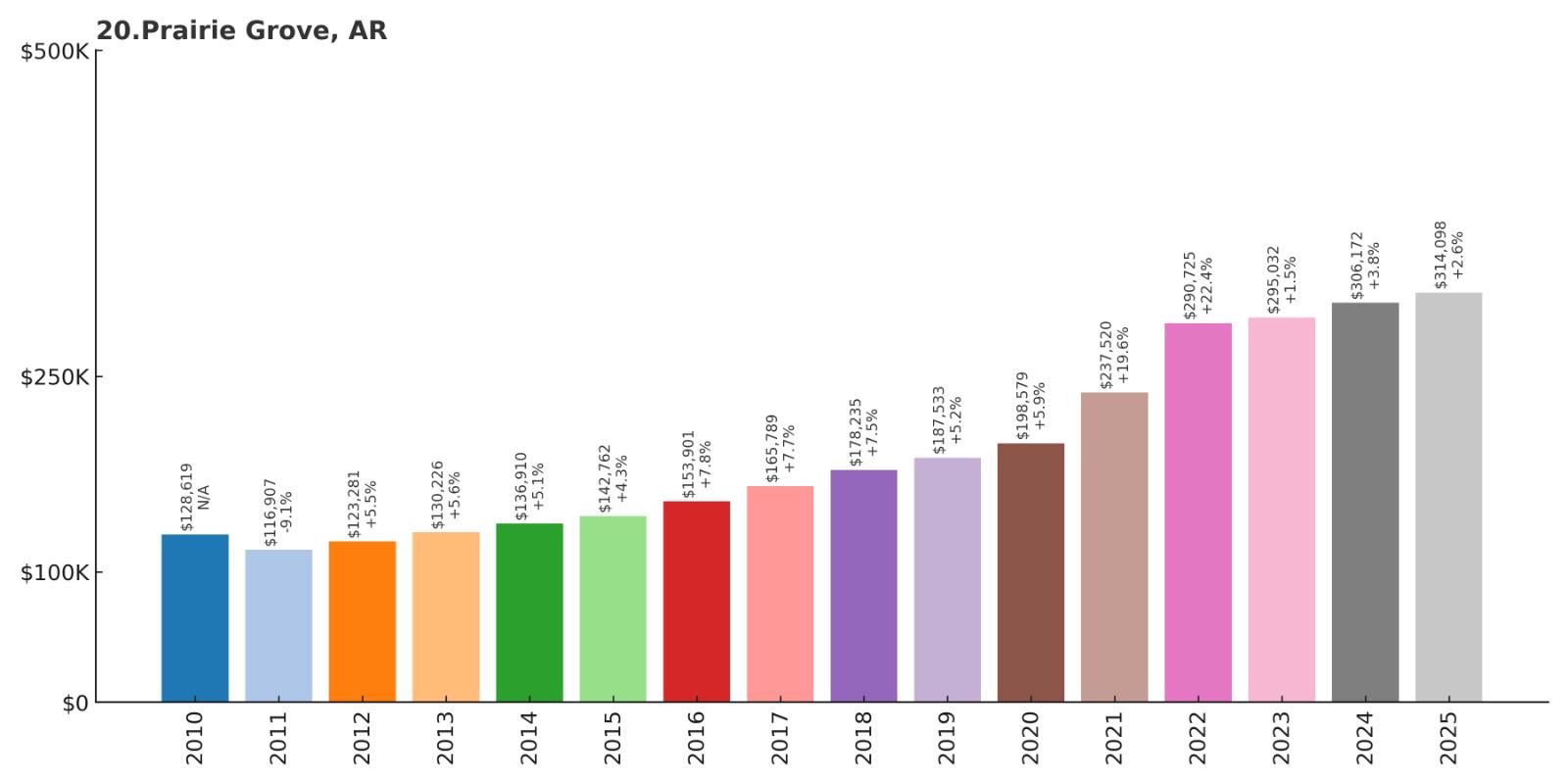
- 2010: $128,619
- 2011: $116,907
- 2012: $123,281
- 2013: $130,226
- 2014: $136,910
- 2015: $142,762
- 2016: $153,901
- 2017: $165,789
- 2018: $178,235
- 2019: $187,533
- 2020: $198,579
- 2021: $237,520
- 2022: $290,725
- 2023: $295,032
- 2024: $306,172
- 2025: $314,098
Prairie Grove achieved impressive growth with values increasing 144% since 2010, reaching $314,098 by July 2025. The community showed steady appreciation through 2020, then accelerated during the pandemic years. This growth reflects Prairie Grove’s appeal as a historic college town with modern amenities and Northwest Arkansas accessibility.
Why Prairie Grove?
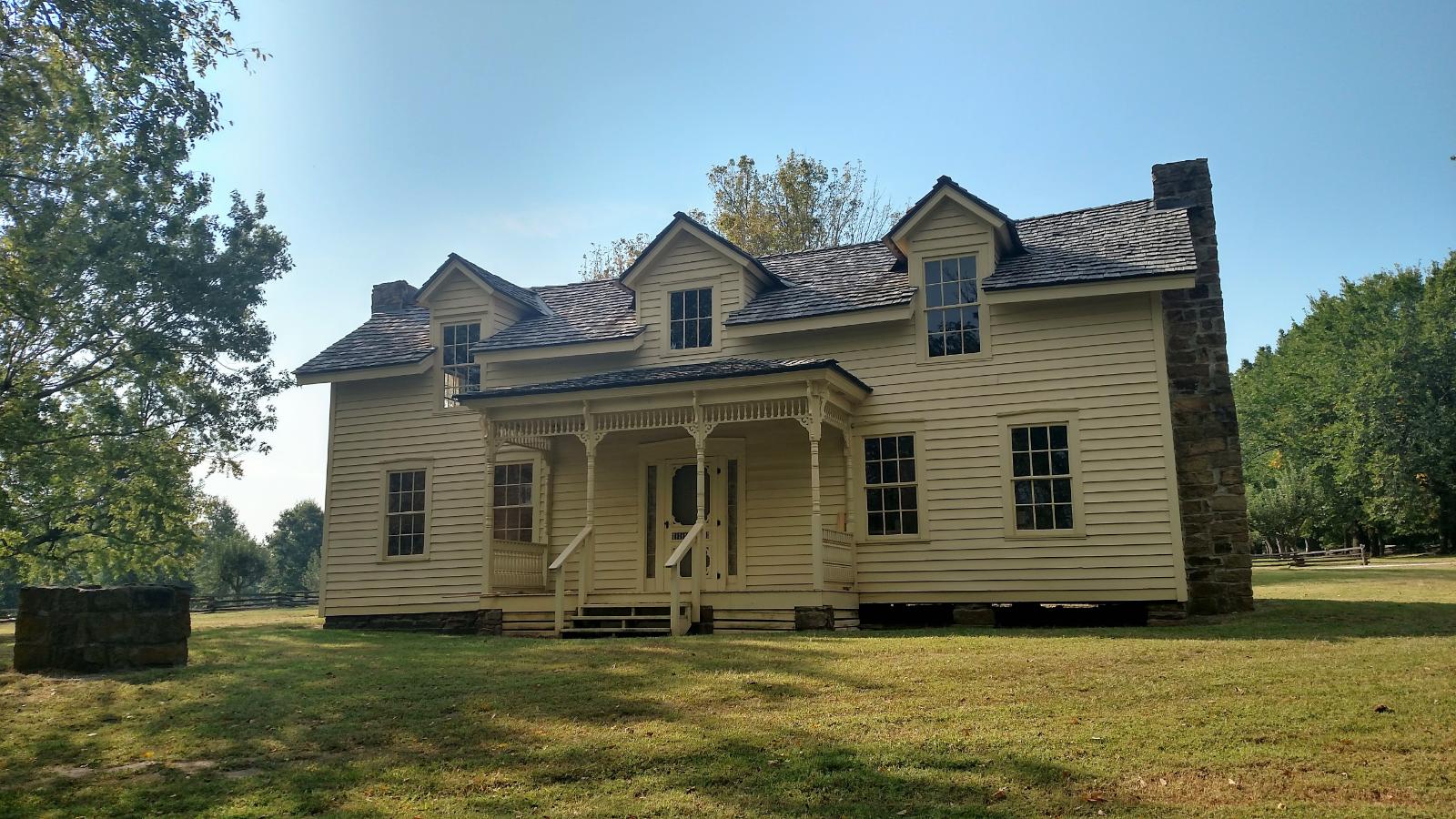
Why are people willing to pay so much to live here? What’s special about it?
Prairie Grove attracts residents with its unique combination of Civil War history, college town atmosphere, and small-town charm. Home to the University of Arkansas Prairie Grove campus and Prairie Grove Battlefield State Park, the community offers educational and recreational opportunities alongside modern amenities. Families value the historic character, quality schools, and safe environment.
The town’s location provides reasonable access to Fayetteville and Northwest Arkansas employment while maintaining distinctive character and affordability. Prairie Grove’s historical significance and educational assets create a unique community identity that appeals to diverse residents seeking cultural amenities.
How Prairie Grove Rose to Prominence
Prairie Grove’s prominence began with its significance as a Civil War battlefield site, later enhanced by its role as an educational center. The establishment of the University of Arkansas campus and the preservation of battlefield sites created unique cultural and educational assets that distinguished the community from typical rural Arkansas towns.
The town’s growth accelerated as families discovered its combination of historical character, educational opportunities, and accessibility to Northwest Arkansas economic centers. Prairie Grove’s success in preserving its historical identity while accommodating modern residential development has created a distinctive community within the region.
3 Interesting Tidbits
1. Civil War Heritage – Home to Prairie Grove Battlefield State Park, site of a significant 1862 Civil War battle that helped secure Arkansas for the Confederacy.
2. Educational Hub – Features a University of Arkansas campus that provides educational opportunities and contributes to the community’s intellectual atmosphere.
3. Historic Preservation – Successfully balances historical preservation with modern development, creating unique character that attracts residents and visitors.
19. Edgemont – 65% Home Price Increase Since 2010
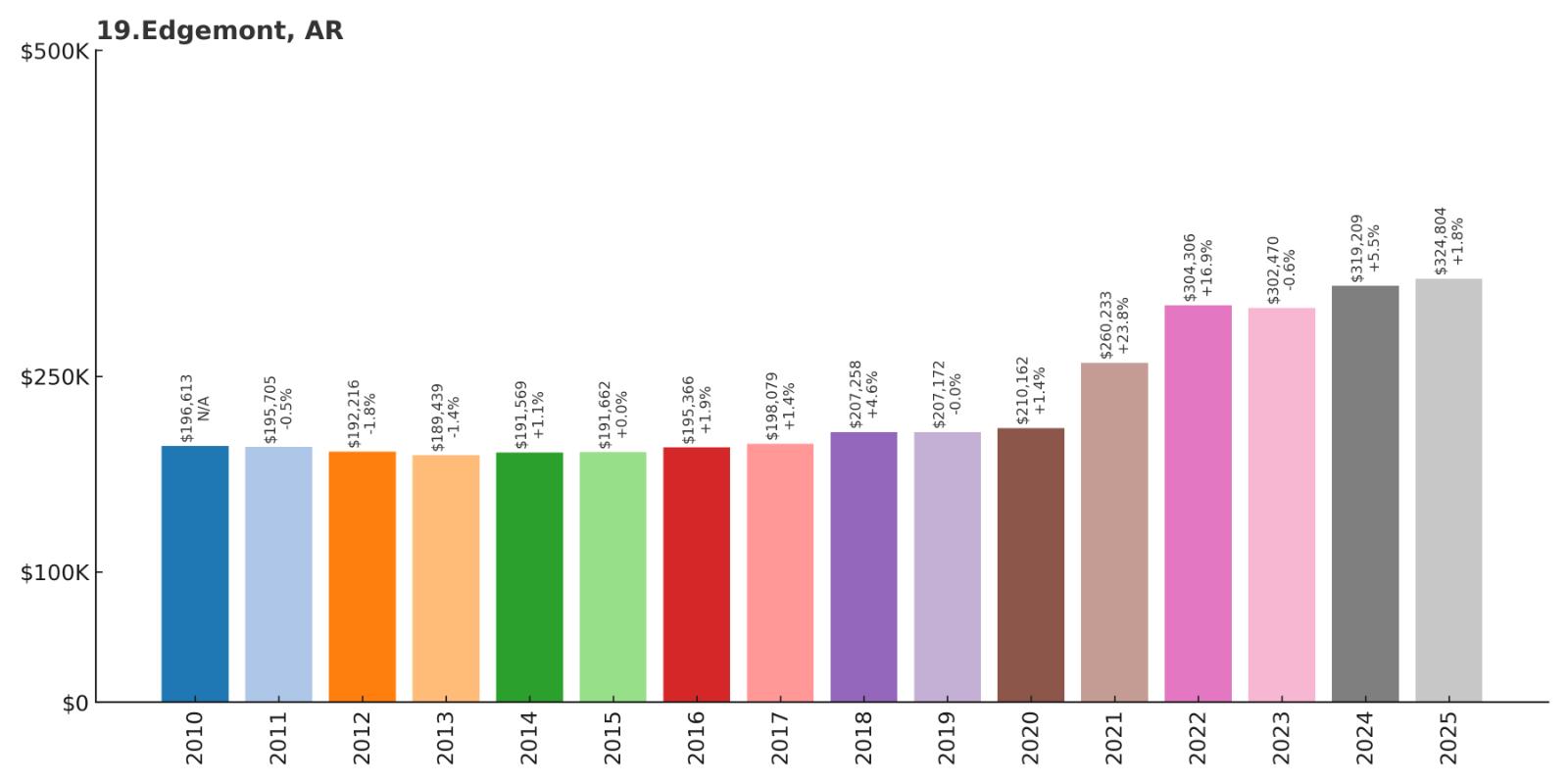
- 2010: $196,613
- 2011: $195,705
- 2012: $192,216
- 2013: $189,439
- 2014: $191,569
- 2015: $191,662
- 2016: $195,366
- 2017: $198,079
- 2018: $207,258
- 2019: $207,172
- 2020: $210,162
- 2021: $260,233
- 2022: $304,306
- 2023: $302,470
- 2024: $319,209
- 2025: $324,804
Edgemont showed stability through 2020, then experienced substantial acceleration that brought values to $324,804 by July 2025. Despite starting from a higher base, the community achieved 65% growth since 2010, reflecting its established appeal and recent market dynamics in central Arkansas.
Why Edgemont?
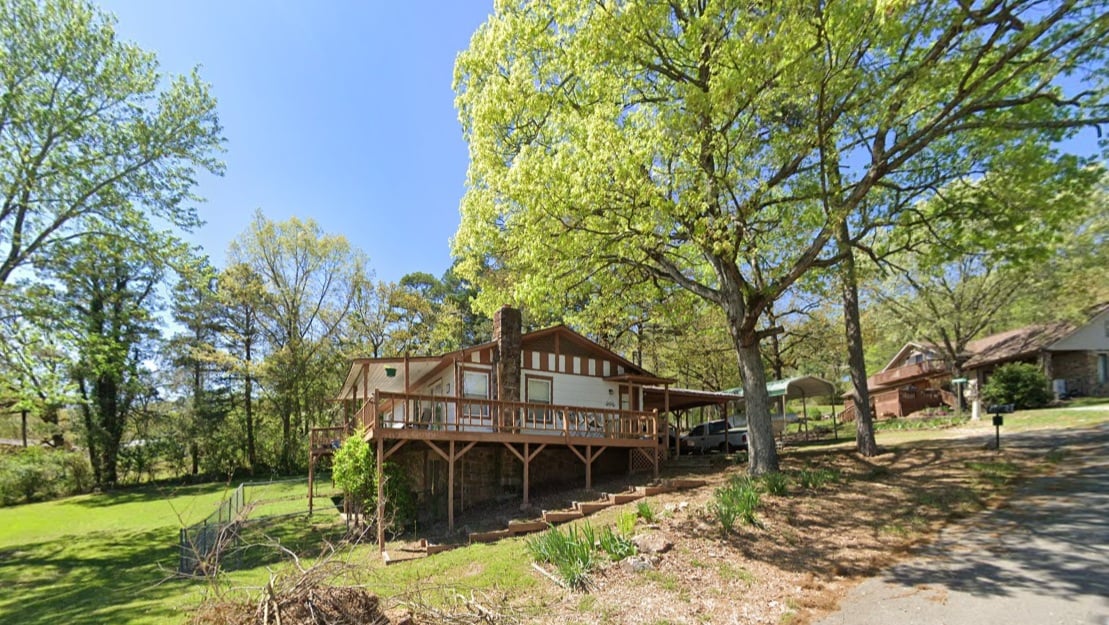
Why are people willing to pay so much to live here? What’s special about it?
Edgemont appeals to residents seeking suburban convenience with established community character. The area offers mature neighborhoods, good schools, and proximity to Little Rock employment and amenities. Families value the stable environment, established infrastructure, and central Arkansas location.
The community’s location provides easy access to Little Rock metropolitan amenities while maintaining suburban character and quality schools. Edgemont’s established neighborhoods and infrastructure create a stable residential environment that appeals to families and professionals.
How Edgemont Rose to Prominence
Edgemont developed as a suburban community serving the Little Rock metropolitan area, attracting families seeking residential alternatives to urban living. The area’s growth was supported by its proximity to employment centers and its development of family-friendly amenities and quality schools.
The community’s evolution reflects broader suburban development patterns in central Arkansas, with emphasis on family amenities, school quality, and convenient access to metropolitan employment and services. Edgemont’s stability and established character have maintained its appeal through various market cycles.
3 Interesting Tidbits
1. Central Arkansas Hub – Provides suburban living with convenient access to Little Rock metropolitan employment and amenities.
2. Established Character – Features mature neighborhoods and infrastructure that provide stability and community continuity.
3. Educational Focus – Known for quality schools and family-oriented amenities that attract residents throughout central Arkansas.
18. Farmington – 122% Home Price Increase Since 2010
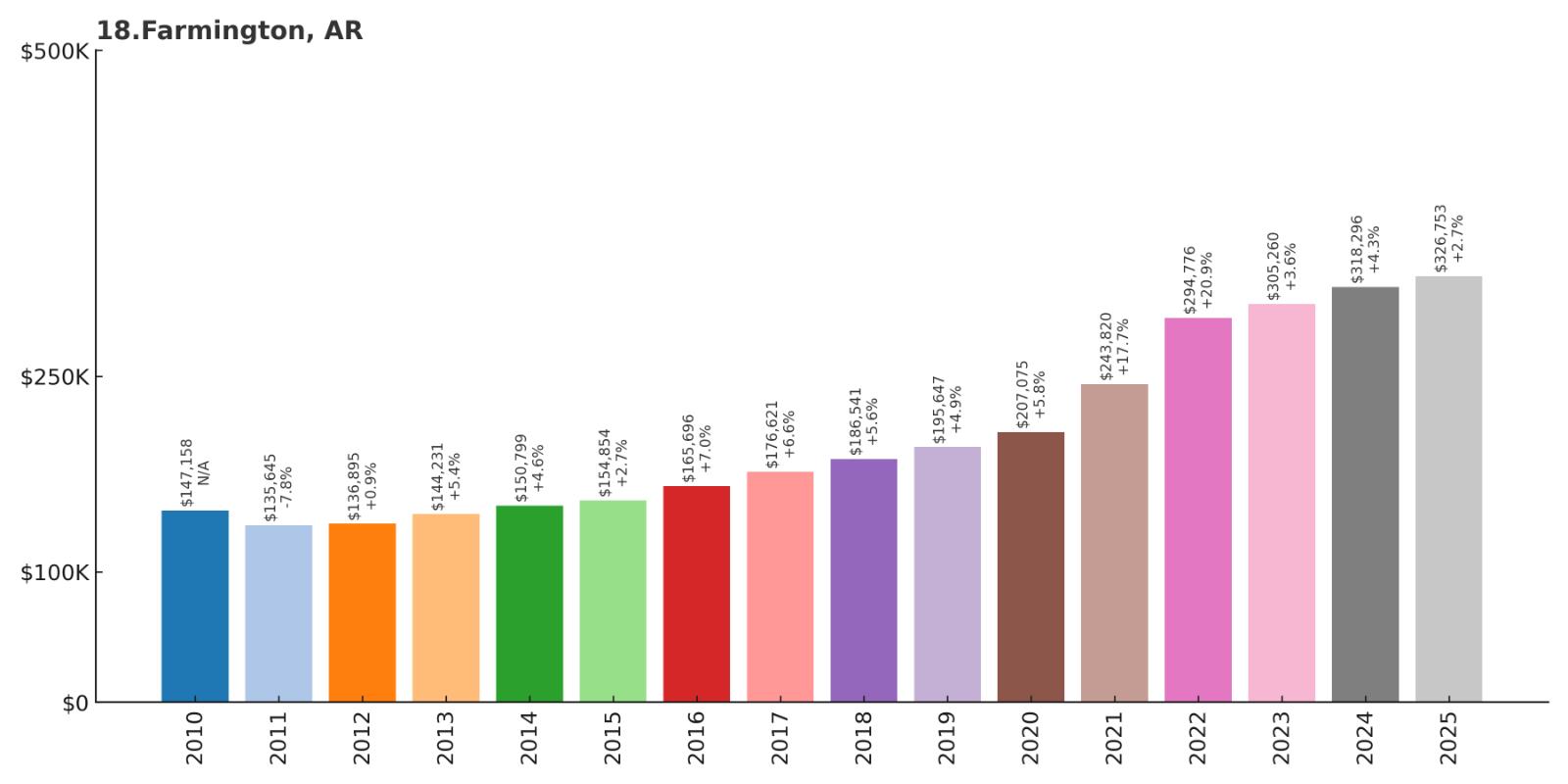
- 2010: $147,158
- 2011: $135,645
- 2012: $136,895
- 2013: $144,231
- 2014: $150,799
- 2015: $154,854
- 2016: $165,696
- 2017: $176,621
- 2018: $186,541
- 2019: $195,647
- 2020: $207,075
- 2021: $243,820
- 2022: $294,776
- 2023: $305,260
- 2024: $318,296
- 2025: $326,753
Farmington achieved steady growth throughout the period, with values increasing 122% since 2010 to reach $326,753 by July 2025. The community demonstrated consistent appreciation and accelerated significantly after 2020, reflecting its appeal as a growing suburban destination in the greater Northwest Arkansas region.
Why Farmington?
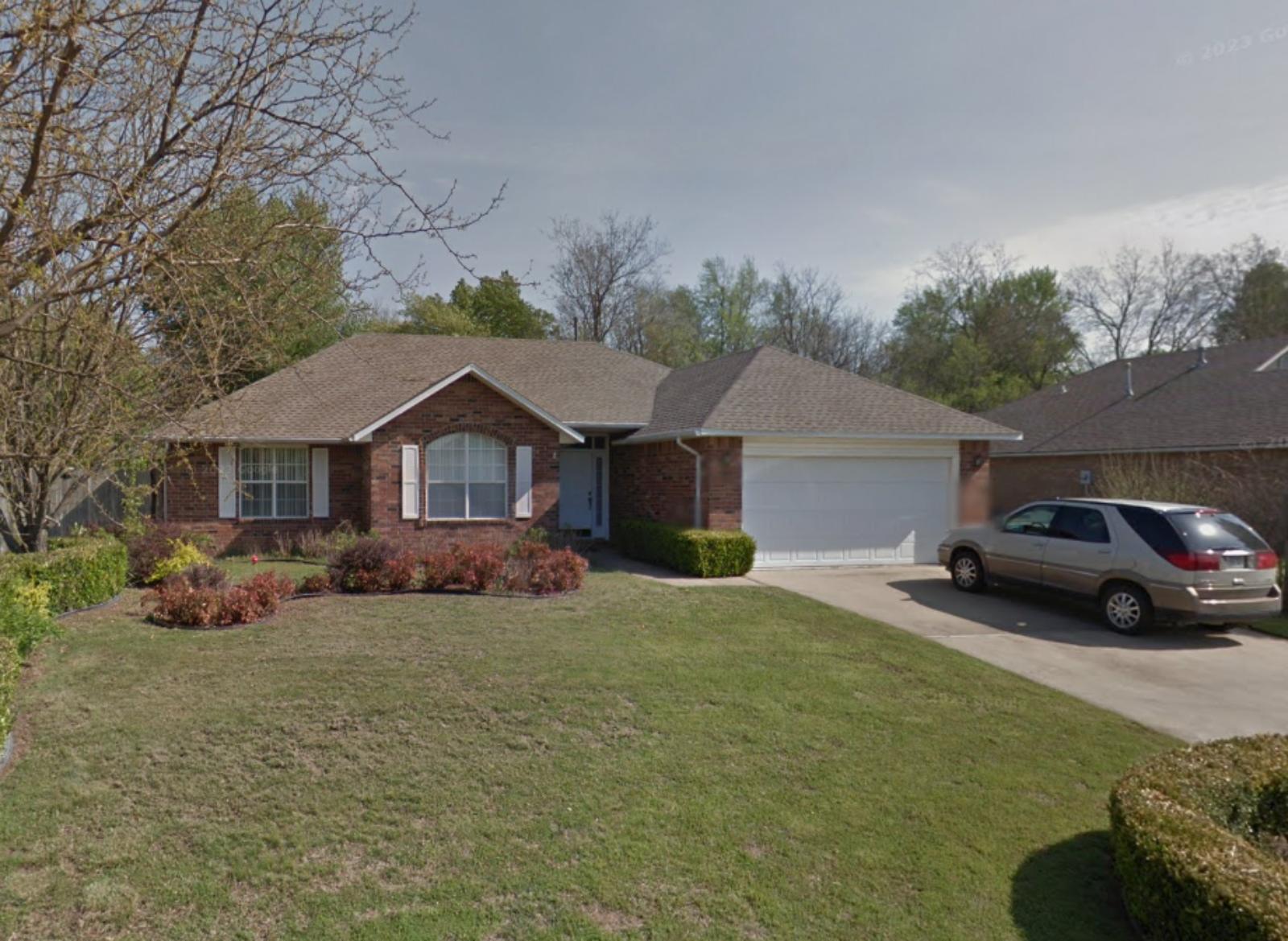
Why are people willing to pay so much to live here? What’s special about it?
Farmington attracts families seeking suburban convenience with small-town character. The community offers excellent schools, new residential development, and easy access to Fayetteville employment and amenities. Residents value the peaceful environment, family-friendly atmosphere, and modern infrastructure.
The city’s planned growth and development have created attractive residential neighborhoods while preserving community character. Farmington’s location provides suburban amenities while maintaining reasonable commuting access to major Northwest Arkansas employment centers.
How Farmington Rose to Prominence
Farmington evolved from a small agricultural community into a thriving suburban city as the Fayetteville metropolitan area expanded. The community’s strategic location and available land attracted residential development and families seeking alternatives to urban living while maintaining access to employment and amenities.
The city’s incorporation and planned development approach helped guide its growth while preserving community identity. Farmington’s success in managing expansion while maintaining quality of life has established it as a desirable residential destination within the broader Northwest Arkansas market.
3 Interesting Tidbits
1. Suburban Growth – Transformed from agricultural community to thriving suburban city through planned development and strategic location.
2. Family Focus – Emphasizes family-friendly amenities, schools, and residential development that attracts young families.
3. Strategic Location – Positioned to benefit from Fayetteville’s economic growth while maintaining distinct community character and identity.
17. Springdale – 144% Home Price Increase Since 2010
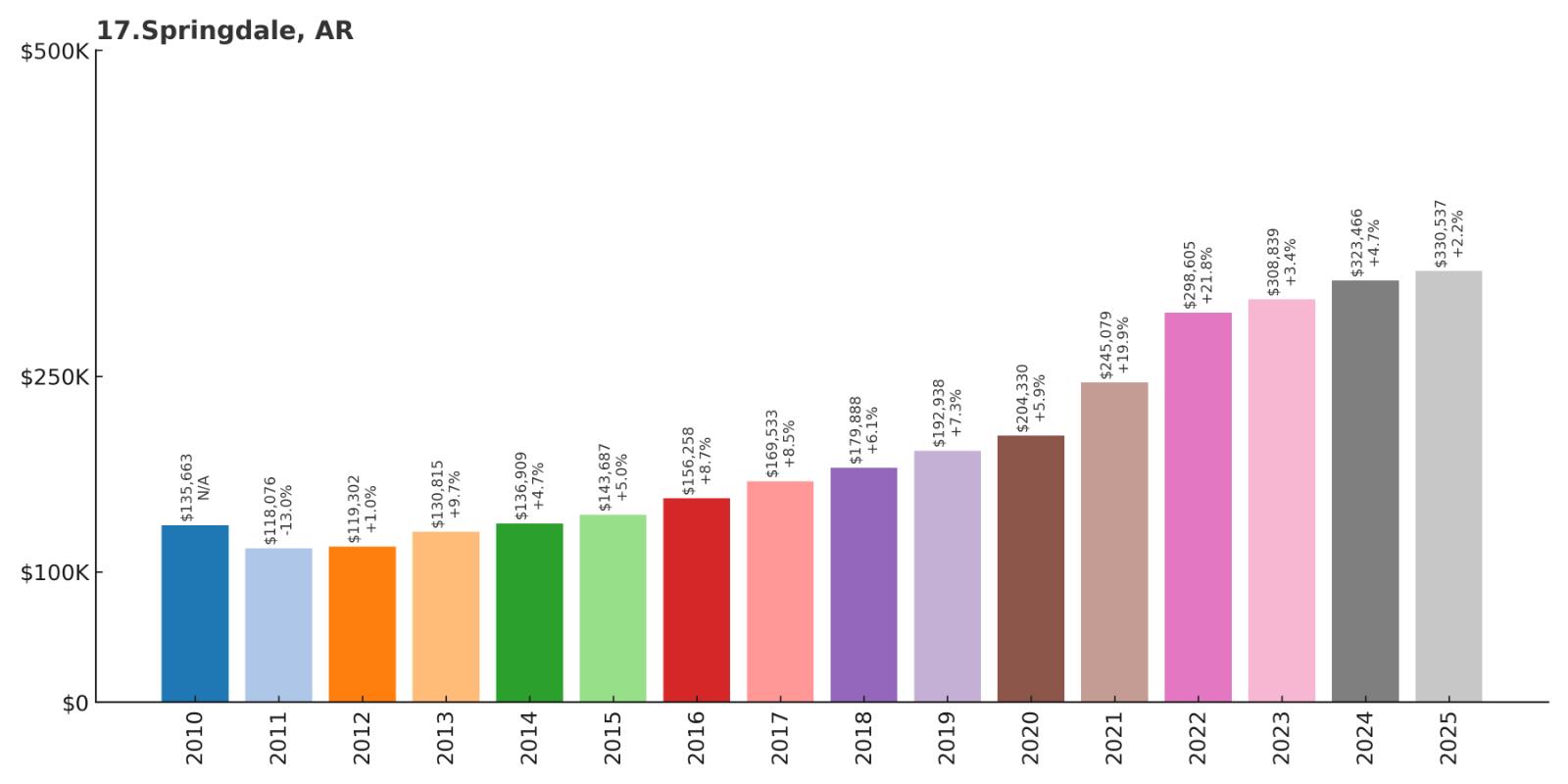
- 2010: $135,663
- 2011: $118,076
- 2012: $119,302
- 2013: $130,815
- 2014: $136,909
- 2015: $143,687
- 2016: $156,258
- 2017: $169,533
- 2018: $179,888
- 2019: $192,938
- 2020: $204,330
- 2021: $245,079
- 2022: $298,605
- 2023: $308,839
- 2024: $323,466
- 2025: $330,537
Springdale demonstrated strong recovery from early 2010s lows, with values increasing 144% since 2010 to reach $330,537 by July 2025. The community showed consistent growth through 2020, followed by acceleration that reflects its position as Northwest Arkansas’s second-largest city and a major employment center.
Why Springdale?
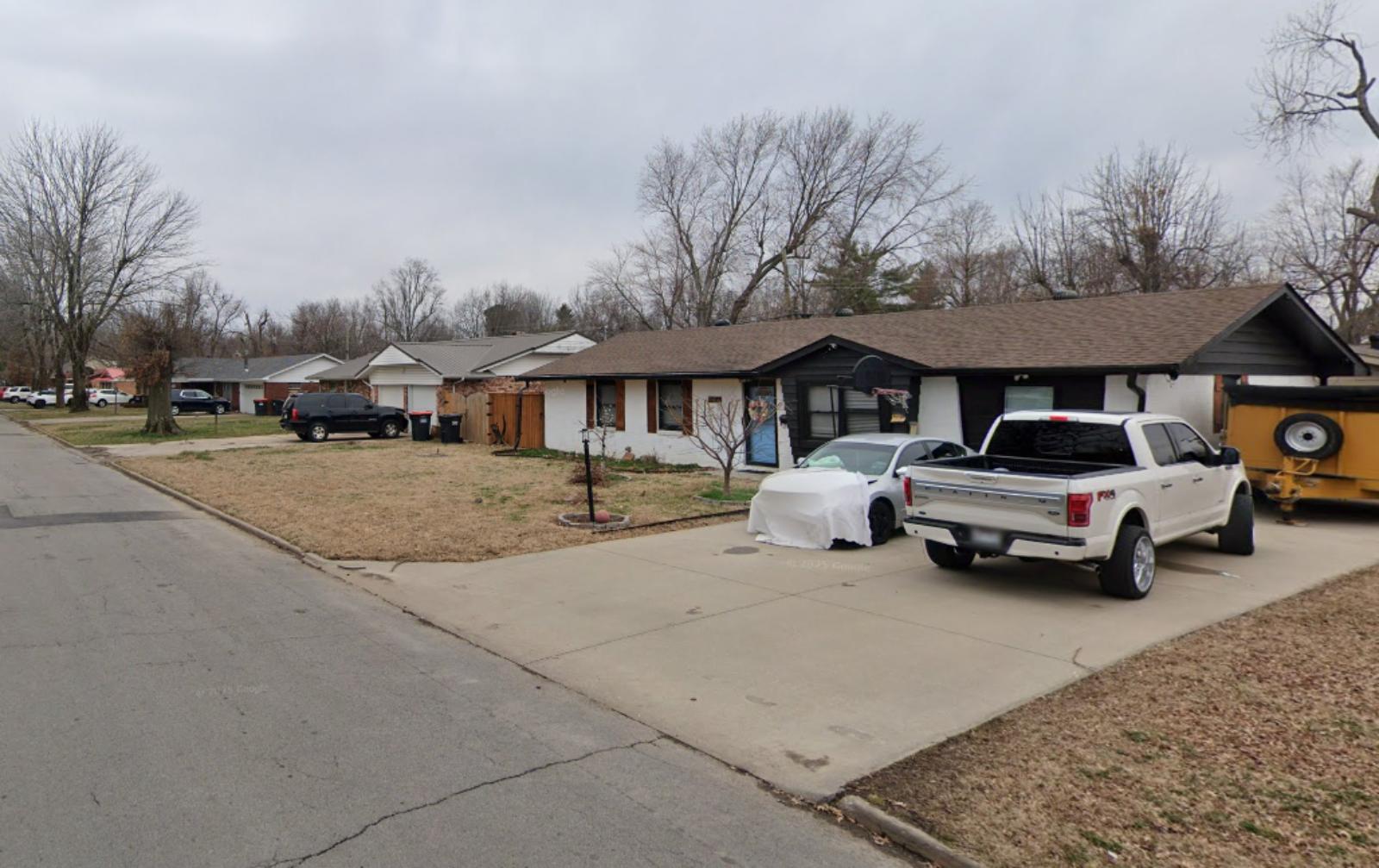
Why are people willing to pay so much to live here? What’s special about it?
Springdale attracts residents with its blend of urban amenities and affordable housing options within Northwest Arkansas. Home to Tyson Foods headquarters and major poultry processing facilities, the city offers diverse employment opportunities alongside cultural amenities and recreational facilities. Families value the city’s schools, parks, and community services.
The community’s size provides urban conveniences while maintaining more affordable housing costs than neighboring cities. Springdale’s economic diversity and infrastructure investments have created opportunities for residents across various income levels and backgrounds.
How Springdale Rose to Prominence
Springdale emerged as a major Northwest Arkansas city through its role as a regional agricultural and transportation hub. The city’s growth accelerated with the expansion of Tyson Foods and other poultry companies, creating employment opportunities that attracted workers and families from throughout Arkansas and beyond.
The community’s strategic investments in downtown revitalization, cultural amenities, and infrastructure have helped modernize its image while preserving its working-class character. Springdale’s success in balancing economic development with community needs has established it as an important anchor in the Northwest Arkansas region.
3 Interesting Tidbits
1. Corporate Headquarters – Home to Tyson Foods global headquarters, one of the world’s largest food companies.
2. Cultural Diversity – Features significant Latino and immigrant populations, creating a vibrant multicultural community environment.
3. Economic Engine – Serves as a major employment center for Northwest Arkansas, particularly in food processing and manufacturing industries.
16. Bethel Heights – 137% Home Price Increase Since 2010
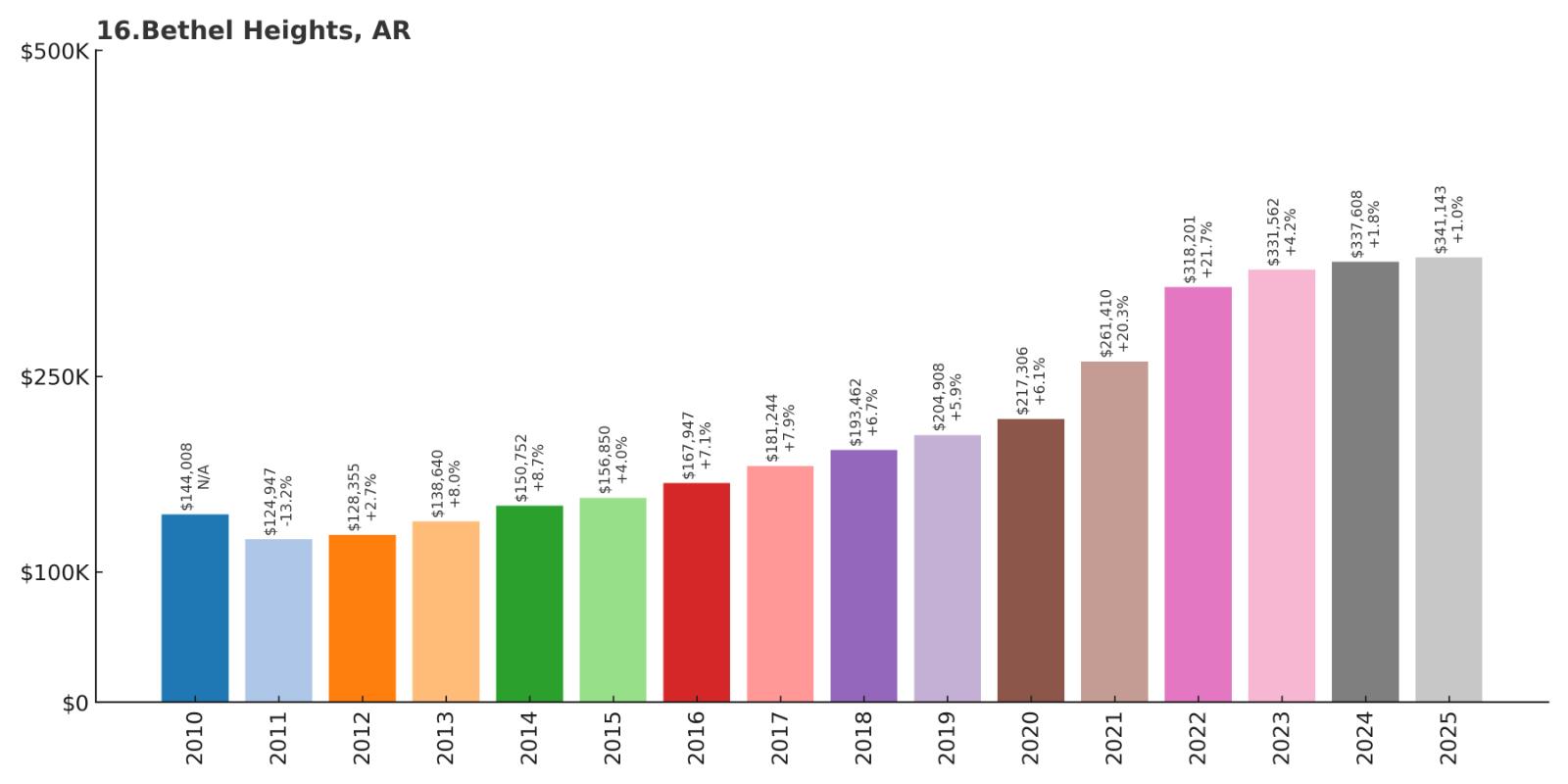
- 2010: $144,008
- 2011: $124,947
- 2012: $128,355
- 2013: $138,640
- 2014: $150,752
- 2015: $156,850
- 2016: $167,947
- 2017: $181,244
- 2018: $193,462
- 2019: $204,908
- 2020: $217,306
- 2021: $261,410
- 2022: $318,201
- 2023: $331,562
- 2024: $337,608
- 2025: $341,143
Bethel Heights showed steady progression through 2020, followed by substantial acceleration that brought values to $341,143 by July 2025. This 137% increase since 2010 reflects the community’s growing appeal as a family-friendly suburban destination within the greater Northwest Arkansas market.
Why Bethel Heights?
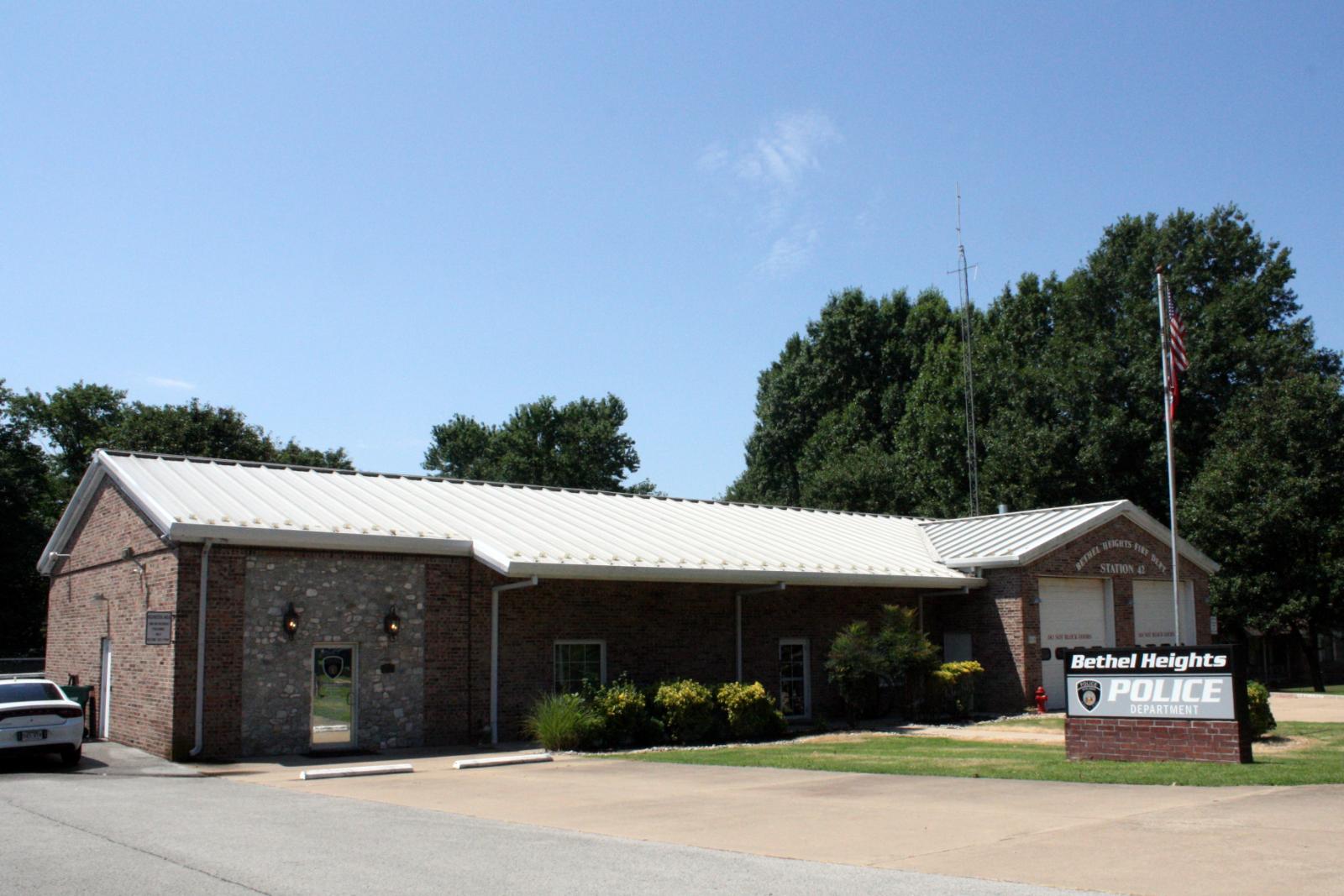
Why are people willing to pay so much to live here? What’s special about it?
Bethel Heights appeals to families seeking modern suburban amenities with small-town charm. The community offers excellent schools, safe neighborhoods, and family-friendly infrastructure while maintaining reasonable access to Northwest Arkansas employment centers. Residents appreciate the planned development and contemporary amenities.
The city’s growth management and infrastructure development have created a cohesive community environment that attracts families seeking newer housing options. Bethel Heights’ location and development patterns provide suburban convenience while maintaining manageable size and community character.
How Bethel Heights Rose to Prominence
Bethel Heights developed as a planned suburban community to accommodate Northwest Arkansas’s growing population and economic expansion. The city’s incorporation and strategic development planning helped create a family-oriented environment that attracted residents seeking modern amenities and quality schools.
The community’s success stems from its planned approach to development, which emphasized family amenities, infrastructure quality, and community cohesion. Bethel Heights’ strategic location and development vision have established it as a desirable suburban destination within the region’s competitive housing market.
3 Interesting Tidbits
1. Planned Community – Developed with careful attention to family amenities, infrastructure, and community cohesion.
2. School Excellence – Known for high-quality educational opportunities that attract families throughout the region.
3. Suburban Success – Exemplifies successful suburban development that balances growth with community character and livability.
15. Pea Ridge – 174% Home Price Increase Since 2010
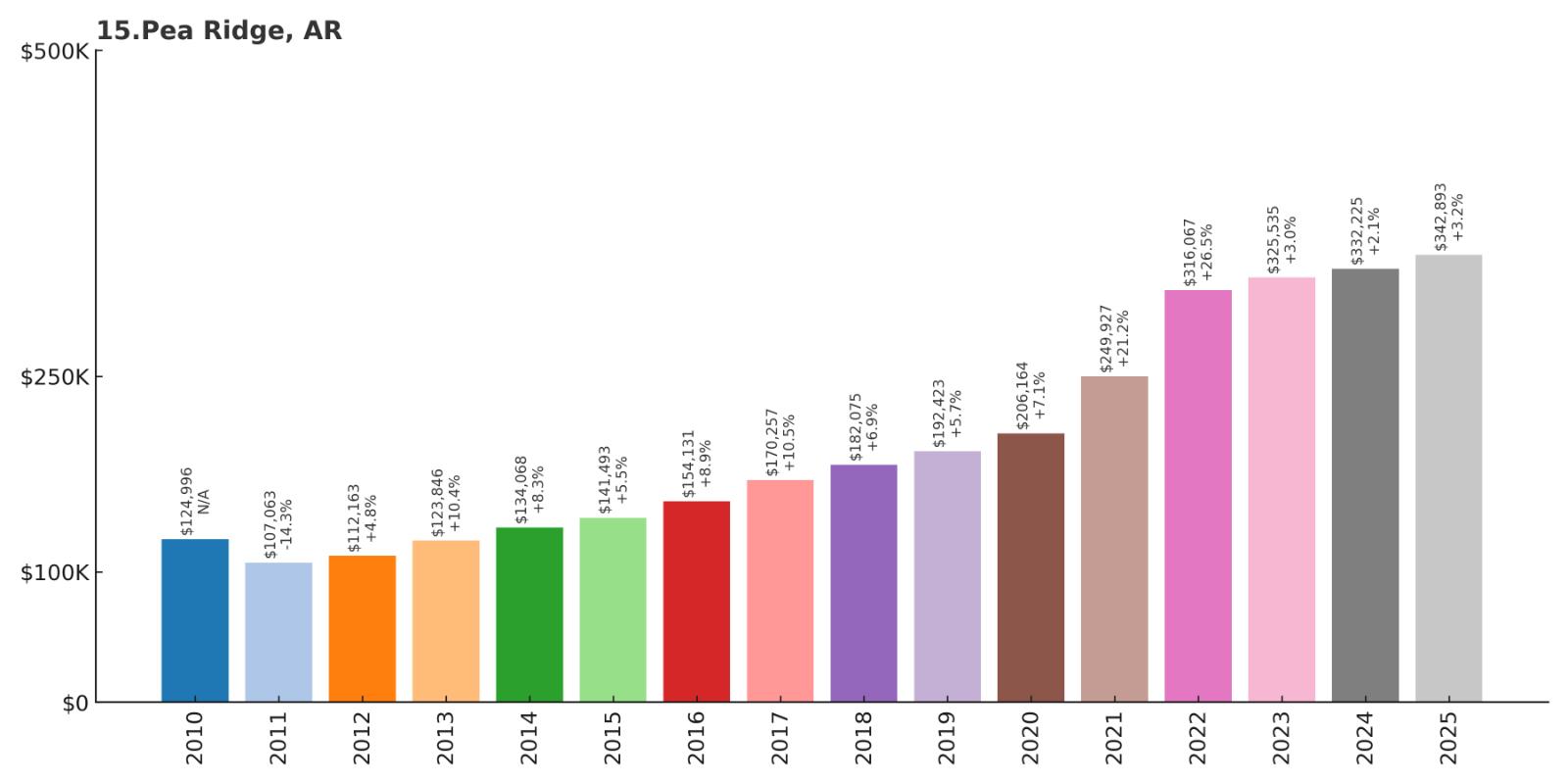
- 2010: $124,996
- 2011: $107,063
- 2012: $112,163
- 2013: $123,846
- 2014: $134,068
- 2015: $141,493
- 2016: $154,131
- 2017: $170,257
- 2018: $182,075
- 2019: $192,423
- 2020: $206,164
- 2021: $249,927
- 2022: $316,067
- 2023: $325,535
- 2024: $332,225
- 2025: $342,893
Pea Ridge achieved remarkable growth with values increasing 174% since 2010, reaching $342,893 by July 2025. The community demonstrated consistent appreciation through 2020, then accelerated significantly during the pandemic years. This growth reflects Pea Ridge’s appeal as an affordable Northwest Arkansas option with historical significance.
Why Pea Ridge?
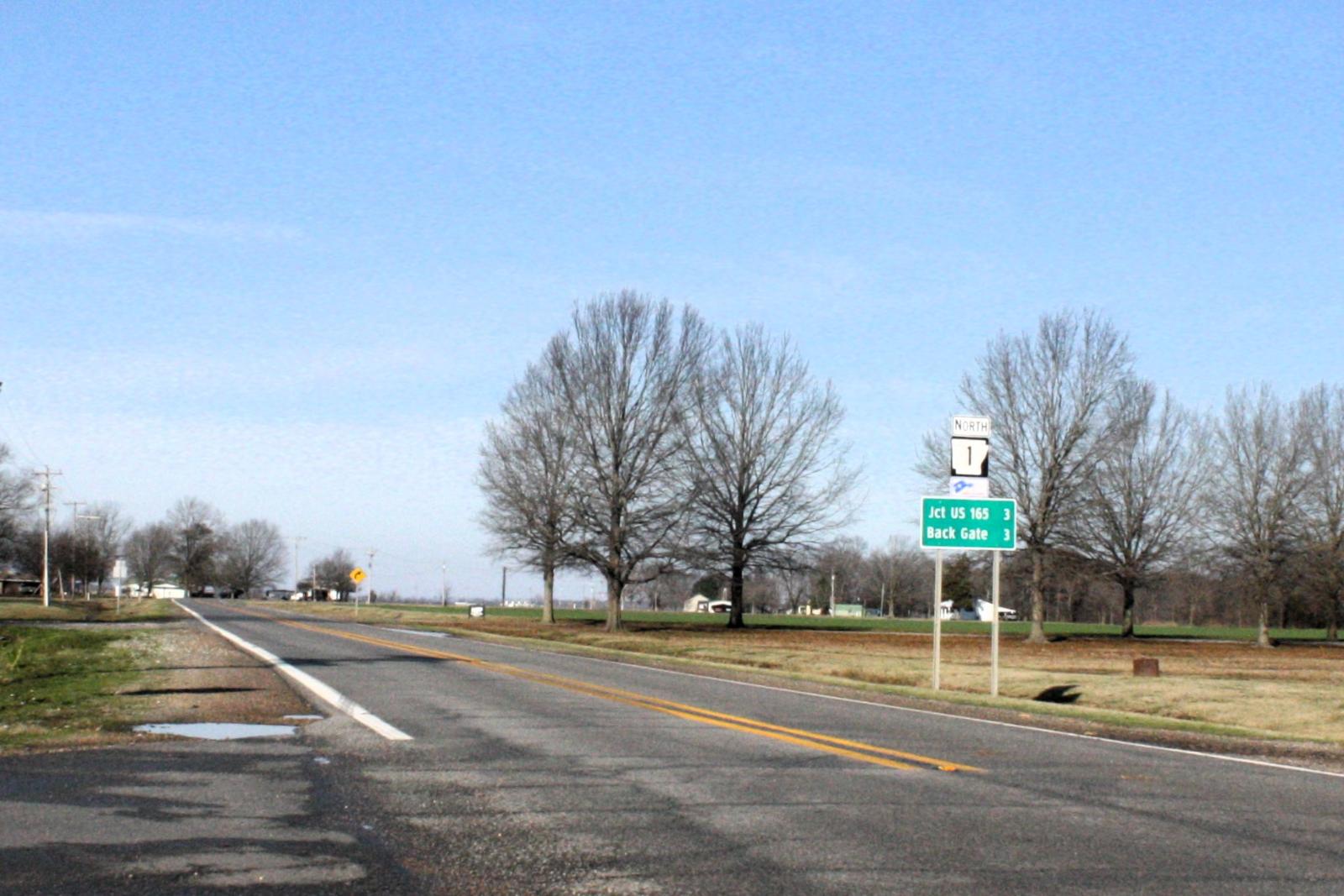
Why are people willing to pay so much to live here? What’s special about it?
Pea Ridge attracts residents with its combination of historical significance, natural beauty, and proximity to Northwest Arkansas employment centers. Home to the Pea Ridge National Military Park, the community offers unique recreational and educational opportunities. Families value the small-town atmosphere, excellent schools, and safe environment.
The city’s location provides reasonable commuting access to Bentonville and Rogers while maintaining affordable housing costs and rural character. Pea Ridge’s historical attractions and outdoor recreation opportunities create a distinctive lifestyle that appeals to diverse residents.
How Pea Ridge Rose to Prominence
Pea Ridge’s modern growth began with its recognition as a Civil War battlefield site and the establishment of Pea Ridge National Military Park. This historical significance, combined with the community’s location within the expanding Northwest Arkansas market, attracted residents seeking unique cultural amenities alongside economic opportunities.
The city’s development accelerated as families discovered its combination of affordability, historical character, and accessibility to major employment centers. Pea Ridge’s success in leveraging its historical assets while accommodating modern residential development has created a distinctive community identity within the region.
3 Interesting Tidbits
1. Civil War History – Home to Pea Ridge National Military Park, site of a significant Civil War battle that preserved Missouri for the Union.
2. Outdoor Recreation – Offers extensive hiking trails, historical interpretation, and natural areas through the national park system.
3. Cultural Assets – Combines historical significance with modern amenities, creating a unique community character that attracts diverse residents.
14. Johnson – 125% Home Price Increase Since 2010
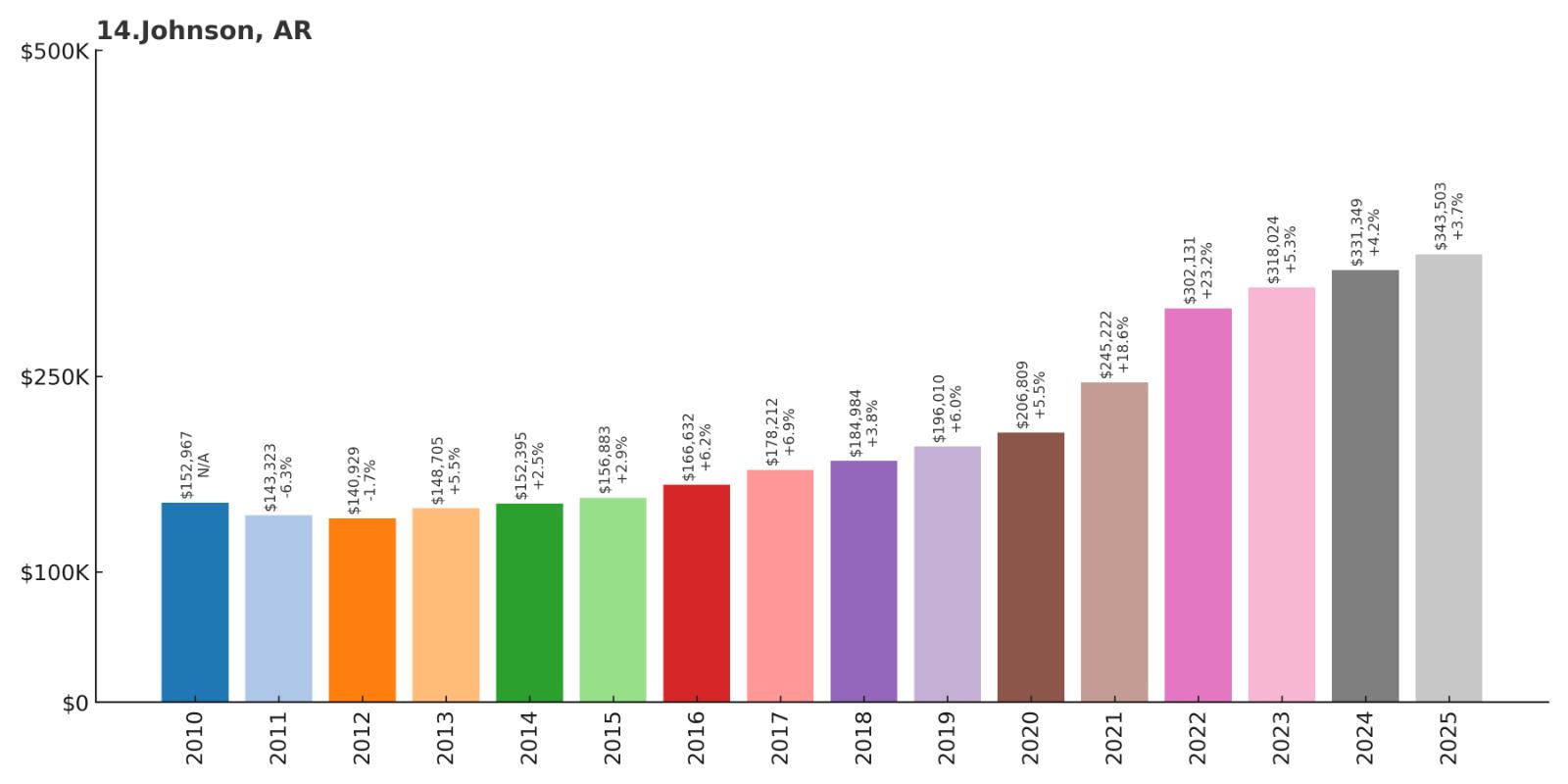
- 2010: $152,967
- 2011: $143,323
- 2012: $140,929
- 2013: $148,705
- 2014: $152,395
- 2015: $156,883
- 2016: $166,632
- 2017: $178,212
- 2018: $184,984
- 2019: $196,010
- 2020: $206,809
- 2021: $245,222
- 2022: $302,131
- 2023: $318,024
- 2024: $331,349
- 2025: $343,503
Johnson maintained steady appreciation through most of the period, with values increasing 125% since 2010 to reach $343,503 by July 2025. The community showed resilience during market fluctuations and accelerated growth after 2020, reflecting its appeal as a stable residential choice within Northwest Arkansas.
Why Johnson?
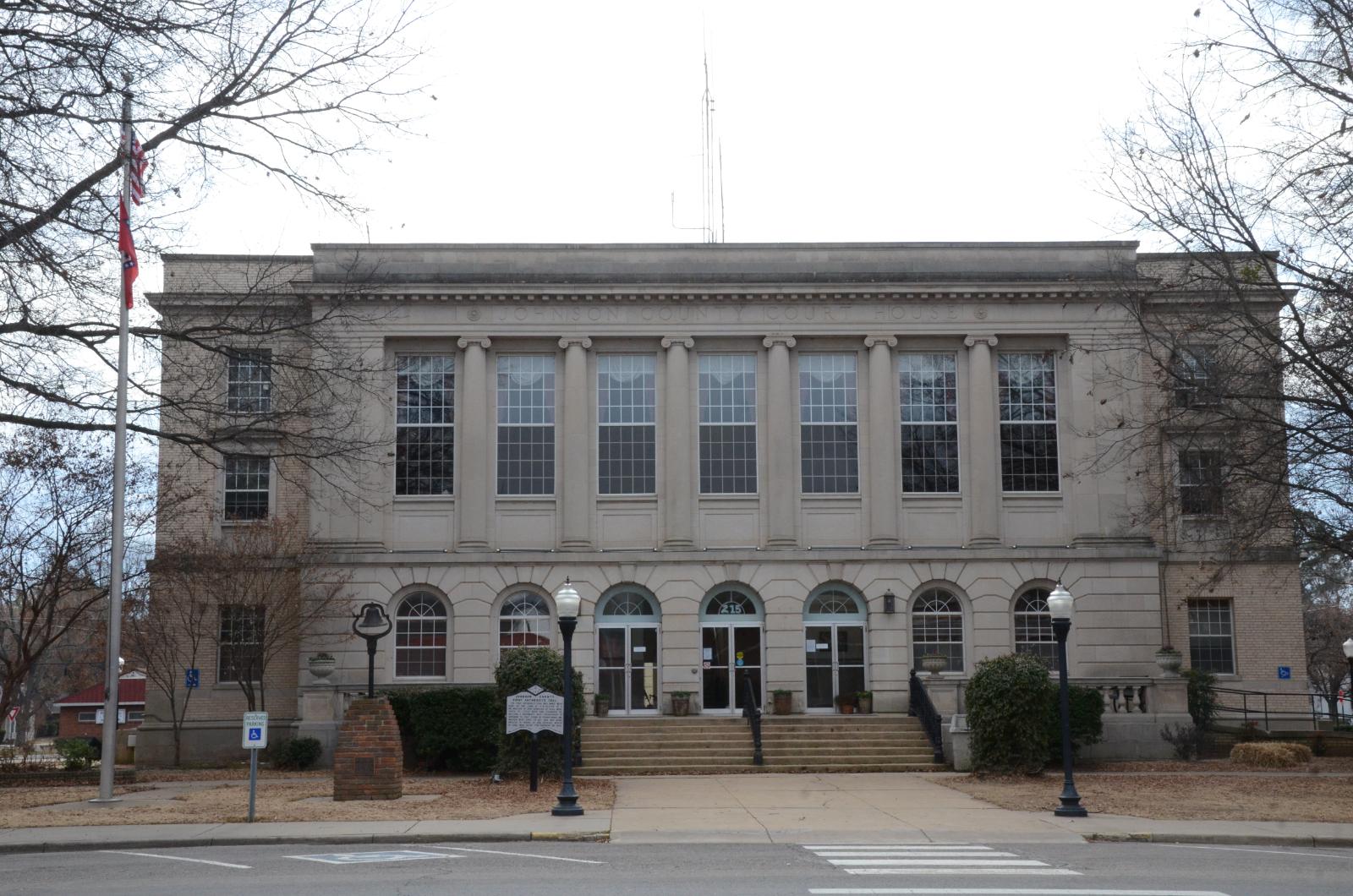
Why are people willing to pay so much to live here? What’s special about it?
Johnson attracts residents seeking a peaceful rural environment with convenient access to major Northwest Arkansas employment centers. The community offers larger residential lots, scenic countryside, and a strong agricultural heritage that appeals to families wanting space and tranquility. Residents value the slower pace of life and community connections.
The area’s location provides reasonable commuting access to Fayetteville, Springdale, and other employment centers while maintaining rural character and affordability. Johnson’s development patterns emphasize preserving open space and agricultural land while accommodating residential growth.
How Johnson Rose to Prominence
Johnson evolved from a traditional farming community into a desirable residential area as Northwest Arkansas’s economic expansion created demand for rural housing options. The town’s location and agricultural heritage attracted families seeking larger lots and country living while maintaining access to employment opportunities.
The community’s careful approach to growth and development helped preserve its rural character while accommodating new residents. Johnson’s success in balancing development with agricultural preservation has made it increasingly attractive to professionals seeking alternatives to suburban living patterns.
3 Interesting Tidbits
1. Agricultural Heritage – Maintains strong farming traditions and rural character while accommodating residential development.
2. Scenic Setting – Located in rolling countryside that provides residents with natural beauty and outdoor recreation opportunities.
3. Space and Privacy – Offers larger residential lots and rural living while maintaining reasonable access to Northwest Arkansas employment.
13. Gravette – 251% Home Price Increase Since 2010
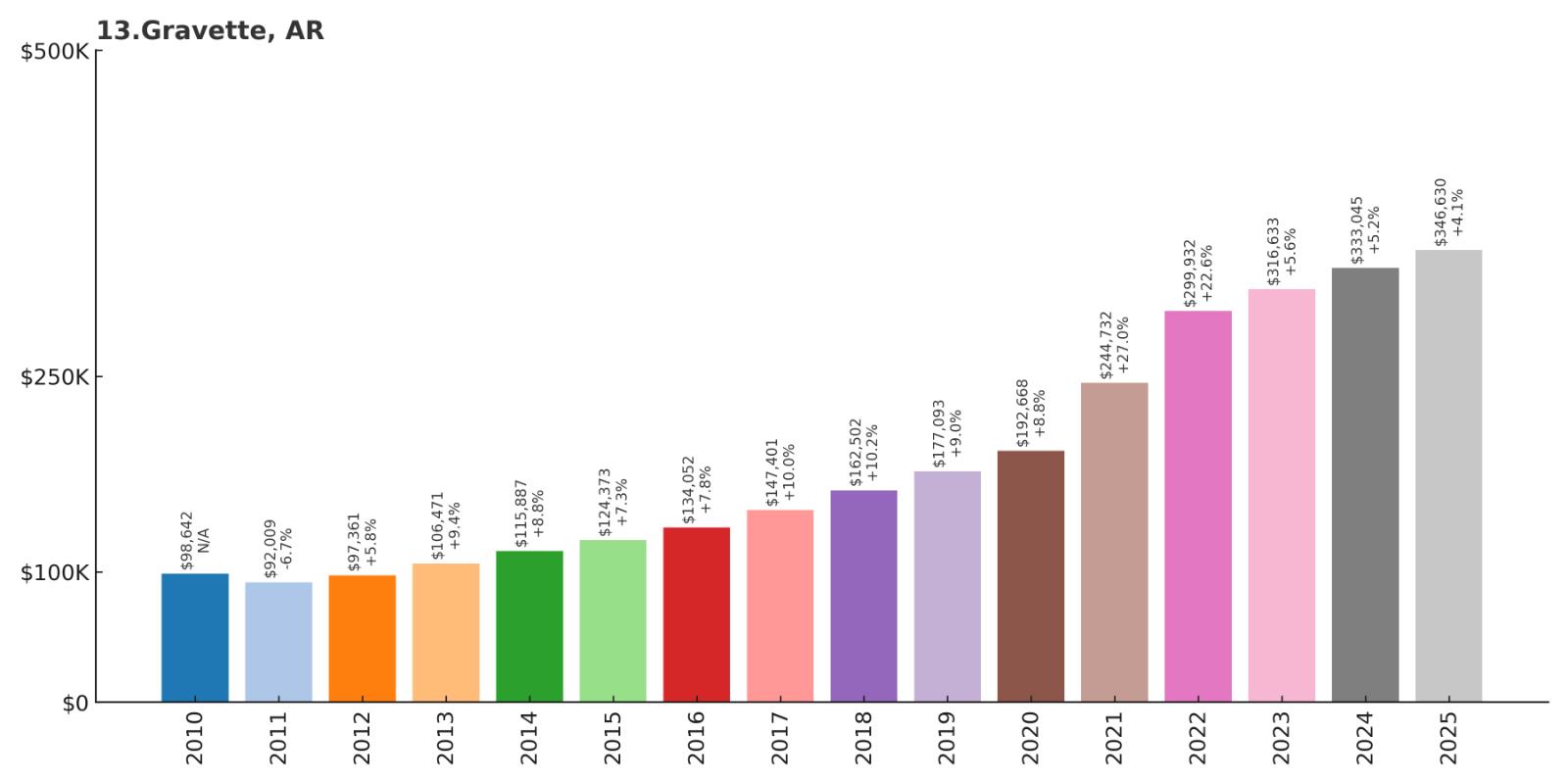
- 2010: $98,642
- 2011: $92,009
- 2012: $97,361
- 2013: $106,471
- 2014: $115,887
- 2015: $124,373
- 2016: $134,052
- 2017: $147,401
- 2018: $162,502
- 2019: $177,093
- 2020: $192,668
- 2021: $244,732
- 2022: $299,932
- 2023: $316,633
- 2024: $333,045
- 2025: $346,630
Gravette achieved the most dramatic appreciation among all Arkansas towns, with values increasing an extraordinary 251% since 2010. Starting from under $100,000, median home prices reached $346,630 by July 2025. This remarkable growth reflects the community’s transformation from an affordable rural town into a sought-after residential destination.
Why Gravette?

Why are people willing to pay so much to live here? What’s special about it?
Gravette offers exceptional value for families seeking small-town charm with modern conveniences. The community provides excellent schools, safe neighborhoods, and a strong sense of community while maintaining reasonable commuting access to Northwest Arkansas employment centers. Residents appreciate the peaceful environment and friendly atmosphere.
The city’s careful growth management has preserved its character while adding amenities and services. Gravette’s location near the Missouri border provides additional shopping and entertainment options while maintaining Arkansas’s favorable tax environment.
How Gravette Rose to Prominence
Gravette transformed from a small agricultural community into a desirable residential destination as Northwest Arkansas’s economic influence expanded beyond traditional boundaries. The town’s affordable housing, available land, and quality schools attracted families seeking alternatives to higher-priced areas closer to major employment centers.
The community’s strategic location and commitment to controlled growth helped it capitalize on spillover demand from the broader Northwest Arkansas market. Gravette’s success in maintaining small-town character while accommodating growth has made it increasingly attractive to families and professionals throughout the region.
3 Interesting Tidbits
1. Growth Champion – Achieved the highest home price appreciation in Arkansas at 251%, demonstrating exceptional market demand and value creation.
2. Border Benefits – Located near Missouri, providing residents with additional shopping and entertainment options while maintaining Arkansas tax advantages.
3. Value Discovery – Transformed from one of Arkansas’s most affordable communities into a sought-after residential destination through strategic growth and development.
12. Lowell – 162% Home Price Increase Since 2010
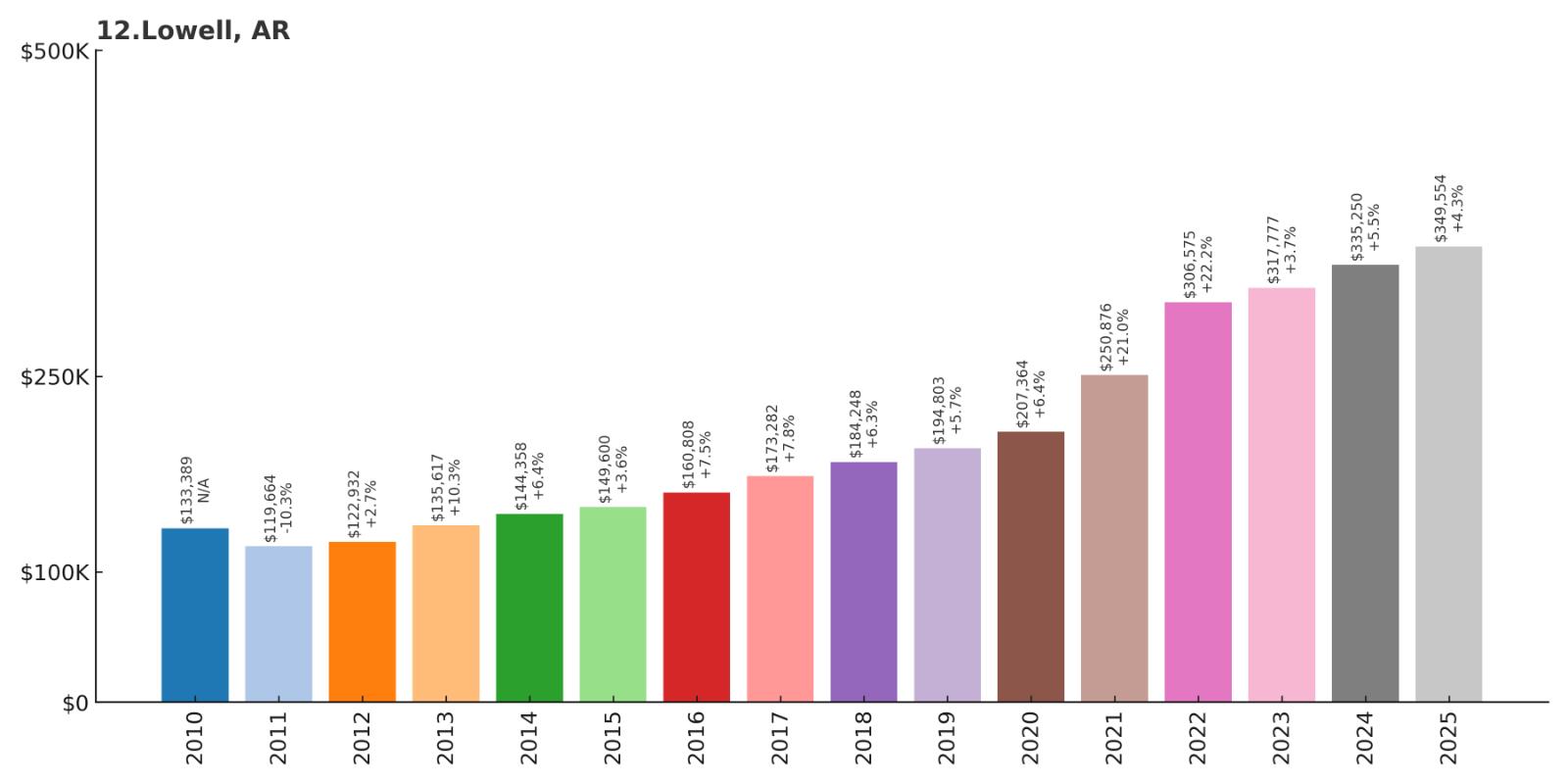
- 2010: $133,389
- 2011: $119,664
- 2012: $122,932
- 2013: $135,617
- 2014: $144,358
- 2015: $149,600
- 2016: $160,808
- 2017: $173,282
- 2018: $184,248
- 2019: $194,803
- 2020: $207,364
- 2021: $250,876
- 2022: $306,575
- 2023: $317,777
- 2024: $335,250
- 2025: $349,554
Lowell demonstrated consistent appreciation throughout the period, with values increasing 162% since 2010 to reach $349,554 by July 2025. The community benefited from steady growth through 2020, followed by significant acceleration that reflects its appeal as an affordable alternative within the greater Northwest Arkansas market.
Why Lowell?

Why are people willing to pay so much to live here? What’s special about it?
Lowell attracts residents seeking affordability and accessibility within the thriving Northwest Arkansas region. The community offers family-friendly neighborhoods, good schools, and convenient access to major employment centers. Families value the small-town atmosphere combined with modern amenities and services.
The city’s location provides easy commuting to Bentonville, Rogers, and Fayetteville while maintaining more affordable housing costs than established areas. Lowell’s growth and development have created opportunities for new businesses and services while preserving community character.
How Lowell Rose to Prominence
Lowell evolved from a small railroad town into a growing suburban community as Northwest Arkansas’s economy expanded. The city’s location along major transportation corridors positioned it perfectly to capture residential demand from workers in nearby employment centers. Lowell’s affordable land and development opportunities attracted builders and families throughout the 2000s and 2010s.
The community’s strategic investments in infrastructure and amenities helped support its growth while maintaining affordability relative to other Northwest Arkansas cities. Lowell’s success in balancing growth with community character has established it as a desirable residential destination for families seeking value and convenience.
3 Interesting Tidbits
1. Transportation Hub – Located along major highways and rail lines, providing excellent connectivity throughout Northwest Arkansas.
2. Family Focus – Emphasizes family-friendly development and amenities, attracting residents seeking safe, affordable suburban living.
3. Value Alternative – Offers more affordable housing options while maintaining access to Northwest Arkansas employment and amenities.
11. Centerton – 158% Home Price Increase Since 2010
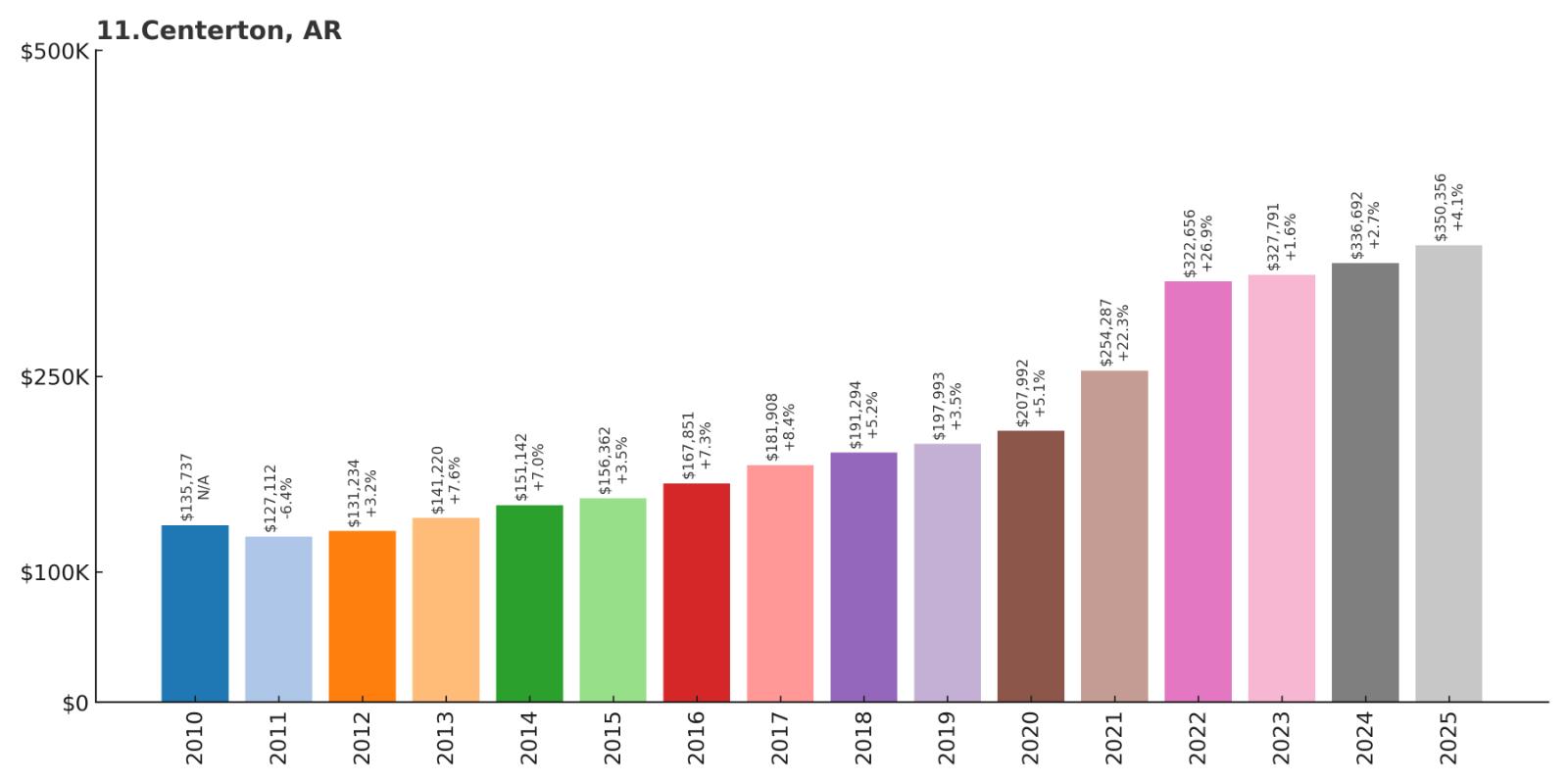
- 2010: $135,737
- 2011: $127,112
- 2012: $131,234
- 2013: $141,220
- 2014: $151,142
- 2015: $156,362
- 2016: $167,851
- 2017: $181,908
- 2018: $191,294
- 2019: $197,993
- 2020: $207,992
- 2021: $254,287
- 2022: $322,656
- 2023: $327,791
- 2024: $336,692
- 2025: $350,356
Centerton experienced steady growth through 2020, followed by rapid acceleration that brought values to $350,356 by July 2025. This 158% increase since 2010 reflects the community’s transformation from a small town into a desirable suburban destination within the Bentonville metropolitan area.
Why Centerton?

Why are people willing to pay so much to live here? What’s special about it?
Centerton appeals to families seeking newer suburban development with excellent schools and modern amenities. The community offers a perfect balance of small-town charm and contemporary convenience, with new subdivisions and family-friendly infrastructure. Residents appreciate the safe environment and strong sense of community.
The city’s rapid growth and development have created opportunities for new businesses and services while maintaining manageable traffic and congestion. Centerton’s location provides easy access to Bentonville employment while offering more affordable housing options than established areas.
How Centerton Rose to Prominence
Centerton transformed from a small agricultural community into one of Arkansas’s fastest-growing cities as Northwest Arkansas’s economy boomed. The city’s strategic location near Bentonville and available land for development attracted builders and families seeking newer housing options. Centerton’s incorporation and planned growth management helped guide its rapid expansion.
The community’s development accelerated in the 2000s and 2010s as Walmart’s expansion and Northwest Arkansas’s economic growth created demand for suburban housing. Centerton’s success in managing rapid growth while maintaining community character has made it a model for suburban development in the region.
3 Interesting Tidbits
1. Rapid Growth – Experienced 53% population growth over five years, making it one of Arkansas’s fastest-expanding communities.
2. Modern Development – Features newer subdivisions and contemporary amenities, attracting families seeking modern suburban living.
3. Strategic Location – Positioned perfectly between major Northwest Arkansas employment centers, offering residents convenient commuting options.
10. Bella Vista – 143% Home Price Increase Since 2010
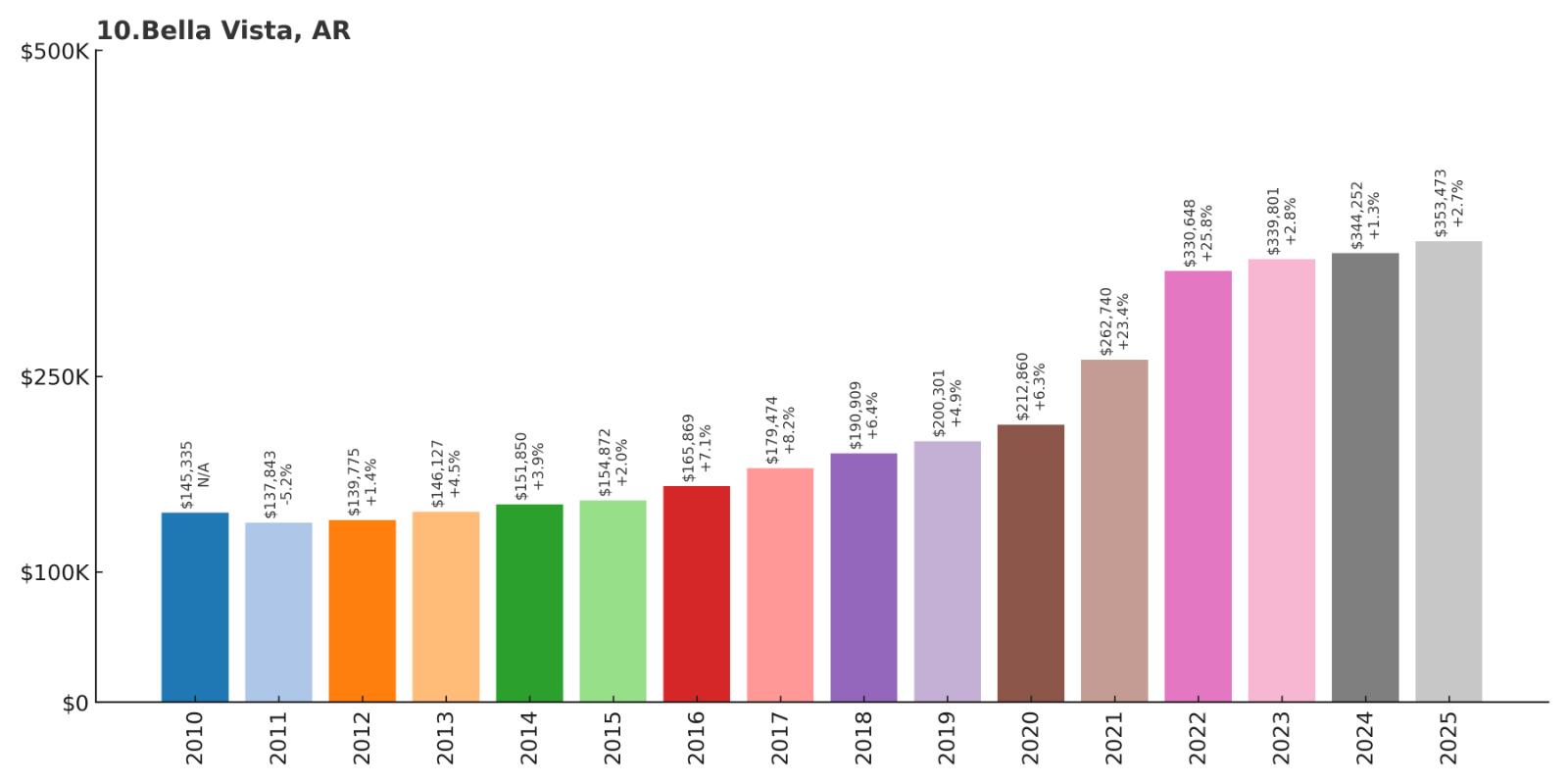
- 2010: $145,335
- 2011: $137,843
- 2012: $139,775
- 2013: $146,127
- 2014: $151,850
- 2015: $154,872
- 2016: $165,869
- 2017: $179,474
- 2018: $190,909
- 2019: $200,301
- 2020: $212,860
- 2021: $262,740
- 2022: $330,648
- 2023: $339,801
- 2024: $344,252
- 2025: $353,473
Bella Vista showed consistent appreciation through 2020, then experienced substantial acceleration in subsequent years. Values increased 143% since 2010, reaching $353,473 by July 2025. This resort community’s growth reflects its appeal to retirees and families seeking recreational amenities combined with proximity to Northwest Arkansas employment.
Why Bella Vista?
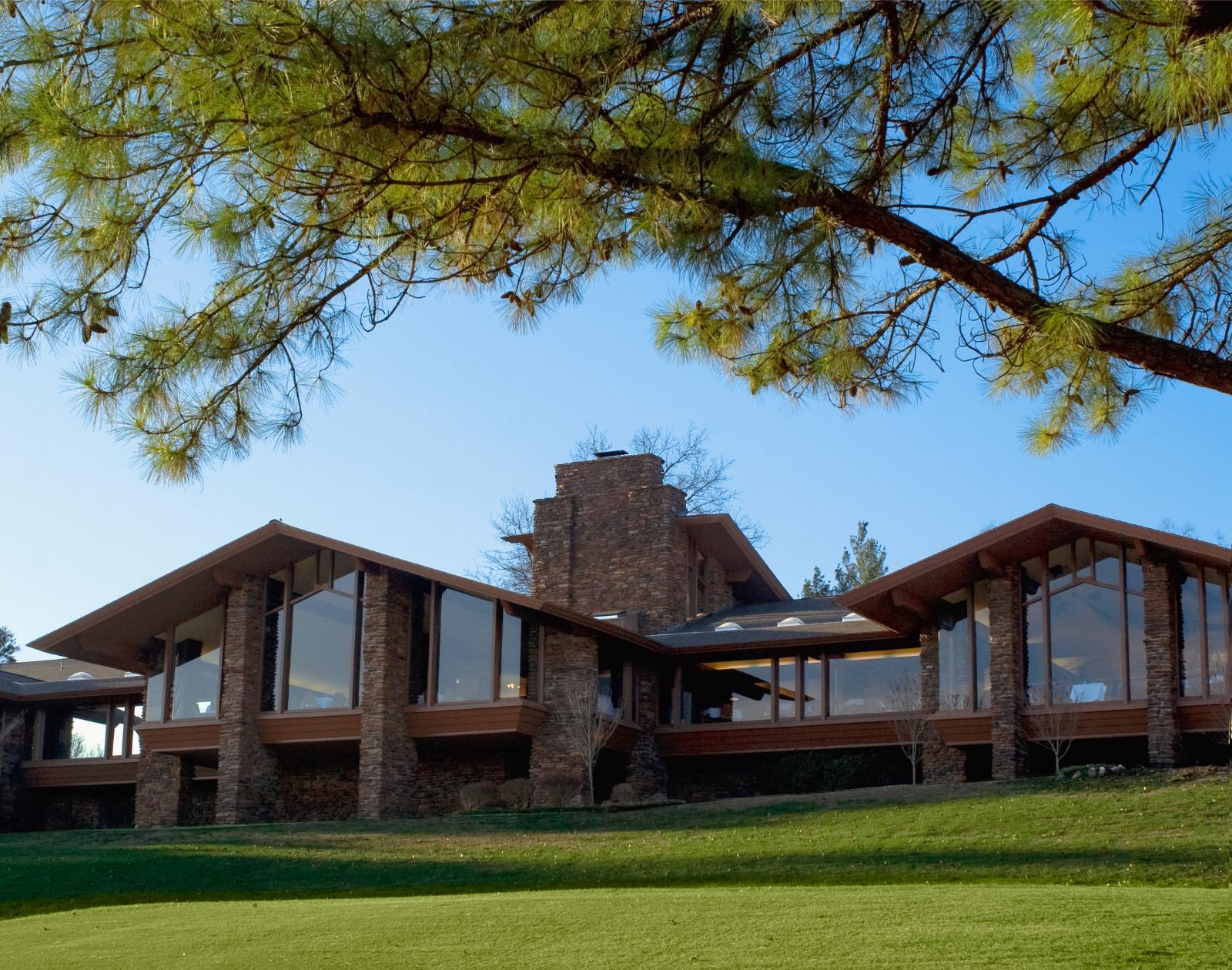
Why are people willing to pay so much to live here? What’s special about it?
Bella Vista attracts residents with its extensive recreational amenities, including multiple golf courses, lakes, and hiking trails. The planned community offers resort-style living with year-round activities and social opportunities. Retirees particularly value the community’s amenities, safety, and organized activities.
Families choose Bella Vista for its excellent schools, family-friendly environment, and recreational opportunities. The community’s location provides easy access to Northwest Arkansas employment while offering a vacation-like lifestyle year-round.
How Bella Vista Rose to Prominence
Bella Vista began as a resort development in the 1960s, designed as a retirement and recreational community in the Arkansas Ozarks. The master-planned community attracted retirees and vacation home buyers with its golf courses, lakes, and recreational facilities. Over time, Bella Vista evolved into a year-round residential community as Northwest Arkansas’s economy expanded.
The community’s appeal broadened beyond retirees as families discovered its amenities and school districts. Bella Vista’s transformation from a seasonal resort to a thriving residential community reflects both its original planning vision and its adaptation to changing demographic and economic conditions in Northwest Arkansas.
3 Interesting Tidbits
1. Golf Paradise – Features multiple championship golf courses designed for players of all skill levels, making it a golfer’s dream destination.
2. Master Planned – Originally developed as a planned resort community in the 1960s, with extensive recreational amenities and organized activities.
3. Lake Living – Offers access to multiple lakes and water activities, providing residents with extensive recreational opportunities.
9. Hindsville – 130% Home Price Increase Since 2010
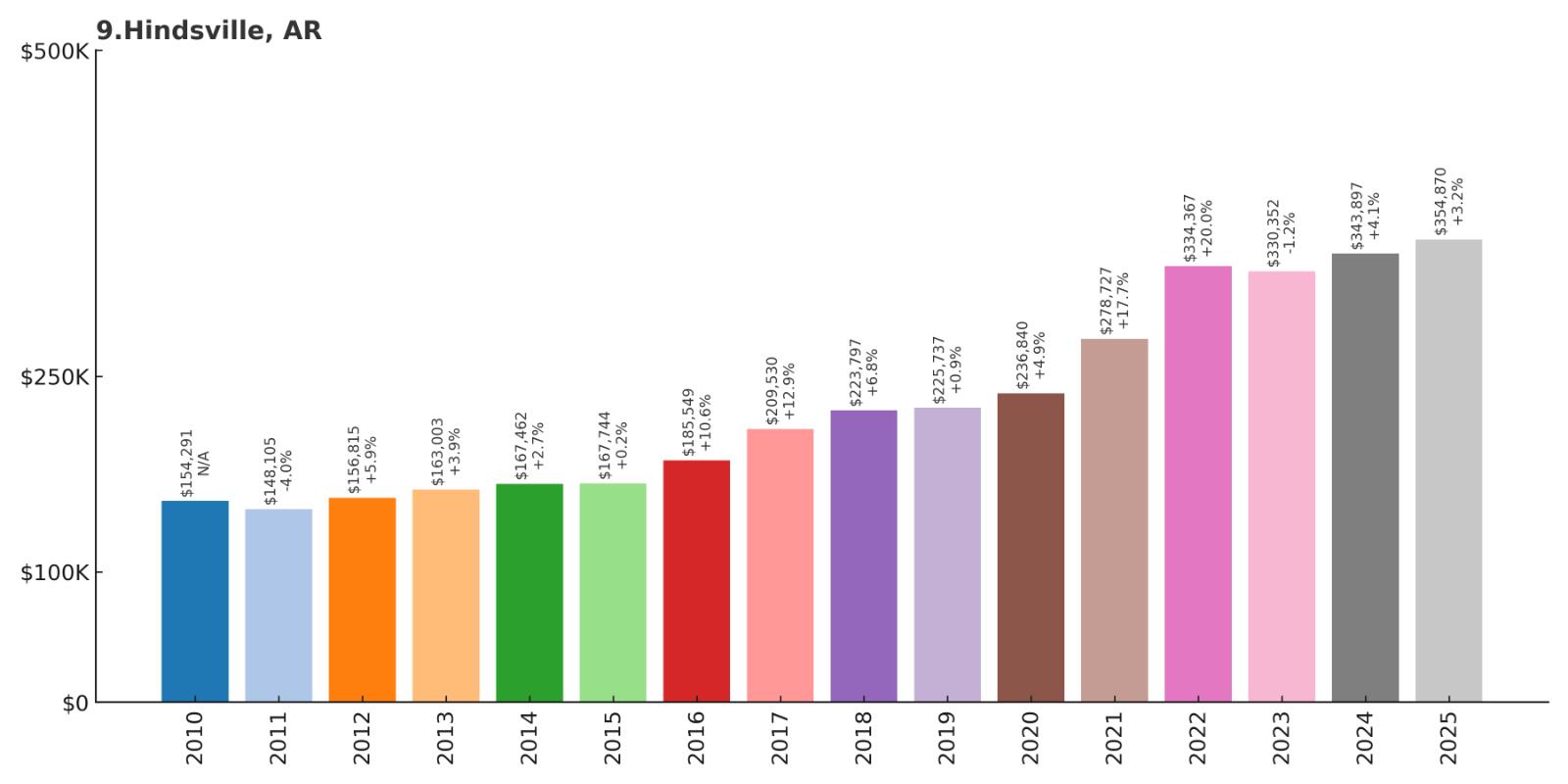
- 2010: $154,291
- 2011: $148,105
- 2012: $156,815
- 2013: $163,003
- 2014: $167,462
- 2015: $167,744
- 2016: $185,549
- 2017: $209,530
- 2018: $223,797
- 2019: $225,737
- 2020: $236,840
- 2021: $278,727
- 2022: $334,367
- 2023: $330,352
- 2024: $343,897
- 2025: $354,870
Hindsville demonstrated steady growth through 2020, then accelerated significantly in subsequent years. Values increased 130% since 2010, reaching $354,870 by July 2025. This small community benefits from its location within the greater Northwest Arkansas market while maintaining rural character and affordability relative to urban centers.
Why Hindsville?

Why are people willing to pay so much to live here? What’s special about it?
Hindsville appeals to residents seeking rural tranquility with reasonable access to Northwest Arkansas employment opportunities. The community offers larger residential lots, peaceful surroundings, and a strong sense of neighborly connection. Families appreciate the slower pace of life combined with modern conveniences and infrastructure.
The area’s agricultural heritage and scenic landscape attract buyers looking for country living without complete isolation. Hindsville’s location provides commuting access to major employers while maintaining the charm and affordability of small-town Arkansas.
How Hindsville Rose to Prominence
Hindsville began as a small farming community in the Arkansas Ozarks, maintaining its agricultural character through most of the 20th century. The town’s residential appeal grew as Northwest Arkansas’s economic expansion created demand for housing beyond traditional suburban areas. Professionals seeking larger lots and rural settings discovered Hindsville’s advantages.
The community’s transformation accelerated during the 2010s and 2020s as remote work opportunities and lifestyle preferences shifted toward less dense living arrangements. Hindsville’s combination of affordable land, natural beauty, and proximity to economic opportunities positioned it as an attractive alternative to traditional suburban development.
3 Interesting Tidbits
1. Rural Refuge – Offers large residential lots and agricultural character while maintaining access to Northwest Arkansas employment centers.
2. Scenic Setting – Located in the Arkansas Ozarks, providing residents with natural beauty and outdoor recreation opportunities.
3. Community Character – Maintains small-town atmosphere and neighborly connections despite proximity to major metropolitan areas.
8. Fayetteville – 117% Home Price Increase Since 2010
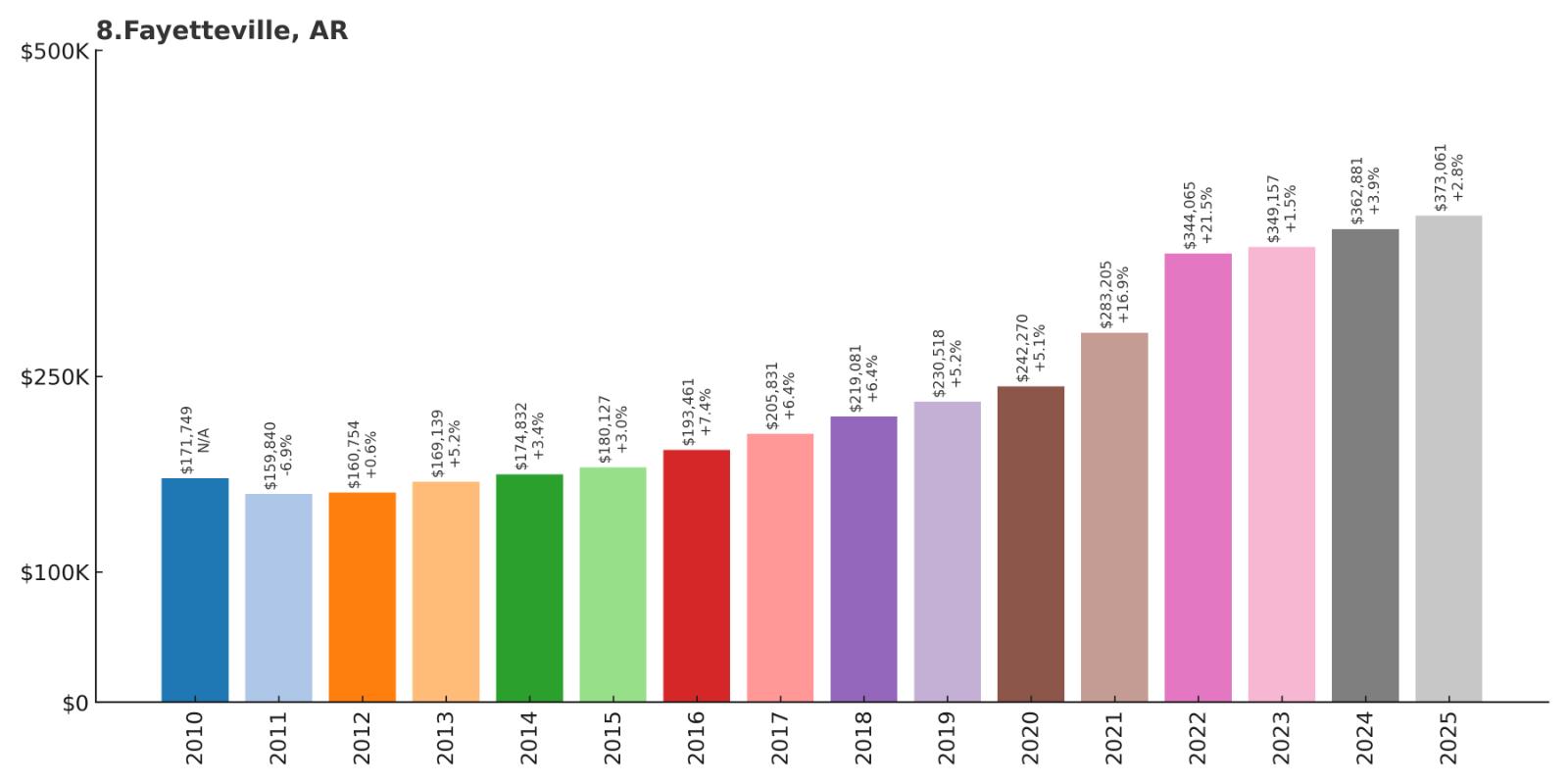
- 2010: $171,749
- 2011: $159,840
- 2012: $160,754
- 2013: $169,139
- 2014: $174,832
- 2015: $180,127
- 2016: $193,461
- 2017: $205,831
- 2018: $219,081
- 2019: $230,518
- 2020: $242,270
- 2021: $283,205
- 2022: $344,065
- 2023: $349,157
- 2024: $362,881
- 2025: $373,061
Fayetteville maintained steady growth throughout the period, more than doubling in value since 2010. The University of Arkansas anchor provided stability during market fluctuations, while post-2020 acceleration brought median values to $373,061 by July 2025. This growth reflects Fayetteville’s status as Northwest Arkansas’s largest city and cultural center.
Why Fayetteville?

Why are people willing to pay so much to live here? What’s special about it?
Fayetteville combines university town energy with economic opportunity, creating a unique blend of culture and career prospects. Home to the University of Arkansas, the city offers excellent educational resources, healthcare facilities, and cultural amenities. The vibrant downtown area, diverse dining scene, and active arts community attract both young professionals and established families.
Residents value Fayetteville’s progressive atmosphere, walkable neighborhoods, and abundant recreational opportunities. The city’s location in the Ozark Mountains provides natural beauty and outdoor activities, while its size offers urban amenities without big-city drawbacks.
How Fayetteville Rose to Prominence
Founded in 1828 and home to the University of Arkansas since 1871, Fayetteville has long served as Northwest Arkansas’s educational and cultural center. The university’s growth and research programs attracted businesses and professionals, creating a stable economic foundation that supported residential development throughout the 20th century.
As Northwest Arkansas emerged as an economic powerhouse, Fayetteville leveraged its educational assets and quality of life advantages to compete for residents and businesses. The city’s investments in downtown revitalization, cultural amenities, and infrastructure helped maintain its position as the region’s largest city and a desirable place to live.
3 Interesting Tidbits
1. University Anchor – Home to the University of Arkansas flagship campus with over 22,000 students, providing economic stability and cultural vibrancy.
2. Mountain Location – Situated in the scenic Ozark Mountains, offering residents natural beauty and extensive outdoor recreation opportunities.
3. Cultural Hub – Features a thriving arts scene, diverse dining options, and progressive community atmosphere that distinguishes it from other Arkansas cities.
7. Rogers – 159% Home Price Increase Since 2010
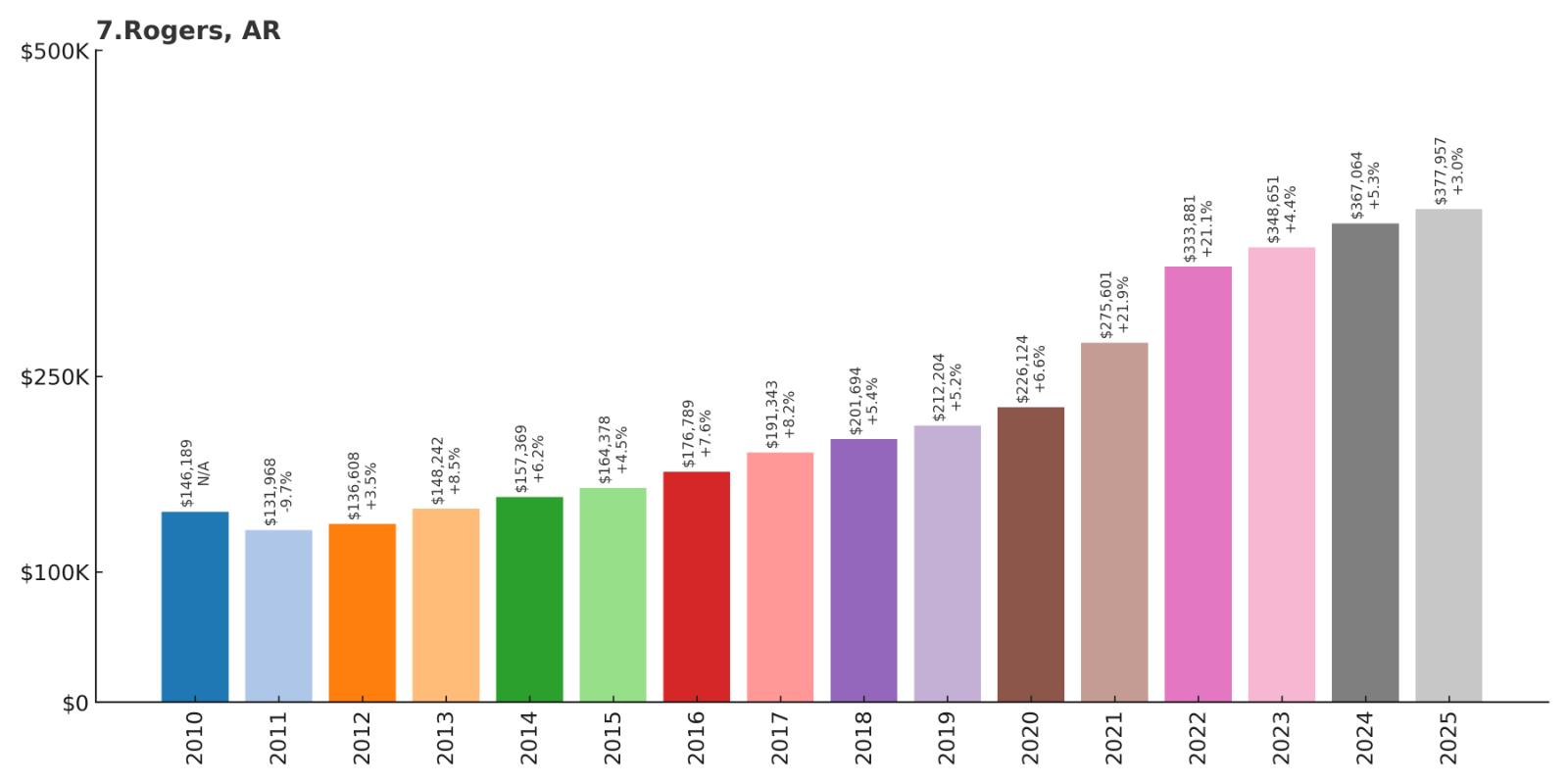
- 2010: $146,189
- 2011: $131,968
- 2012: $136,608
- 2013: $148,242
- 2014: $157,369
- 2015: $164,378
- 2016: $176,789
- 2017: $191,343
- 2018: $201,694
- 2019: $212,204
- 2020: $226,124
- 2021: $275,601
- 2022: $333,881
- 2023: $348,651
- 2024: $367,064
- 2025: $377,957
Rogers showed steady progression through 2020, then experienced strong acceleration in subsequent years. Values more than doubled from their 2011 low point, reaching $377,957 by July 2025. The consistent growth reflects Rogers’ position as a major retail and employment hub within Northwest Arkansas.
Why Rogers?
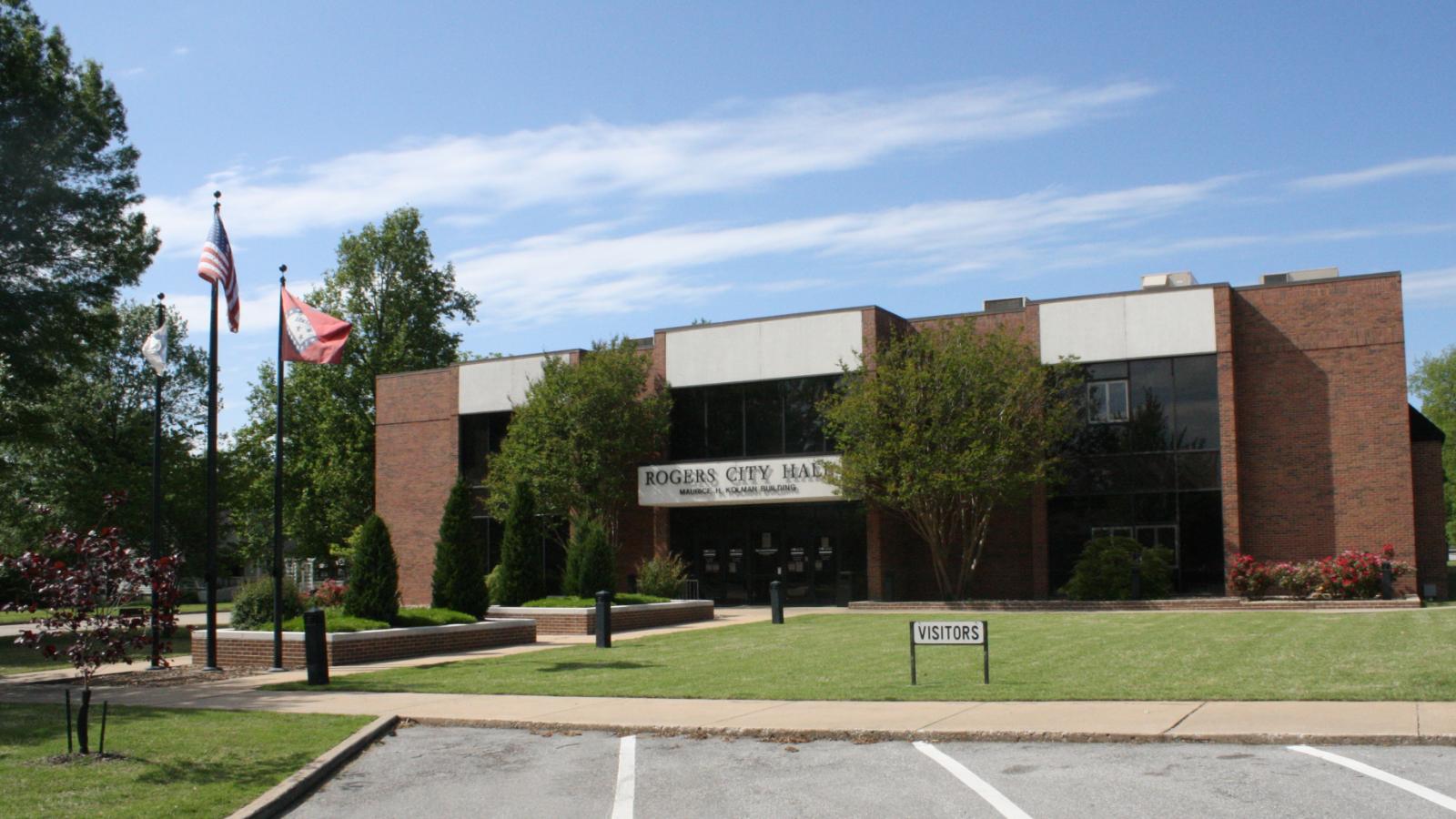
Why are people willing to pay so much to live here? What’s special about it?
Rogers attracts families and professionals with its blend of established neighborhoods and modern amenities. The city anchors the Pinnacle Hills area, home to major shopping, dining, and corporate offices including PepsiCo, Nestlé, and General Mills. Residents enjoy excellent schools, recreational facilities, and easy access to employment throughout Northwest Arkansas.
The community offers both affordable starter homes and upscale neighborhoods, creating opportunities for residents to grow within the same city. Rogers’ mature infrastructure, diverse housing stock, and central location make it particularly appealing to families seeking stability and convenience.
How Rogers Rose to Prominence
Rogers emerged as a railroad town in the 1880s and remained a modest agricultural center until the late 20th century. The city’s transformation accelerated with the development of the Pinnacle Hills area in the 1990s and 2000s, which attracted major retailers and corporate offices. This commercial success translated into residential demand and property value growth.
As Northwest Arkansas evolved into an economic powerhouse, Rogers positioned itself as the region’s retail and entertainment hub. The city’s strategic investments in infrastructure and amenities, combined with its proximity to Bentonville’s corporate headquarters, established Rogers as a desirable residential destination for professionals throughout the region.
3 Interesting Tidbits
1. Corporate Hub – Hosts major corporate offices in Pinnacle Hills, including facilities for PepsiCo, Nestlé, General Mills, and Johnson & Johnson.
2. Retail Destination – Pinnacle Hills Promenade serves as Northwest Arkansas’s premier shopping and entertainment district, drawing visitors region-wide.
3. Historic Railroad – Originally founded as a railroad town in the 1880s, Rogers maintains its transportation heritage while embracing modern economic development.
6. Garfield – 180% Home Price Increase Since 2010
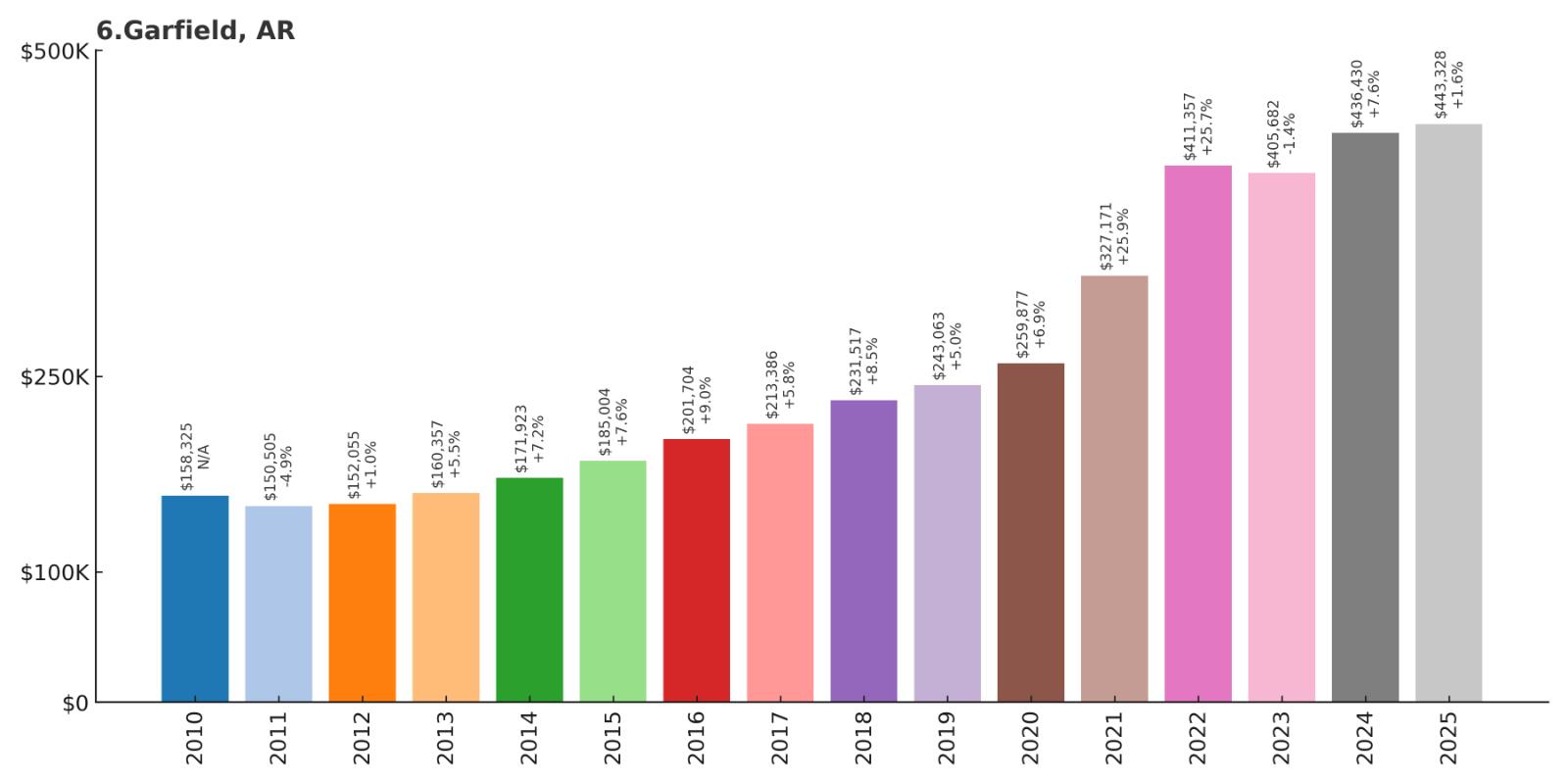
- 2010: $158,325
- 2011: $150,505
- 2012: $152,055
- 2013: $160,357
- 2014: $171,923
- 2015: $185,004
- 2016: $201,704
- 2017: $213,386
- 2018: $231,517
- 2019: $243,063
- 2020: $259,877
- 2021: $327,171
- 2022: $411,357
- 2023: $405,682
- 2024: $436,430
- 2025: $443,328
Garfield achieved the highest appreciation rate among Arkansas’s most expensive towns, with values increasing 180% since 2010. The community experienced particularly dramatic growth after 2020, with median home prices reaching $443,328 by July 2025. This remarkable appreciation reflects strong demand in the greater Northwest Arkansas region.
Why Garfield?
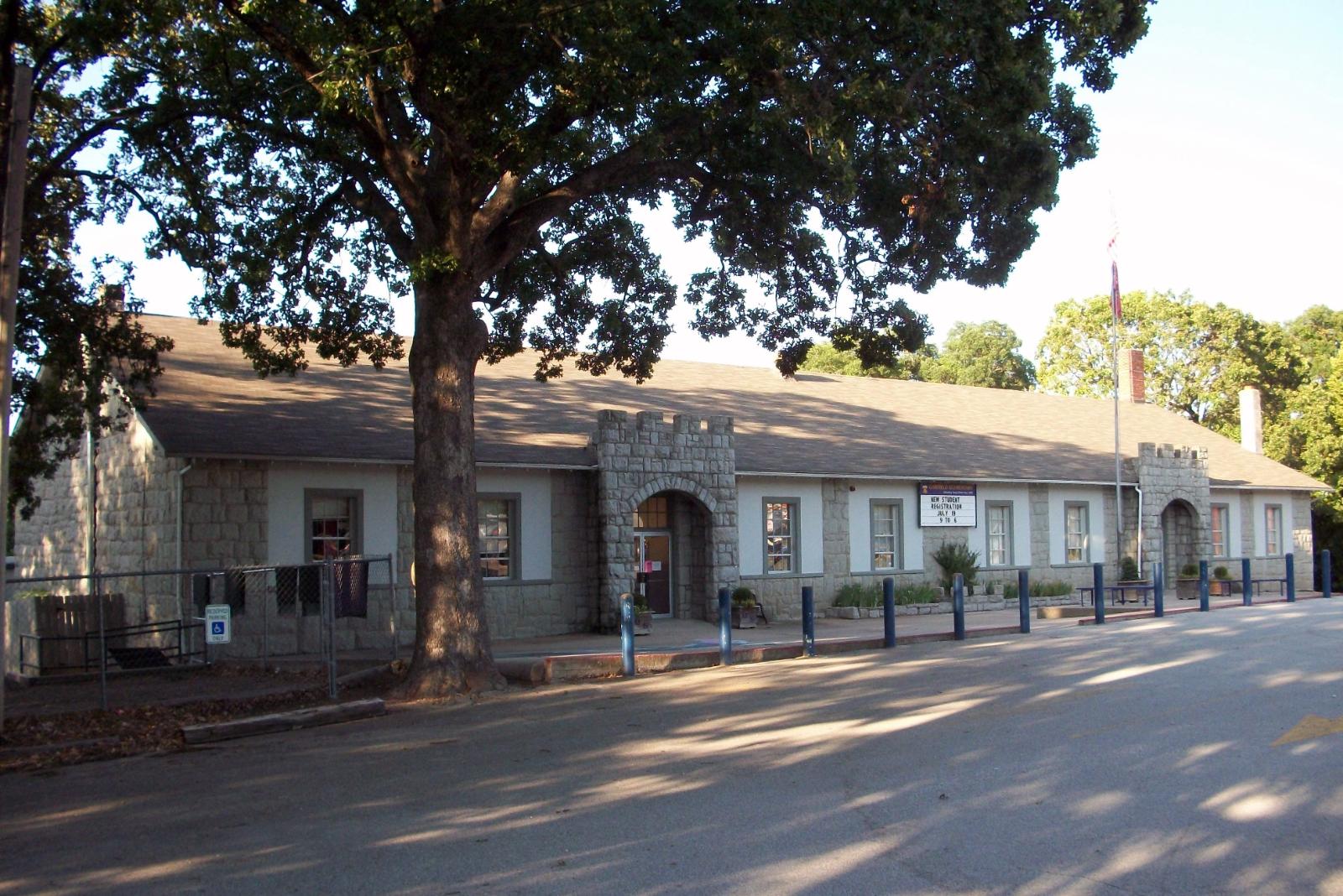
Why are people willing to pay so much to live here? What’s special about it?
Garfield attracts residents seeking small-town tranquility within Northwest Arkansas’s economic powerhouse region. The community offers rural charm, larger lots, and newer residential development while maintaining easy access to major employment centers. Families value the peaceful environment and strong sense of community.
The area’s location provides an ideal balance between rural living and urban amenities, appealing to professionals who want space and privacy without sacrificing career opportunities. Garfield’s development patterns emphasize quality over density, creating an exclusive residential environment.
How Garfield Rose to Prominence
Garfield transformed from a small agricultural community into a desirable residential destination as Northwest Arkansas’s economy expanded. The town’s strategic location and available land attracted developers and buyers seeking alternatives to denser suburban areas. Its proximity to major highways and employment centers fueled residential growth.
The community’s evolution accelerated during the 2010s and 2020s as professionals increasingly sought larger residential lots and custom homes. Garfield’s careful development approach and small-town character attracted families looking for upscale rural living within the region’s thriving economic corridor.
3 Interesting Tidbits
1. Appreciation Champion – Led Arkansas with an extraordinary 180% home price increase since 2010, demonstrating exceptional market demand.
2. Rural Luxury – Combines small-town charm with upscale residential development, attracting buyers seeking exclusive country living.
3. Strategic Growth – Benefits from Northwest Arkansas’s economic boom while maintaining its distinct community character and rural appeal.
5. Bentonville – 167% Home Price Increase Since 2010
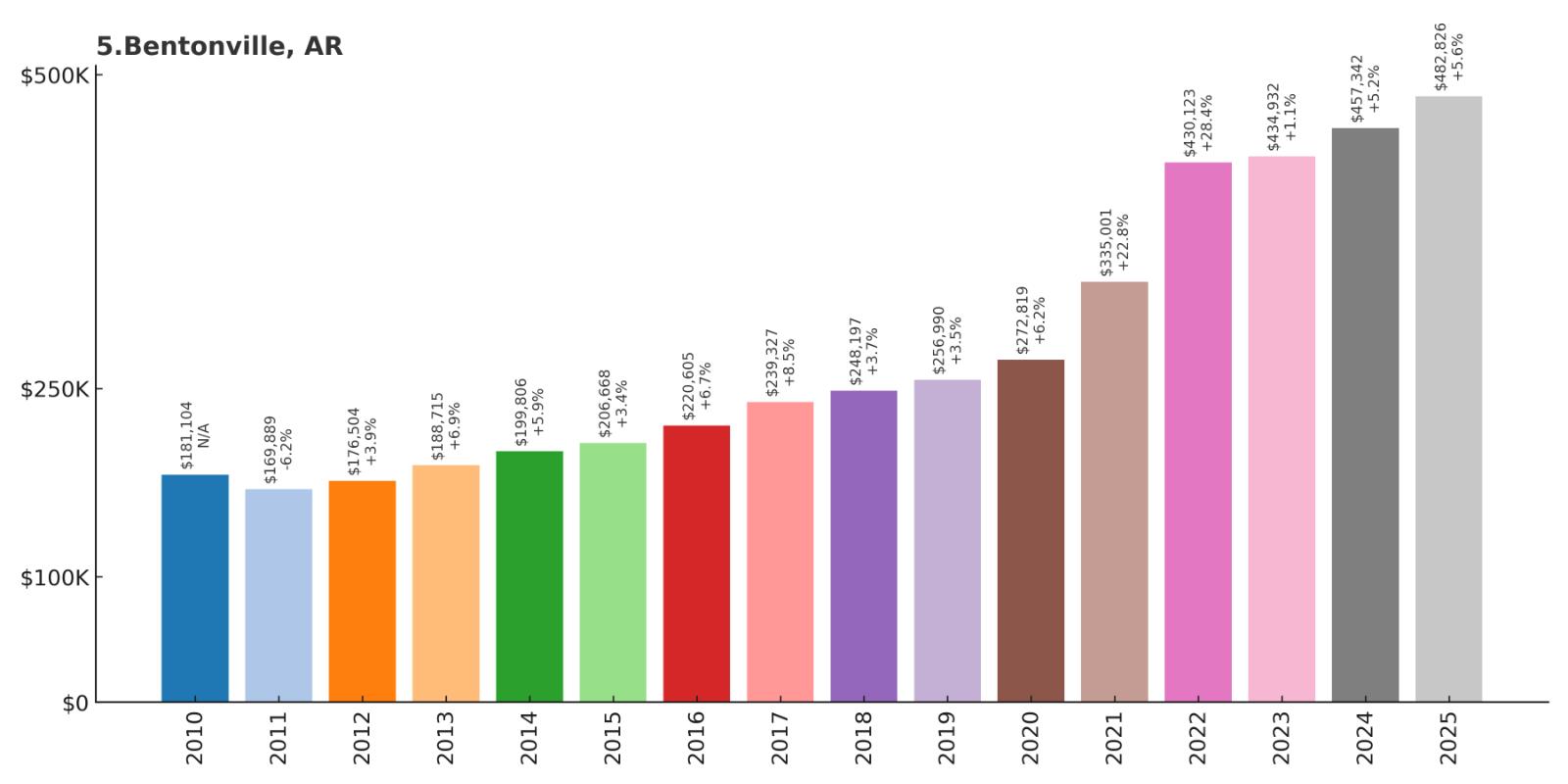
- 2010: $181,104
- 2011: $169,889
- 2012: $176,504
- 2013: $188,715
- 2014: $199,806
- 2015: $206,668
- 2016: $220,605
- 2017: $239,327
- 2018: $248,197
- 2019: $256,990
- 2020: $272,819
- 2021: $335,001
- 2022: $430,123
- 2023: $434,932
- 2024: $457,342
- 2025: $482,826
Bentonville displayed steady growth through 2020, then surged 77% between 2020 and 2025. Home values reached $482,826 by July 2025, reflecting the city’s status as Walmart’s headquarters and Northwest Arkansas’s economic center. The acceleration after 2021 demonstrates the community’s growing appeal to corporate relocations and remote workers.
Why Bentonville?
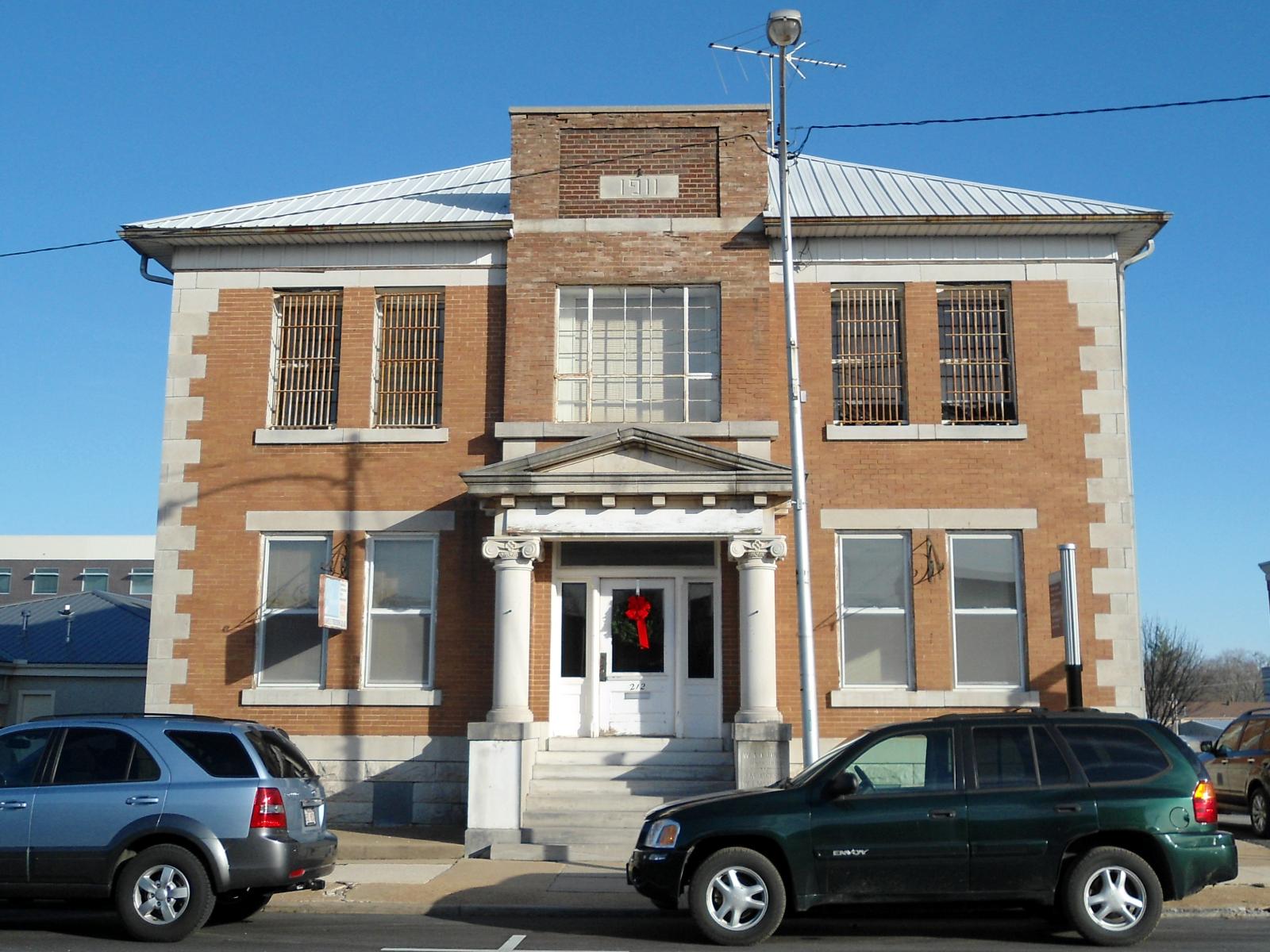
Why are people willing to pay so much to live here? What’s special about it?
Bentonville represents the crown jewel of Northwest Arkansas, combining world-class amenities with small-town charm. Home to Walmart’s global headquarters, the city offers unparalleled career opportunities alongside cultural attractions like Crystal Bridges Museum of American Art. The extensive trail system and outdoor recreation opportunities create a unique lifestyle package.
Families and professionals choose Bentonville for its excellent schools, low crime rates, and vibrant downtown area. The city’s transformation from a small Arkansas town into a cosmopolitan hub attracts residents seeking both economic opportunity and quality of life enhancements funded by Walton family investments.
How Bentonville Rose to Prominence
Bentonville’s transformation began in 1962 when Sam Walton opened his first Walmart store, forever changing this small Arkansas town’s destiny. As Walmart grew into the world’s largest retailer, Bentonville evolved into a global corporate center, attracting suppliers, consultants, and business partners from around the world.
The Walton Family Foundation’s massive investments in cultural amenities, education, and recreation elevated Bentonville’s profile far beyond its corporate identity. Projects like Crystal Bridges Museum, extensive biking trails, and the upcoming Alice L. Walton School of Medicine transformed the city into a desirable destination for professionals and families nationwide.
3 Interesting Tidbits
1. Global Headquarters – Home to Walmart’s massive corporate campus, which will expand with a new “Home Office” facility opening in 2026.
2. Cultural Capital – Features world-renowned Crystal Bridges Museum of American Art and an extensive network of mountain biking trails that have made the region a national outdoor recreation destination.
3. Population Boom – Experienced 2.7% population growth from 2022 to 2023, reaching 59,471 residents, with projections suggesting Northwest Arkansas could reach 1 million residents by 2050.
4. Little Flock – 171% Home Price Increase Since 2010
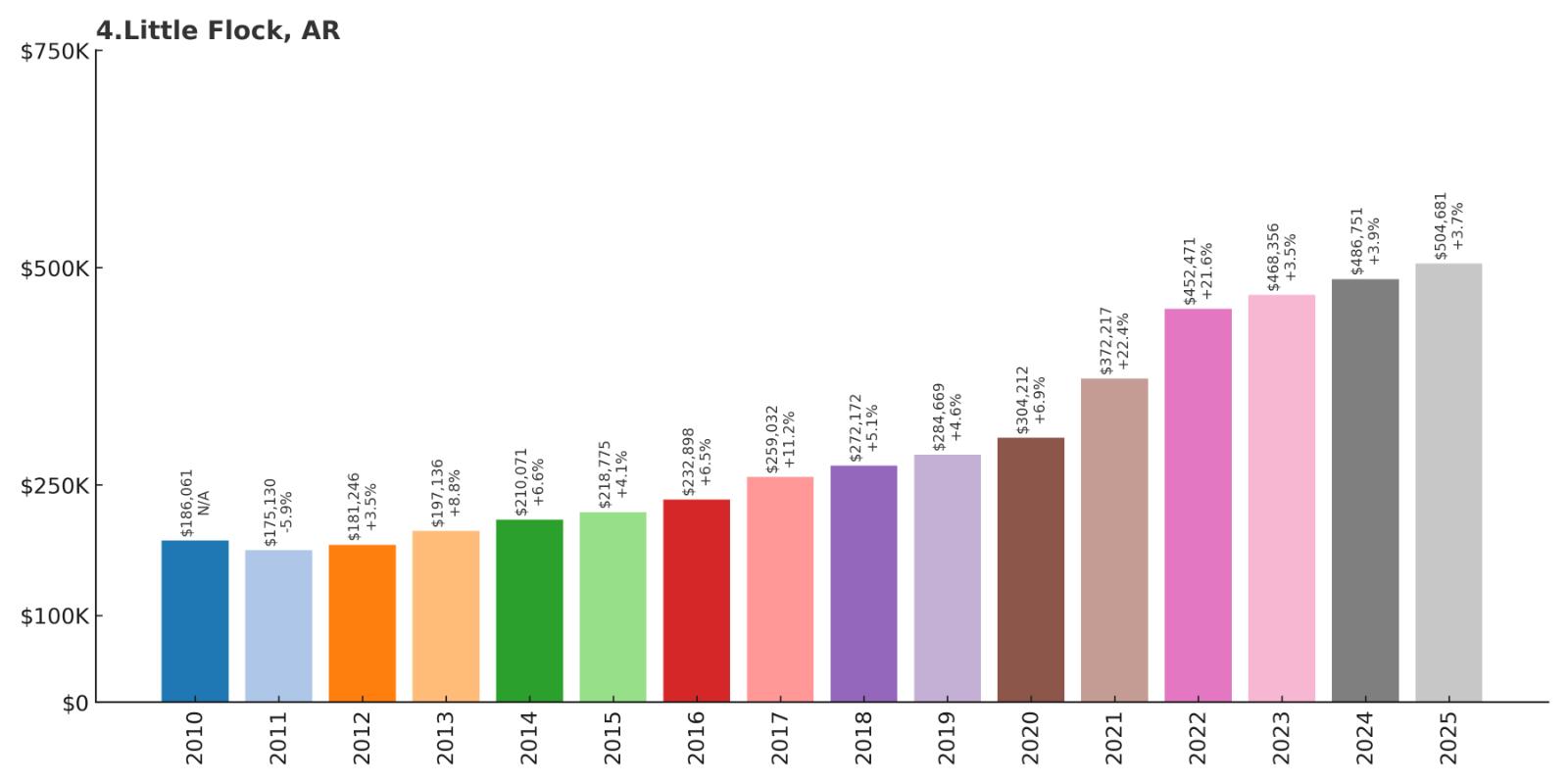
- 2010: $186,061
- 2011: $175,130
- 2012: $181,246
- 2013: $197,136
- 2014: $210,071
- 2015: $218,775
- 2016: $232,898
- 2017: $259,032
- 2018: $272,172
- 2019: $284,669
- 2020: $304,212
- 2021: $372,217
- 2022: $452,471
- 2023: $468,356
- 2024: $486,751
- 2025: $504,681
Little Flock demonstrated impressive growth consistency, nearly tripling in value since 2010. The community experienced steady appreciation through 2020, then accelerated rapidly during the pandemic years. With median home values reaching $504,681 by July 2025, Little Flock showcases the strongest percentage gains among Arkansas’s most expensive towns.
Why Little Flock?

Why are people willing to pay so much to live here? What’s special about it?
Little Flock offers residents an ideal blend of rural charm and suburban convenience within the thriving Northwest Arkansas market. The community provides larger residential lots, newer construction, and easy access to major employment centers in Bentonville and Rogers. Families value the peaceful environment combined with excellent school districts and modern amenities.
The area’s strategic location and development patterns attract professionals seeking upscale housing options without sacrificing accessibility. Little Flock’s small-town atmosphere, low crime rates, and proximity to corporate headquarters make it particularly appealing to executives and high-income families.
How Little Flock Rose to Prominence
Little Flock evolved from a small agricultural community into a sought-after residential destination as Northwest Arkansas’s economy expanded. The town’s location near major highways and employment centers positioned it perfectly to capture demand from professionals working at Walmart, Tyson Foods, and other regional corporations.
Development accelerated in the 2000s and 2010s as builders recognized the area’s potential for upscale residential projects. Little Flock’s combination of available land, scenic beauty, and proximity to job centers established it as a premier choice for families seeking luxury housing in the region’s most dynamic economic corridor.
3 Interesting Tidbits
1. Growth Leader – Achieved a remarkable 171% home price increase since 2010, among the highest appreciation rates in Arkansas.
2. Corporate Proximity – Strategically located near major Northwest Arkansas employers, making it a favored choice for executives and professionals.
3. Development Magnet – Attracted significant residential development due to available land and scenic topography, creating an upscale suburban environment.
3. Cave Springs – 139% Home Price Increase Since 2010
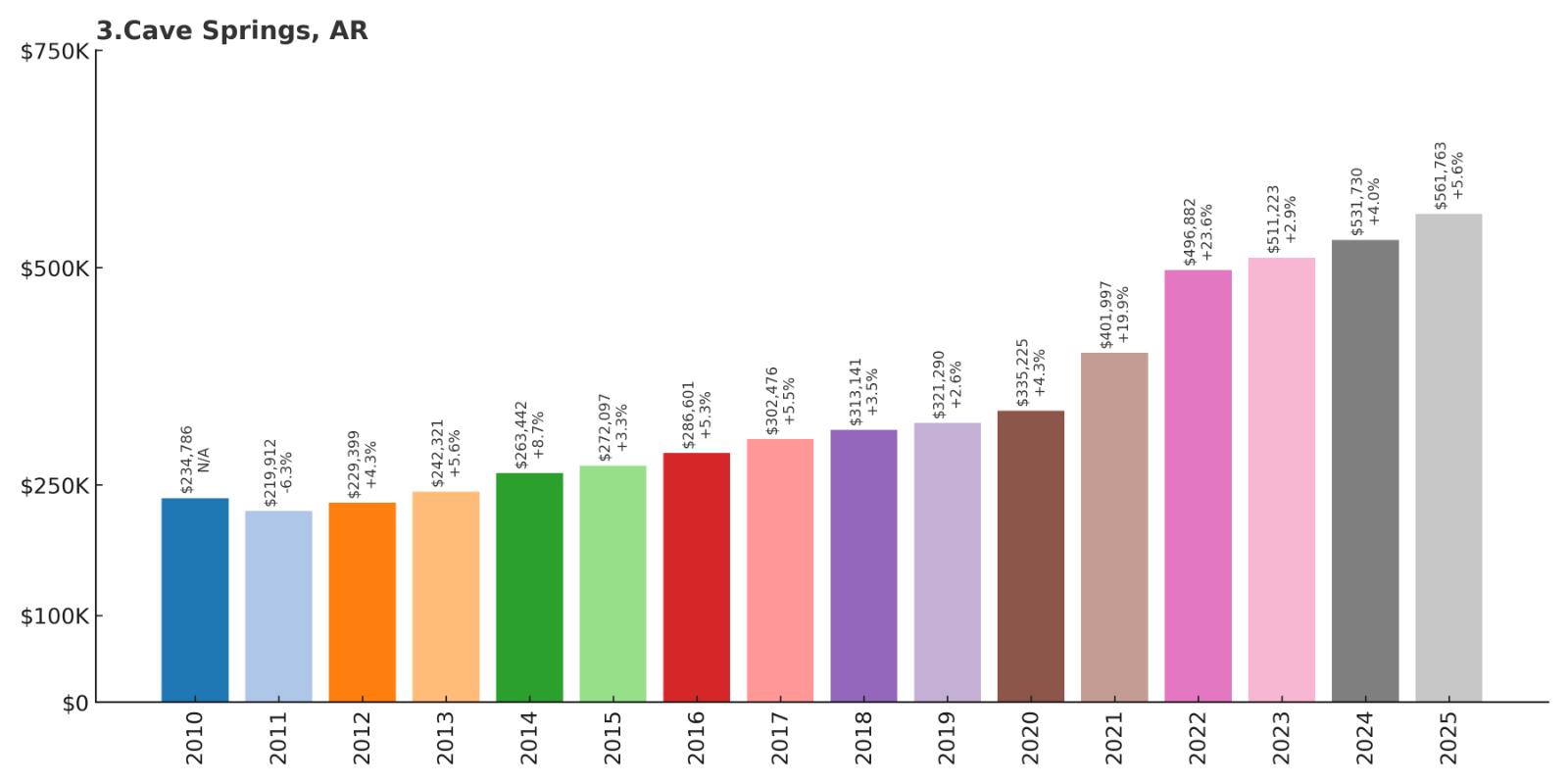
- 2010: $234,786
- 2011: $219,912
- 2012: $229,399
- 2013: $242,321
- 2014: $263,442
- 2015: $272,097
- 2016: $286,601
- 2017: $302,476
- 2018: $313,141
- 2019: $321,290
- 2020: $335,225
- 2021: $401,997
- 2022: $496,882
- 2023: $511,223
- 2024: $531,730
- 2025: $561,763
Cave Springs showed remarkable consistency through 2020, building from a strong foundation in the mid-$200,000s. Values surged 67% between 2020 and 2025, reaching $561,763 by July 2025. This acceleration reflects the community’s growing recognition as Arkansas’s wealthiest city and its appeal to high-income professionals.
Why Cave Springs?
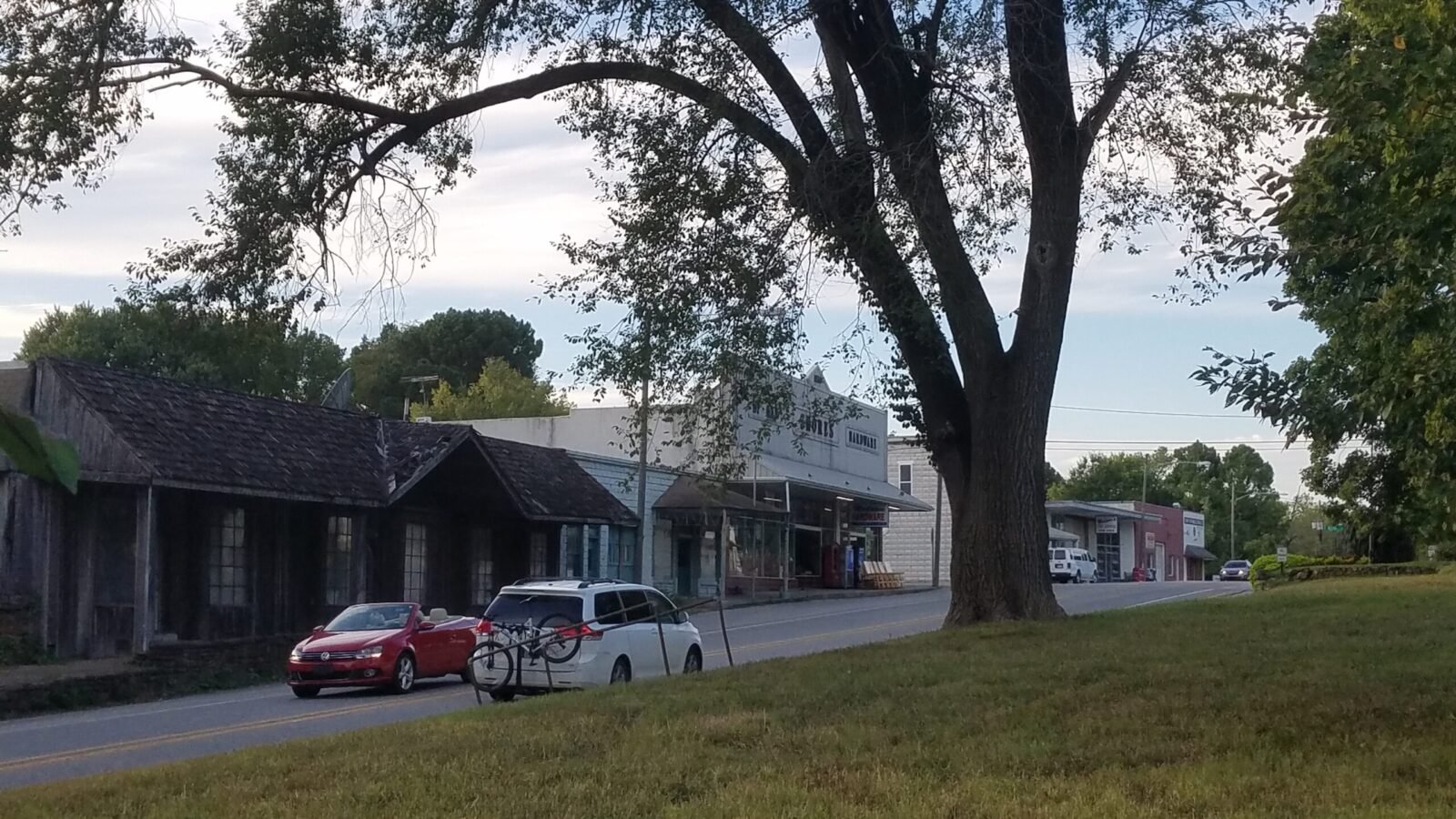
Why are people willing to pay so much to live here? What’s special about it?
Cave Springs attracts residents with its combination of rural tranquility and urban accessibility. The community offers excellent schools through the Bentonville School District, low crime rates, and proximity to Northwest Arkansas National Airport. Families appreciate the town’s small-town feel balanced with modern amenities and infrastructure.
With a median household income of $147,917 and poverty rate of just 2.6%, Cave Springs represents Arkansas’s most affluent community. The area’s 93.4% homeownership rate and strategic location between Bentonville and Fayetteville make it highly desirable for professionals seeking luxury residential options.
How Cave Springs Rose to Prominence
Cave Springs transformed from a small farming community into Arkansas’s wealthiest city through strategic positioning during Northwest Arkansas’s economic boom. The town’s location in the valley of Osage Creek, equidistant from major employment centers, made it ideal for affluent residential development. Its proximity to Northwest Arkansas National Airport enhanced its appeal to business professionals.
The community’s reputation grew as high-income residents, many connected to Walmart and other major corporations, sought exclusive residential options. Cave Springs’ careful development patterns, emphasizing larger lots and custom homes, established it as the region’s premier luxury residential destination by the 2020s.
3 Interesting Tidbits
1. Wealth Champion – Officially recognized as Arkansas’s wealthiest city, with a per capita income of $140,703 and only 2.6% poverty rate.
2. Airport Advantage – Located just minutes from Northwest Arkansas National Airport, making it highly attractive to business travelers and corporate executives.
3. Natural Heritage – Home to Lake Keith, which harbors the rare Ozark Cavefish, adding unique environmental significance to this affluent community.
2. Elm Springs – 135% Home Price Increase Since 2010

- 2010: $262,487
- 2011: $239,321
- 2012: $248,187
- 2013: $261,481
- 2014: $274,005
- 2015: $283,901
- 2016: $299,445
- 2017: $320,817
- 2018: $332,588
- 2019: $348,412
- 2020: $366,900
- 2021: $438,470
- 2022: $542,421
- 2023: $559,811
- 2024: $583,044
- 2025: $615,872
Elm Springs maintained consistent upward momentum throughout the 2010s, with values climbing from the mid-$200,000s to over $600,000. The most significant acceleration occurred after 2020, with prices jumping nearly 70% in just five years. Current median home values of $615,872 reflect strong demand in this Northwest Arkansas community.
Why Elm Springs?
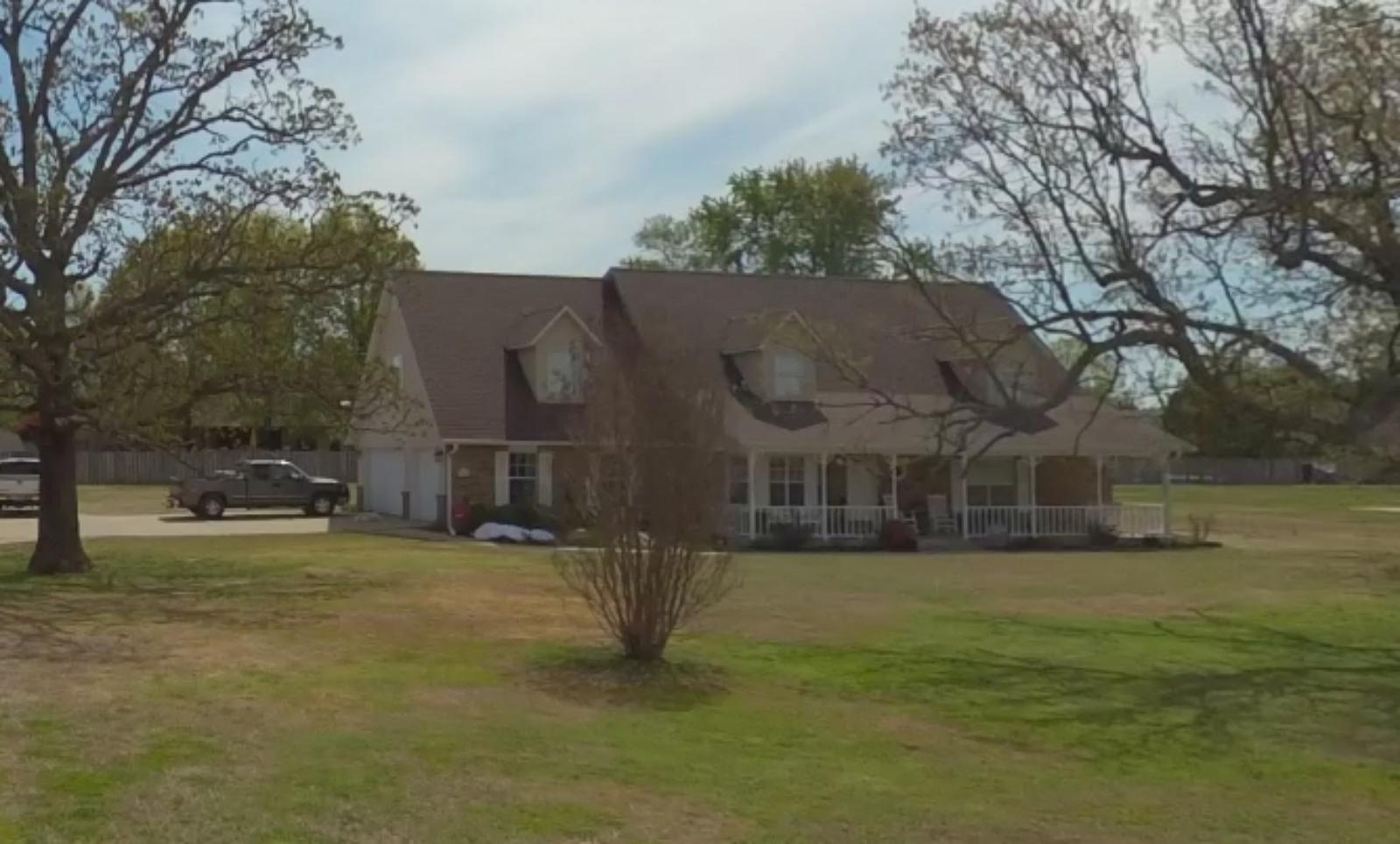
Why are people willing to pay so much to live here? What’s special about it?
Elm Springs appeals to buyers seeking privacy and space while maintaining reasonable access to Northwest Arkansas employment centers. The community offers larger residential lots and newer construction compared to more established suburban areas. Families value the small-town atmosphere combined with proximity to Fayetteville and Springdale amenities.
The area’s development pattern emphasizes quality over density, attracting professionals who want custom homes on spacious lots. Low crime rates, rural character, and easy highway access to major job centers make Elm Springs particularly attractive to commuters seeking an upscale residential environment.
How Elm Springs Rose to Prominence
Elm Springs evolved from a small agricultural community into an affluent residential enclave as Northwest Arkansas’s economy expanded. The town’s location between Fayetteville and Springdale positioned it perfectly to capture spillover demand from both cities’ growth. Its development accelerated in the 1990s and 2000s as professionals sought alternatives to denser suburban neighborhoods.
The community’s transformation paralleled the broader Northwest Arkansas boom driven by Walmart’s expansion and the University of Arkansas’s growth. Elm Springs attracted builders and buyers focused on custom homes and larger lots, establishing its reputation as a premium residential destination within the region’s expanding metropolitan area.
3 Interesting Tidbits
1. Strategic Location – Positioned perfectly between Fayetteville and Springdale, offering residents easy access to both cities’ employment and entertainment options.
2. Custom Home Haven – Known for its large lots and custom-built homes, attracting buyers seeking personalized residential experiences.
3. Rural Preservation – Maintains its small-town character despite proximity to major urban centers, balancing growth with community identity.
1. Goshen – 120% Home Price Increase Since 2010
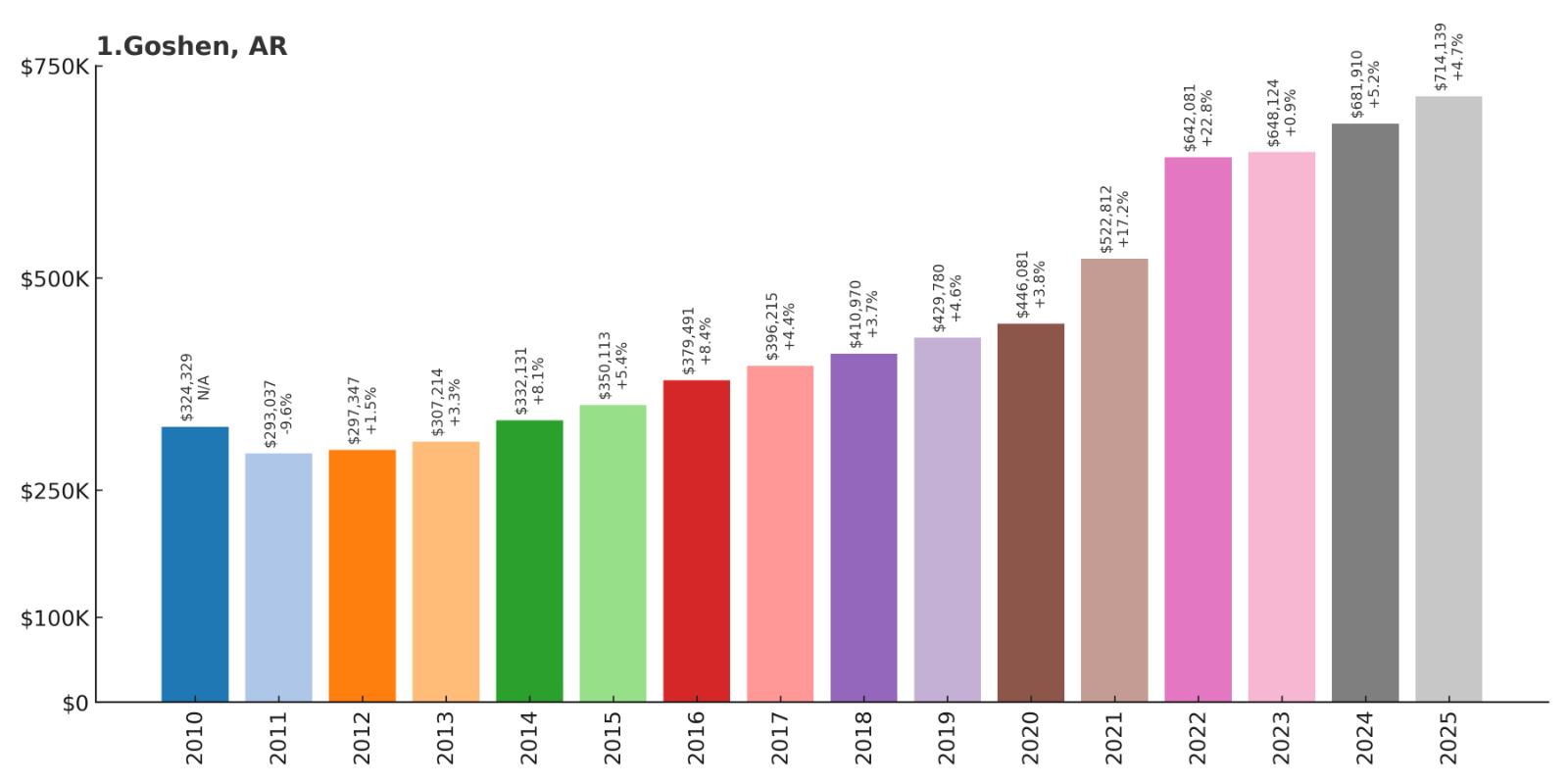
- 2010: $324,329
- 2011: $293,037
- 2012: $297,347
- 2013: $307,214
- 2014: $332,131
- 2015: $350,113
- 2016: $379,491
- 2017: $396,215
- 2018: $410,970
- 2019: $429,780
- 2020: $446,081
- 2021: $522,812
- 2022: $642,081
- 2023: $648,124
- 2024: $681,910
- 2025: $714,139
Goshen experienced steady appreciation through 2020, then accelerated dramatically during the pandemic years. Home values more than doubled since 2010, with particularly strong gains after 2021. By July 2025, median home prices reached $714,139, making it Arkansas’s most expensive town despite starting from an already elevated base.
Why Goshen?
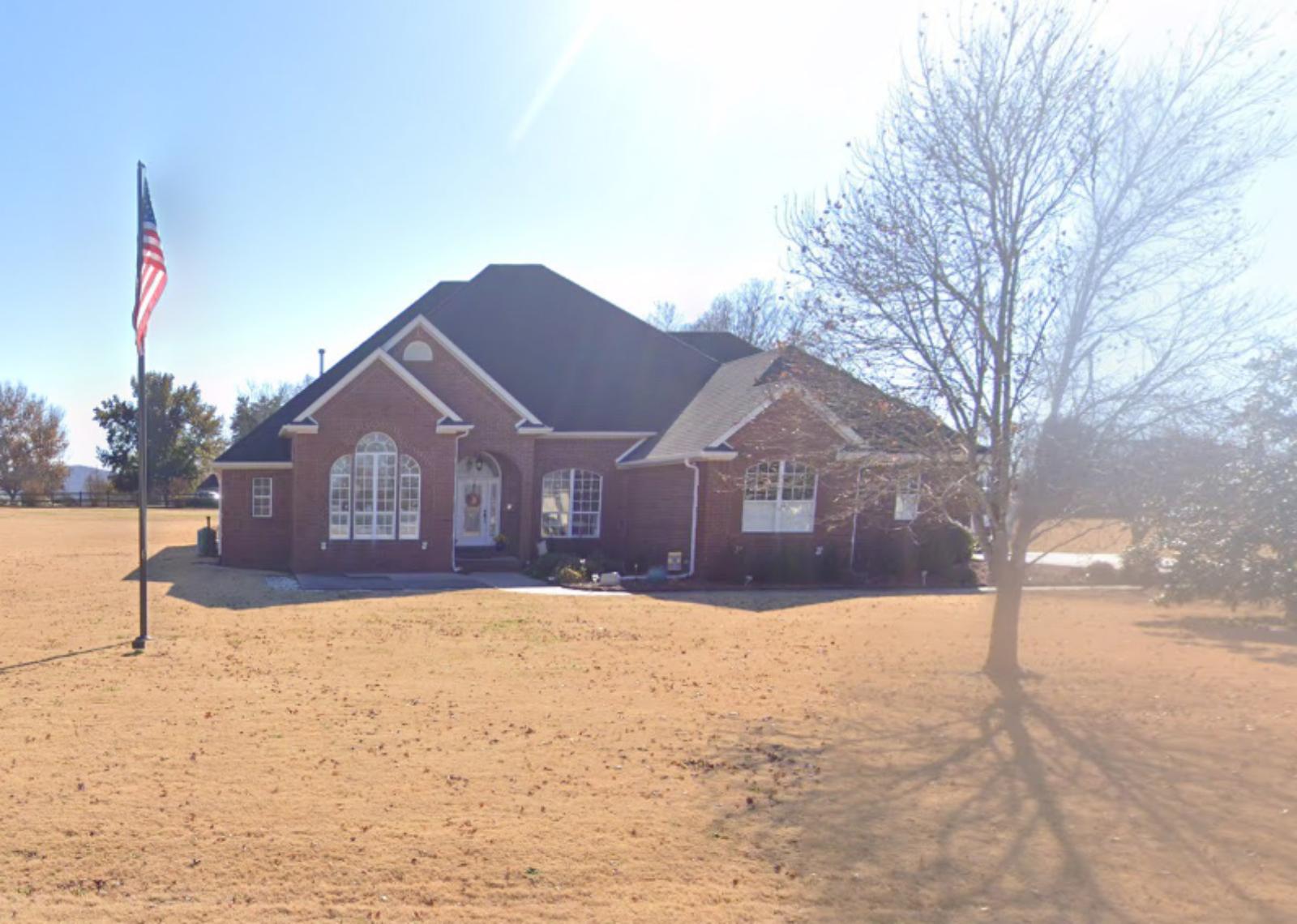
Why are people willing to pay so much to live here? What’s special about it?
Families flock to Goshen for its rare combination of rural tranquility and proximity to major employment centers. The town offers larger lots, custom-built homes, and access to highly rated Fayetteville and Springdale school districts. Its strategic location provides easy commuting to University of Arkansas jobs and Northwest Arkansas corporate headquarters.
Unlike denser suburban communities, Goshen maintains its semi-rural character while offering modern amenities and infrastructure. The area’s careful development patterns and limited commercial sprawl help preserve both property values and quality of life, attracting high-income professionals seeking space and privacy.
How Goshen Rose to Prominence
Originally settled in the 1820s-1830s and named after a Methodist campground, Goshen remained primarily agricultural until the late 20th century. The town’s transformation began as Northwest Arkansas’s economic boom attracted affluent professionals seeking residential alternatives to denser suburban areas. According to Business Insider, Goshen earned recognition as Arkansas’s “most educated” city in 2014.
The community’s proximity to the University of Arkansas and major corporate employers in Bentonville and Rogers fueled demand for upscale housing. Goshen’s incorporation as a city in 1982 coincided with Northwest Arkansas’s emergence as a major economic hub, positioning it perfectly to capture high-end residential development.
3 Interesting Tidbits
1. Wealth Capital – Goshen boasts Arkansas’s highest median household income at $177,604, with a per capita income exceeding $73,000 as of 2023.
2. Education Excellence – Residents enjoy access to both Fayetteville and Springdale school districts, two of Arkansas’s top-performing public school systems.
3. Methodist Roots – The town’s name derives from a 19th-century Methodist campground, one of six biblically-named camp meeting sites in Washington County.

